Cover Story on page 52
LOFT LIFE
A Beacon-based artist has filled her apartment with found objects and family heirlooms.

WARREN ST. REDUX
A new addition to Hudson’s main thoroughfare blends historic charm with modern efficiency.
COLD SPRING MAKEOVER
Renovating a home cobbled together over the years.
Spring 2024
HUDSON VALLEY/BERKSHIRES/CATSKILLS
ON THE Cover A Triumph of Teamwork
THE CLEMENT, BROOKS & SAFIER TEAM












Rhinebeck | Hudson | Hopewell Junction | Tannersville | Red Hook | Pleasant Valley | High Falls 845-876-WOOD | www.williamslumber.com
name you know and the name you trust
The






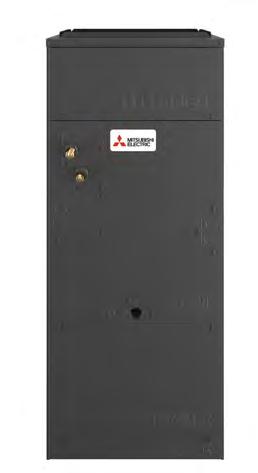
upstate HOUSE | SPRING 2024 • 1 ©2021 Mitsubishi Electric Trane HVAC US LLC. All rights reserved. Schedule a consultation today, call (845) 331-8948 or visit kingstonhws.com 2 PEARL ST, SUITE #1, KINGSTON, NY Whether it’s a ductless unit, floor unit, ceiling cassette, or air handler, heat pumps provide comfort and filtration to every room, with maximum energy efficiency. Get peace of mind with our 3-year labor, and 12-year parts warranty, plus we offer full service on everything we install. Contact us today to learn more about which heating and cooling options would work best for you and your home. Energy-Efficient, Indoor Comfort All Year Round Heat Pump Installation & Service
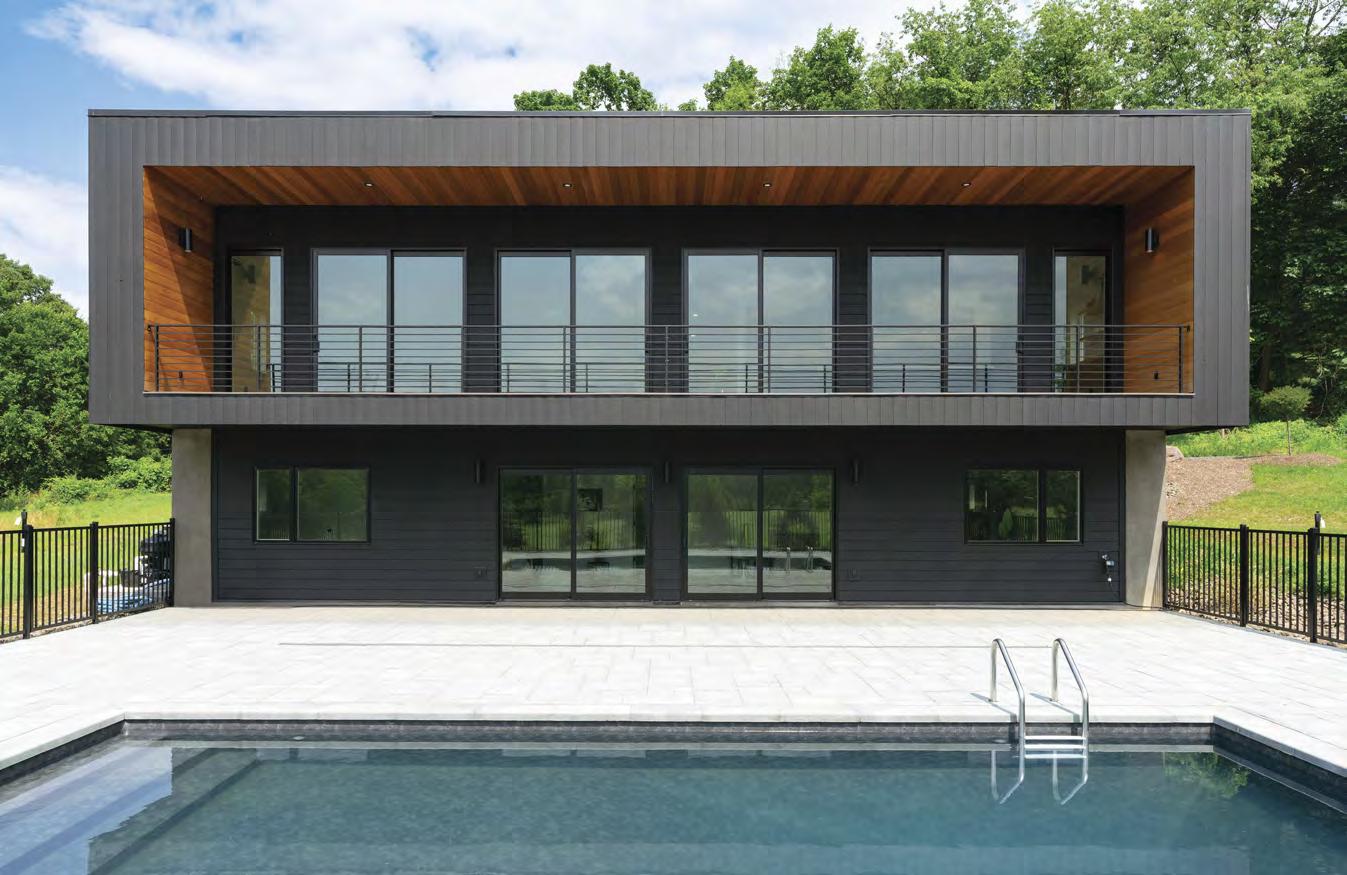



2 • online at upstatehouse.com Our philosophy is simple... create beautiful living spaces inspired by our natural surroundings. Modern Shacks designs and builds high-end, energy efficient homes and dwellings in Ulster County. Kristabelle McDermott Kristabelle@modernshacks.com 845-663-4760 ModernShacks.com



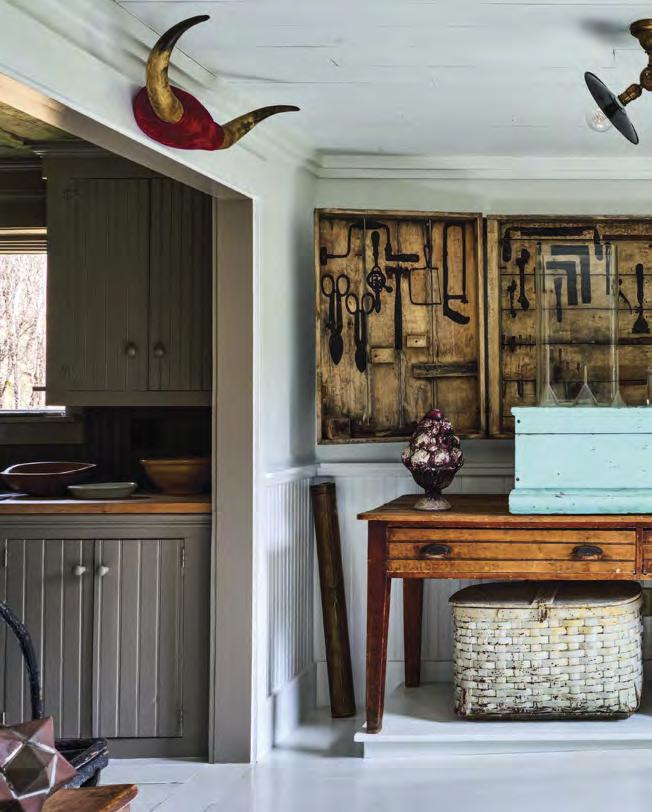

DEPARTMENTS
6 EVENT RECAP: CLEAN POWER GUIDE EXPO + INFO SESSION
Renewable-focused folks gathered in at the Fuller Building in January.
FEATURES
42 HOUSE PROFILE: WARREN STREET REDUX
By Joan Vos MacDonald
CTA Architects revamp an 18th-century townhouse, facing unexpected challenges and integrating modern sustainability. The redesigned space blends historic charm with contemporary efficiency and is Passive House certified.
52 A T RIUMPH OF TEAMWORK
The Clement, Brooks & Safier team pioneers collaborative brokerage, achieving record sales through expertise, efficiency, and community-driven values, transforming buyer-seller dynamics with personalized, seamless experiences.
Sponsored House Feature
56 R ENOVATION PROFILE: COLD SPRING MAKEOVER
By Joan Vos MacDonald
Adam and Diana Hird’s Cold Spring home undergoes a transformative renovation, solving layout woes with steel beams, crafting a spacious kitchen, maximizing views, and embracing sustainability. The result? Harmonious living and culinary bliss.
66 A PARTMENT PROFILE: LOFT LIFE IN BEACON
By Mary Angeles Armstrong
Amy Pilkington’s eclectic loft is a treasure trove of her found objects and family heirlooms. With a blend of vintage furniture and her own creations, she infuses whimsy into every corner. From her creative workspace to her cozy living area, each space tells a story of her artistic journey and personal history.
8 D ESIGN: HALLIE GOODMAN’S STORYTELLING SPACES
The Columbia County-based interior designer is having a moment
12 BOOKS: SEAN SCHERER’S VIGNETTES
Design tips from the owner of Kabinett & Kammer in Franklin
17 D ESIGN: THE BIG IMPACT OF SMALL DWELLINGS
Accessory dwelling units are an affordable housing solution.
21 H OME SERVICES: TOWARD AN ENERGY-EFFICIENT HOME
Jeff Eckes talks energy assessment with Marcy Cleveland.
27 S OURCE: CORNERS IN LIVINGSTON MANOR
David McGillvray has opened an art and design shop in Sullivan County.
30 BOOKS: BACK TO THE LAND BY PIETER ESTERSOHN
A guide to farmstead living from the renowned photographer.
32 G ARDEN: ASTROLOGICAL PLANTING
Try gardening by the phases of the moon for optimal results.
34 G ARDEN: EXPERT TIPS ON HOME GARDEN DESIGN
What to think about when you’re starting a new home garden
38 A REA SPOTLIGHT: NEWBURGH
Developments years in the works are starting to happen in the city.
40 A REA SPOTLIGHT: SAUGERTIES
This Ulster County town has a lot to celebrate in 2024.
80 B ACK PORCH: KEZUROU-KAI AT ROWAN WOODWORK
A monthly woodworking event creates community in Kingston.
78 THE MAR KET
INDEX OF ADVERTISERS / MAP OF THE REGION
4 • online at upstatehouse.com
SPRING 2024
A room created by Matt Figliola with items from Kabinett & Kammer, Sean Scherer’s shop in Franklin. Sean Scherer’s Vignettes, out in April from Vendome, offers design tips on designing vignettes for the home.
Photo by Sean Scherer BOOKS, PAGE 12 51



upstate HOUSE | SPRING 2024 • 5 Hillsdale, NY: 518.325.3131· Lakeville, CT: 860.435.2561· Millerton, NY: 518.789.3611 Hudson, NY: 518.828.9431· Chatham, NY: 518.392.9201· Sheffield, MA: 413.229.8777 herringtons.com· 800.453.1311· WINDOW & DOOR SPECIALISTS We share your passion.® BUILD FOR THE DEMANDS OF MODERN DESIGN The Marvin Signature® Modern line helps you make the most of your time and installation, with consistent profiles minimizing system alignment guesswork, pre-configured components, as well as optimal packaging and delivery. See Modern windows and doors differently at Ed Herrington, Inc. . ©2022 Marvin Lumber and Cedar Co., LLC. www.herringtons.com ULTIMATE® SLIDING FRENCH DOOR ®
Clean Power Guide Expo + Info Session for Home Energy Improvements
Upstate House in partnership with Sustainable Hudson Valley January 25 at the Fuller Building in Kingston
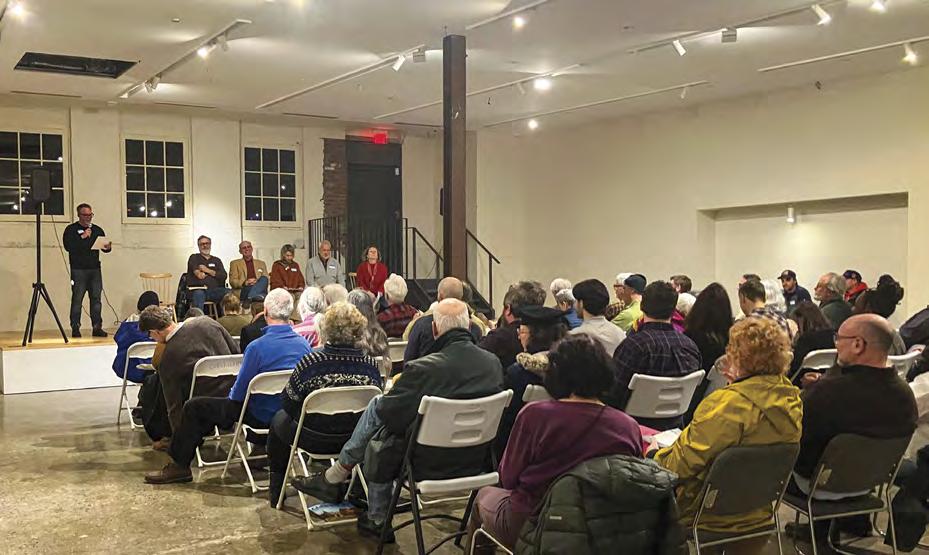
On January 25, over 100 people gathered at the Fuller Building in Kingston for the Clean Power Guide Expo + Info Session, which served as the kickoff to the 2024 Clean Power Guide, a partnership between Chronogram Media and Sustainable Hudson Valley, in the winter issue of Upstate House. The evening began with networking and the expo, which brought together a community of people who want to lessen their environmental impact by improving their homes. Attendees interacted with representatives from Hot Water Solutions, Advanced Radiant Design, Central Hudson, and Energy Conservation Services and learned about the renewable technologies available to homeowners and tenants.
The presentation portion of the evening featured a panel of local energy coaches, home energy contractors, and green real estate experts answering audience questions about how to go about making homes more comfortable, affordable, and sustainable. The panel included Marcy Cleveland, owner and operator of Green Building Specialists and founder of Hudson Valley Green Homes; Jeff Eckes, a Passive House Design/Build contractor and CEO of LDR Group; Tom Konrad, New Yorkers for Clean Power energy coach and Marbletown Environmental Conservation Commission chair; Steve Wehr, New Yorkers for Clean Power energy coach, retired IBM senior engineer, and electric vehicle
enthusiast. The discussion was moderated by Brian K. Mahoney, Chronogram Media editorial director and Melissa Everett, executive director of Sustainable Hudson Valley.
There was a lively back and forth among the panelists and the audience covering topics including home energy assessments, weatherization and electrification, electric vehicles, battery storage, things renters can do to save money and lower their footprint without too much investment in a space, and much more. The event was a resounding success, thanks to the active participation and engagement of our attendees. We learned how much goodwill and knowledge can be captured and shared in a single evening. It was a pleasure to see so many passionate individuals come together to explore ways to make a positive impact.
Thanks to all who came out to the event and to all our sponsors: Hot Water Solutions, Dandelion Energy, WaterFurnace International, Lighthouse Solar, Advanced Radiant Design, Central Hudson, and Energy Conservation Services.

EDITORIAL
EDITORIAL DIRECTOR
Brian K. Mahoney brian.mahoney@chronogram.com
CREATIVE DIRECTOR
David Clark Perry david.perry@chronogram.com
DIGITAL EDITOR
Marie Doyon
SPONSORED CONTENT EDITOR Ashleigh Lovelace
CONTRIBUTORS
Jane Anderson, Winona Barton-Ballentine, Anne Pyburn Craig, Jeff Eckes, Ryan Keegan, Jamie Larson, Joan Vos MacDonald, David McIntyre, Margaret Donsbach Tomlinson, Hannah Van Sickle
PUBLISHING
COFOUNDER & CEO
Amara Projansky COFOUNDER
Jason Stern
EXECUTIVE VICE PRESIDENT
Jan Dewey
CHAIR
David Dell
Upstate House is a project of Chronogram Media.
ADVERTISING & MARKETING
(845) 334-8600
MEDIA SPECIALISTS
Sam Brody sam.brody@chronogram.com
Kaitlyn Lelay kaitlyn.lelay@chronogram.com
Kelin Long-Gaye kelin.long-gaye@chronogram.com
Kris Schneider kristofer.schneider@chronogram.com
SALES MANAGER
Andrea Aldin andrea.aldin@chronogram.com
MARKETING
MARKETING & EVENTS MANAGER
Margot Isaacs margot.isaacs@chronogram.com
ADMINISTRATIVE
FINANCE MANAGER
Nicole Clanahan accounting@chronogram.com
PRODUCTION
PRODUCTION DIRECTOR
Kerry Tinger kerry.tinger@chronogram.com
PRODUCTION DESIGNER
Kate Brodowska
6 • online at upstatehouse.com
45 Pine Grove Avenue, Kingston, NY 12401 (845) 334-8600 | fax (845) 334-8610 All contents © Chronogram Media 2024
EVENT RECAP ChronogramMedia
The panel discussion at the Clean Power Guide Expo + Info Session at the Fuller Building on January 25. Photo by Chrisso Babcock






upstate HOUSE | SPRING 2024 • 7 Custom Designed and Crafted Timber Frame, Hybrid and Panelized Homes, Out Buildings and Commercial Structures www.davisframe.com | 800-636-0993 Vermont NatatoriumDesigned by Smith & Vansant Architects | Built by O’Hara & Gercke, Inc. | Photos by Rob Karosis Photography
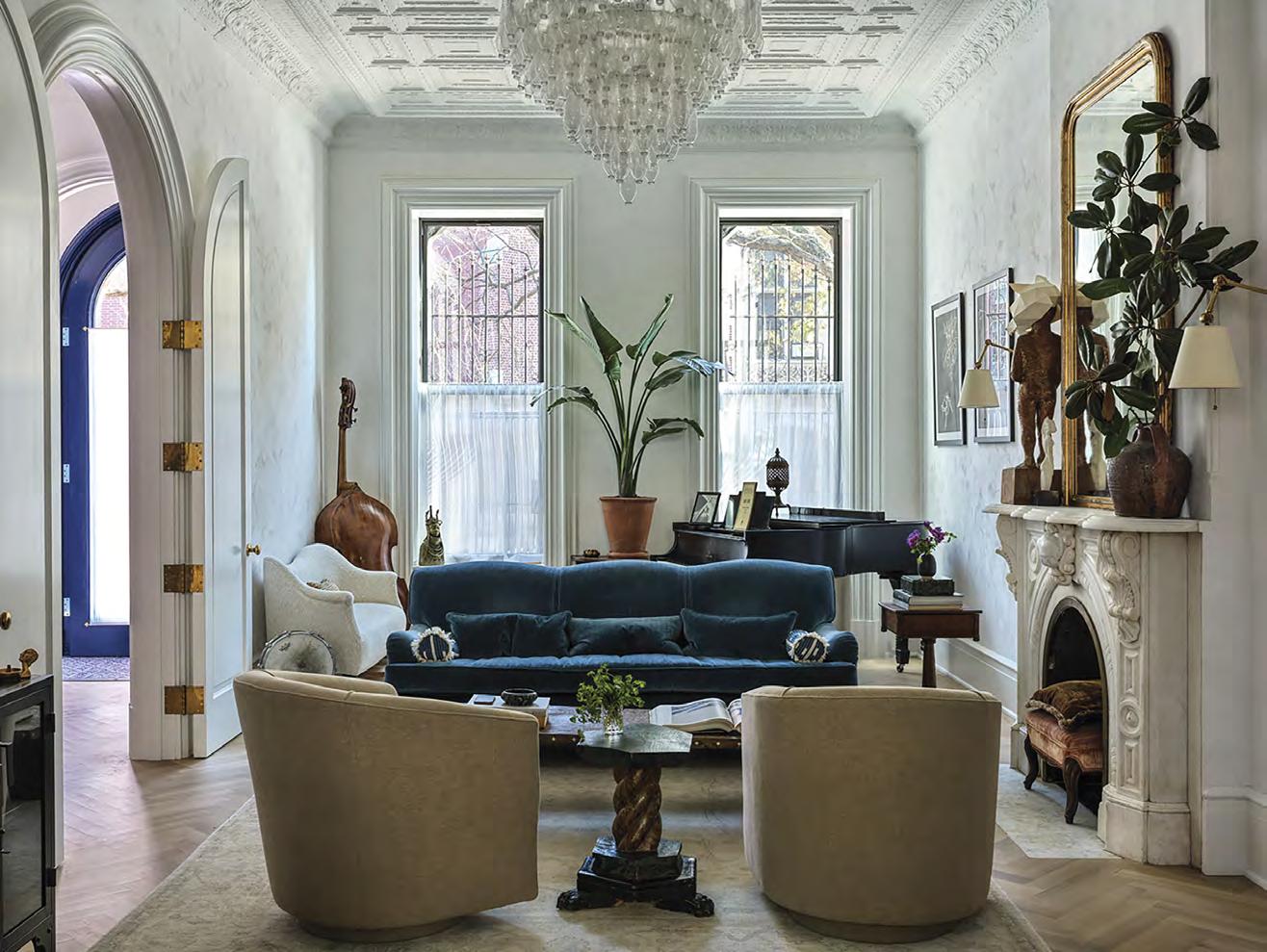
STORYTELLING SPACES THE HALLIE GOODMAN APPROACH
By Jamie Larson
Columbia County-based writer and interior designer Hallie Goodman is having a moment. A recent highprofile project, covered glowingly by Architectural Digest, has caught the attention of new clients across the country. Her draw is an intriguingly specific storyteller’s perspective, which she brings to every room she designs.
Currently, she sits behind a little marble table, tucked into a deep green corner at The Maker hotel in Hudson, back to the wall, eyes to the door. With time spent as a reporter, she still takes an interviewer’s favored position. Goodman wears a long dark coat and a big black hat. She looks the part, draped in confidence. While she’s only been designing full time for a few years, Goodman says she is self-assured in her style sensibilities because she doesn’t grasp at trends. Rather, her process reflects the crafting of a narrative, based on client character and setting.
“I started as a copy editor in LA,” Goodman says, hustling through her bio with nonchalance, mind focused on the present. “Then from there, I went to magazines. Also naming, creating, ghostwriting, reporting—absolutely every aspect of writing—and then I moved into more literary writing.”
“This is a living room for LIVING, all caps intended,” says designer Hallie Goodman.
“While everything is definitely beautiful and elegant, it’s all comfortable and nurturing first. Absolutely nothing is precious.”
The chandelier, made entirely of plastic water bottles, is by artist Willie Cole. To the classic George Smith couch, she added custom pillows made of African indigo panels, and used the raggedy weft threads as fringe. All the photos on this spread are of the redesign of Suleika Jaouad and Jon Baptiste’s Brooklyn townhouse.
8 • online at upstatehouse.com
DESIGN


While living in Hudson in the 2010s, her design business gestated. She started a popular reading series in Hudson called Volume. The regular events birthed a tight writing community of aspiring locals and accomplished authors. Off of Volume’s success Goodman also began hosting exclusive, luxurious writing getaways.
It was at one of these workshops, called Literary Alchemy, that Goodman hired bestselling author Suleika Jaouad as a presenter. Along with initiating a close friendship between the two, Goodman said Jaouad seemed to appreciate the “stagecraft” of the workshops. Jaouad asked Goodman if she’d be her design collaborator for the new Brooklyn townhouse she recently purchased with her husband, Grammy Award-winning musician, Jon Batiste. (The couple were the subject of the recently released Netflix documentary American Symphony.) Goodman’s work on the couple’s massive, multi-year project, in consort with architect Ravi Raj, was glamorously splashed across the pages of AD this past fall. It was also featured in a lively and touching video tour for the magazine’s popular YouTube channel, currently viewed over two million times.
Goodman thinks people have connected with the project because it’s so specific to Batiste and Jaouad. Rooms respect both the quiet predilections of an author and the gregariousness of a larger-than-life performer. There are touches of his New Orleans roots and her Tunisian/Swiss heritage. The inspirations blend and match (and contrast) in ways that are deeply personal and also, now, resonating in the zeitgeist of contemporary aesthetics. “It looks like the story of their lives,” Goodman says. “It just speaks to who they really are. They have joked that they should do a lifestyle brand called ‘Tunisiana.’”
While specifics of the pair’s biography are central to what’s drawn attention to Goodman’s work lately, she’s not about to replicate Tunisiana for any other client. However, the connective tissue she does bring to all her work is the same writerly attention to detail. She says she’s always looking to seamlessly stitch together the client’s life with the history and language of the home’s architecture and location.
Since the success of her AD showcase, Goodman has been snatched up for jobs in New York, DC, California and Florida, but where she says she’d really love to do more work now is
upstate HOUSE | SPRING 2024 • 9
Left: The studio lounge is equal parts comfy and vibey. The custom platform bed acts as a roomy chaise by day, but has a secret compartment to stash pillows and linens. Goodman applied the Gucci wallpaper to the room’s sconces by hand.
Right: Goodman’s design aesthetic combines elements of antique, vintage, custom, and handmade items. The iron shaving stand is early 1900s, the stool is circa 1880, and the brass accessories are MidCentury. She had the Apparatus light customized with an extra canopy and length of chain to give it drape.

here in the Hudson Valley and Berkshires.
“I loved working with Hallie on styling my house in Catskill,” says one client, who wished to remain anonymous. “She was a great communicator and always had fantastic outof-the-box ideas.”
Before leaning into decor full time, Goodman and her husband spent a decade renovating a crumbling old Hudson Colonial. It sold in a day. She felt the amount of attention that project received online provided vital experience and was a proof of concept that she could shift more focus from writing to design. She restored and modernized the aesthetic of the Hudson home while leaving its underlying details raw. That approach, she says, is the key to the contemporary “Hudson Valley look,” which she sees as being all about highlighting the authenticity of historical character with unconventional creativity and, first and foremost, story.
“My approach absolutely comes from my experience as a writer and editor,” she says. “I’m always looking critically at what I’m trying to do. So if my design concept is something like traveled elegance in a way that looks very uncontrived and natural, every single moment I’m asking editorial questions. Am I sticking to the brief? Because you can have gorgeous ideas and try to shoehorn them into a house but if it’s not super authentic to that person, you need to cut them out.”
When called for, Goodman is not afraid of texture or color. Layers of timeless furniture, dramatic lighting, unique objects, and art create a rich complexity without feeling busy. She is an expert hunter of antique stores and auctions, finding vintage accoutrements others might overlook but she uses to set a space apart.
Art is also a major focus of Goodman’s design philosophy. Whether new or repurposing an existing collection, Goodman uses painting and sculpture to add points of definition to a space.
“Traditionally a lot of interior designers get all the way through a project and then there’s no budget left for art,” she says. “For me, art is in the original plan. It has to be because the rooms wouldn’t be half of what they are without it.”
Goodman’s exacting attention to detail and innate sense of style, whether in writing or design, is finally drawing attention and recognition. As a creative being, she seems to be entering a new chapter at the height of her power. Here at The Maker, deftly slung in the corner, Goodman is in the catbird seat, catching canaries. Even so, it’s clear she’s still hungry for opportunities to prove herself, and tell more stories.
For this modernist new-build in Catskill, Goodman chose tactile materials to soften the signature “clean lines” and make the space feel more human and welcoming—an 1880s-overshot coverlet for one Mid-Century couch and caramel hued sheepskins for the other. A cheeky side table on skateboard wheels made by artist Arnaud Cornillion keeps the austere space from taking itself too seriously.
10 • online at upstatehouse.com
HALLIEGOODMAN.COM










upstate HOUSE | SPRING 2024 • 11 DESIGN + BUILD CONCIERGE — DETAILS & PRICING — Doug Maxwell real estate broker 212.518.3130 (m) | info@UpstateModernist.com www.UpstateModernist.com @UpstateModernist
Meadowlark: Quintessential Upstate retreat on 27 sprawling acres, Clinton
3,471 SF, 3 bedroom, 2.5 bath, 2 car garage, outdoor entertaining
Foxhaven: Modernist country estate on 38 stunning pastoral acres, Clinton 4,439 SF, 4 bedroom, 4 bath, 2 half baths, 2.5 car garage, heated pool
Fernwood: Modernist cabin on 5 acres, Rhinebeck
2,250 SF, 3 bedroom, 2.5 bath, 2 car garage
UPSTATE MODERN—Unique Luxury Properties CURRENT AVAILABILITIES COLLABORATION BY NEW ENERGY WORKS SCOTT COHEN | SCOTT HEMENWAY PHOTOGRAPHY 30+ Years of custom home experience –From our Employee-Owned New York studio & shop. 800.486.0661 | NEWENERGYWORKS.COM/HARMONY-HUDSON
Ledge House: Modern luxury on 9 acres, Rhinebeck 2,612 SF, 4 bedroom, 3 bath, 2 car garage

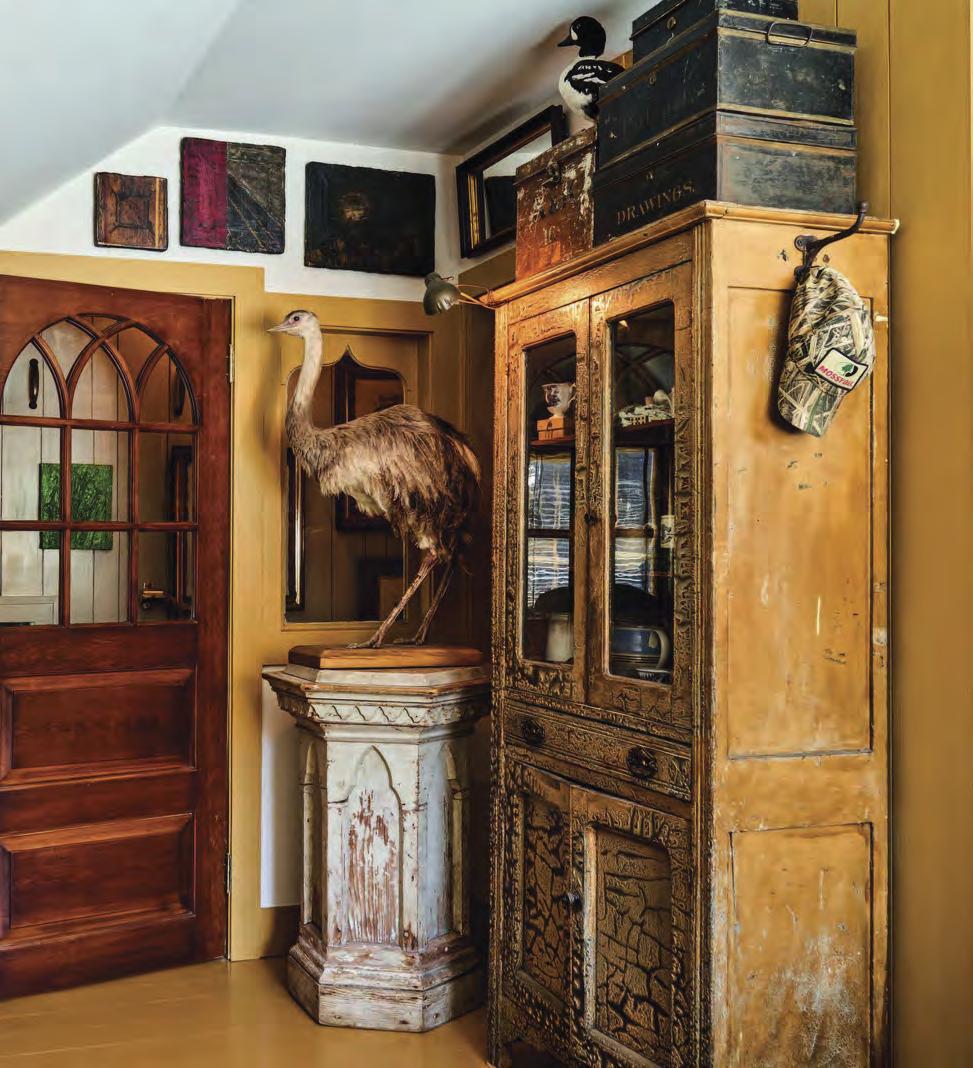
CURATED ARRANGEMENTS SEAN SCHERER’S VIGNETTES
By Jane Anderson
Photos by Sean Scherer
Designing living spaces often involves curating the placement of furniture and other large pieces. But more often, the heart of a home reveals itself in smaller objects arranged in groupings or vignettes. In his second book, Sean Scherer’s Vignettes (Vendome, April 1 publication date), artist and retailer Sean Scherer decodes the secrets to creating vignettes.
“People love to visit antique shops and look for treasures,” says Scherer, who owns the contemporary curiosity shop Kabinett & Kammer in the Delaware county village of Franklin. “But what do they do with those new finds? That’s where vignettes come in.” A vignette is simply a grouping of objects, whether they’re similar or not. According to Scherer, “Once you have more than three objects, you start arranging them, and it can happen organically and unconsciously.”
Opposite, from left:
Scherer’s
12 • online at upstatehouse.com
Above: A corner of Sean Scherer’s home office, which he created out of an unused attic space and filled with his favorite things.
The magical home of artist Peter Yokum in the French Quarter of New Orleans is full of vignettes.
homage to Joseph Cornell, whose poetic assembling of everyday objects inspires his creations.
BOOKS

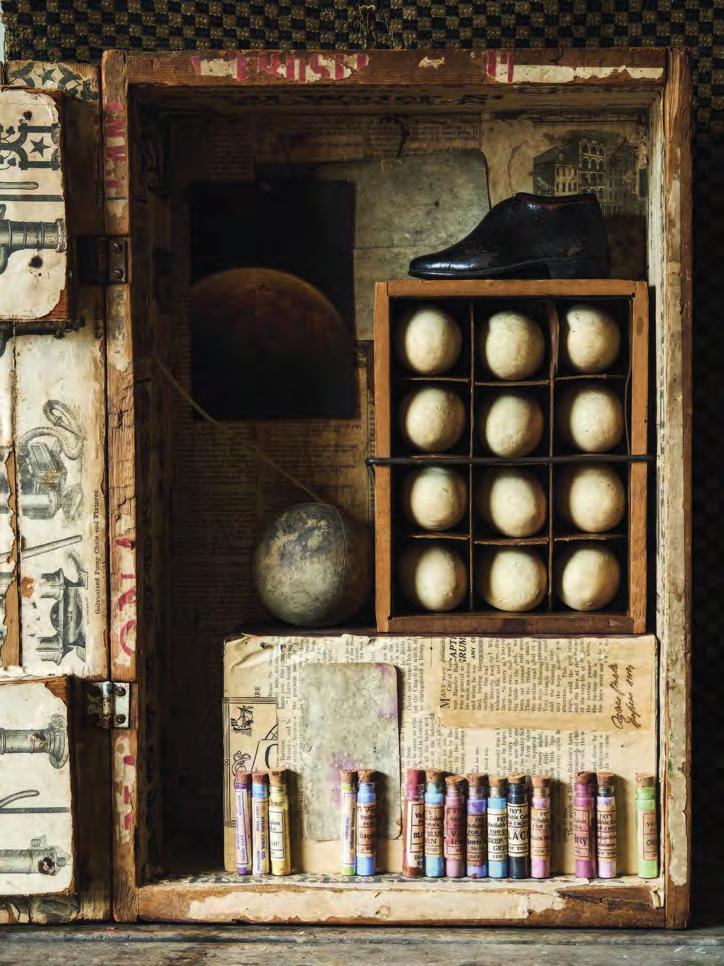
Scherer’s book breaks down the history of vignettes: They are closely related to still-lifes, where artists arrange objects and create a painting of that collection. Still-life paintings have been found in Egyptian tombs; vignettes evolved when collections and “cabinets of curiosities” became popular in late 16th-century Europe.
Vignettes are absolutely a maximalist idea, the opposite of sleek and streamlined—and collectors love that. Minimalism as a design ethos comes and goes, but vignettes remain a classic way to display treasured objects. Scherer’s embraced that philosophy since he was a young man. “First and foremost, I am an artist who loves objects,” he says. “I bought my first antique at 16. I love arranging still lifes, arranging objects, and juxtaposing. There is no hierarchy between painting and arranging still lifes.”
Nature Morte
When Vendome—who published Scherer’s first book, Sean Scherer’s Kabinett & Kammer: Creating
Authentic Interiors, in September 2020—approached him about his next book, Scherer knew just the topic. “I thought, there really isn’t a book out there about vignettes. I envisioned a beautiful art/coffee table book that’s also a useful how-to.”
Sean Scherer’s Vignettes is exactly that. Rich with images shot at his shop as well as his home and that of family and friends, the book explains the hows and whys of arranging vignettes according to an assortment of formulas. Each of the 10 chapters focuses on techniques including symmetry, asymmetry, applied arts, and the OG vignette: nature morte, or “dead nature,” the French term for still life. “I tried to make sure each image had a takeaway or a lesson in it,” Scherer says. “It falls under interior design, but really, it lands between design and an art book.”
Anything Goes with Vignettes
Indeed, one could spend hours poring over the details in the 208-page book. Vignettes of all shapes, colors, and sizes spill off the pages and imbue the
reader with ideas and inspiration. The biggest takeaway: Anything can contribute to a vignette. Seashells from your favorite destination, a branch of rosehips from the garden, a mercury glass jar handed down from an aunt—if it means something to you, it deserves to be part of a vignette, Scherer explains in the book. “You’d be surprised how much you can learn about someone from a still life or a vignette,” he writes in the introduction. Aligning a vignette with a self portrait, he reveals that a person does not need to stick to just one style: “[Vignettes] tell a story about who you are, and you don’t have to stick to one story.”
A two-page spread showcases Scherer’s own home office, which displays his favorite things. A wooden checkerboard stands behind an antique dish and a blown-glass vase next to a candlestick lamp, all assembled on top of a vintage dresser. Across the room, rustic boxes pile above a tall cabinet. The result is beautiful design, without appearing artificial. Several pages later, readers get another glimpse into
upstate HOUSE | SPRING 2024 • 13
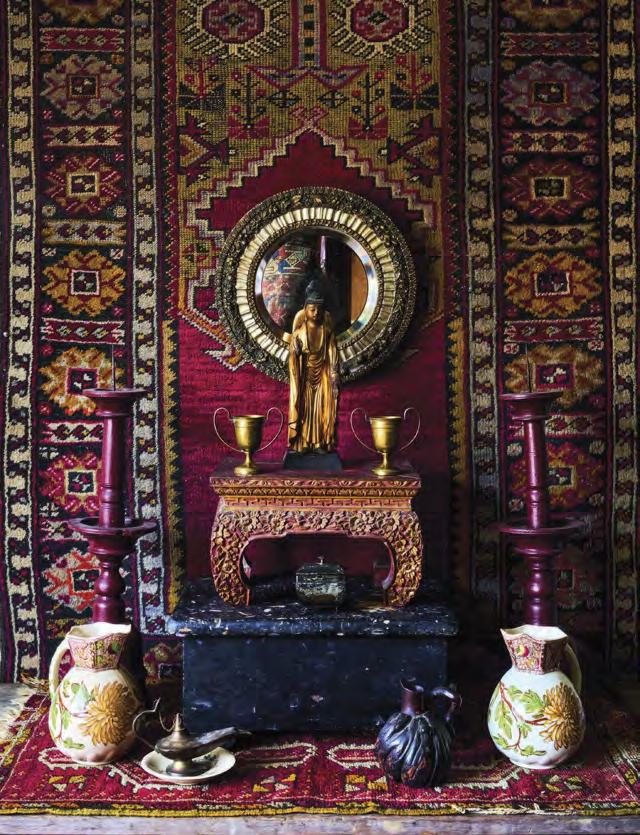

Scherer’s talents with an intricate vignette that starts on a wall with a sculpted mirror, ledges, and decorative plates, and continues onto the surface of a drop-front desk. The symmetrical placement of the objects leads the eye around the vignette. That’s an important factor to consider, Scherer stresses: “You can look at vignettes and see how it works, with eye movement, and color, and design.”
Less Can Be More
Careful to explain each technique, Scherer treats the book as a kind of reference manual for those wanting to create their own vignettes. “My intent is that readers can go back to the book for inspiration over and over again,” he says. And vignettes do not need to be over the top, he adds: “I love the ‘Pare it Down’ chapter—how to do things with fewer objects. You could honestly have a beautiful vignette with three objects.”
Plus, those objects do not need to carry the patina of age to be important. “The book’s focus is not just antiques; the lessons here are the same for things from any era,” Scherer says. In the book, he explains: “Though I am drawn to 19th-century things that show years of wear and tear, I’m a modernist at heart and do not see it as a contradiction to love both. Whether a piece dates from 1850 or 1950, if it’s good design, it’s good design. Plus, I love a good mix!”
The first step in creating a vignette is having a selection of favorite objects. Next comes the surface on which to
arrange them, whether that’s a wall for a vertical display, or horizontal surfaces like a tabletop or a stool. Once the objects are placed, Scherer encourages playing around with them and editing their placement.
Everything is a Vignette
A historian as well as a designer, Scherer has taught art history and design at SUNY Oneonta for almost two decades. In 2002, he moved to the Catskills and opened Kabinett & Kammer in 2007. “I’m a one-person operation—I buy, display, and photograph the items, and I run the store,” Scherer says. Kabinett & Kammer is housed in a 19thcentury building in Franklin, that was originally the post office and bank in town. The shop is open on weekends; Scherer’s merchandise can also be found at the Berkshire Galleries in Great Barrington, a multidealer antiques shop, which is open seven days a week. “The relationship to my being an artist and the history of vignettes and still life runs deep,” he says. “In my shop, everything is a vignette.”
That does not mean he snaps up everything he sees for his vignettes, though: “I pass up a lot of things that don’t have a Kabinet & Kammer vibe—it may have a lot of financial value, but it just doesn’t fit,” Scherer says. “Vignettes are all about what fits your personality. Vignettes tell a story about who you are. And that’s important, especially in your own home.”
KABINETTANDKAMMER.COM
Left: This altar vignette is notable for its symmetry and sense of calm.
Right: The sleeping nook in Mia Galison and Saxton Freymann’s waterside cabin in Westport Point, Massachusetts, features a grouping of butterfly and moth prints.
14 • online at upstatehouse.com


upstate HOUSE | SPRING 2024 • 15
warren, hudson, ny • the gallery at 200lex, nyc info@finchhudson.com • 518.828.3430 • @finchhudson
427















16 • online at upstatehouse.com Geothermal that works with the home you already have Experience the future of geothermal comfort. Our exclusive Double Hybrid Heat Pump (DHHP) integrates with your existing radiator, hot water baseboard, radiant floor, and forced air heating and cooling systems; offering a level of comfort and efficiency unparalleled in the region. ✔ Nearly twice as efficient as other heat pumps ✔ Can produce heating, cooling, and domestic hot water ✔ Certified by Energy Star ✔ Made in New York There has never been a better time to convert! State and Federal incentives are at their highest level in years. Contact us to learn more energycatalysttech.com 518-520-3770 Visit our New York showroom 1180 Commercial Dr. Farmington, NY 14425 585.924.9970 | pioneermillworks.com Celebrated interior designer David Senise combines elements inspired by nature to bring thoughtful sophistication and grounded aesthetics from the natural world into commercial & residential spaces. Made with our sustainability harvested FSC® Certified Casual White Oak. Find the right color for your next project. Order Samples The Natural Expressions Collection FLOORING DESIGNED WITH DAVID SENISE

Like much of the country, the housing crisis has put a squeeze on residents, new and old, in the Hudson Valley. In the last few years, a confluence of factors has pushed some municipalities like Newburgh and Kingston to go so far as to declare housing emergencies. A wave of newcomers post-COVID, the rise of short-term rentals, and persistent problems in zoning and new construction have made the prospect of renting and buying in the region unaffordable for many. The debate on how to deal with these issues rages on as multiple stakeholders, from village mayors to state officials, disagree on best practices. How do add housing to a region many move to escape the density of large urban centers?
The partial answer may lie in the backyards, basements, attics, or other auxiliary spaces of existing properties. Accessory dwelling units, or simply ADUs, add secondary units to existing housing by renovating these nooks and crannies into modest living chambers. “ADUs are one
of the fastest-growing trends in residential housing in North America. Every month it seems another municipality is attempting to pass zoning regulations to allow ADUs in their areas or is updating those already in place,” journalist and author Sheri Koones explains in her latest book, ADUs: The Perfect Housing Solution. “The growth of ADUs has been spurred on by the decline in entry-level housing options, the desire for easier access to jobs, and the increase in multigenerational living (with older and younger adults wanting to live close to family).”
Intergenerational Appeal
The underlying appeal of ADUs is a simple one; solve a housing shortage issue anywhere by building more living spaces everywhere. Sometimes called granny flats or in-law units, ADUs add to the housing supply by putting basement and garage conversions, guest houses, additional floors, and other secondary units
SMALL SPACE, BIG IMPACT THE POSSIBILITIES OF ACCESSORY DWELLING UNITS
By Dalvin Aboagye
upstate HOUSE | SPRING 2024 • 17
DESIGN
The many large triple-pane windows are excellent for energy efficiency and bring in lots of natural light to this 790-square-foot ADU in Mystic, Connecticut designed by Unity Homes
Photo by Matt Bealer
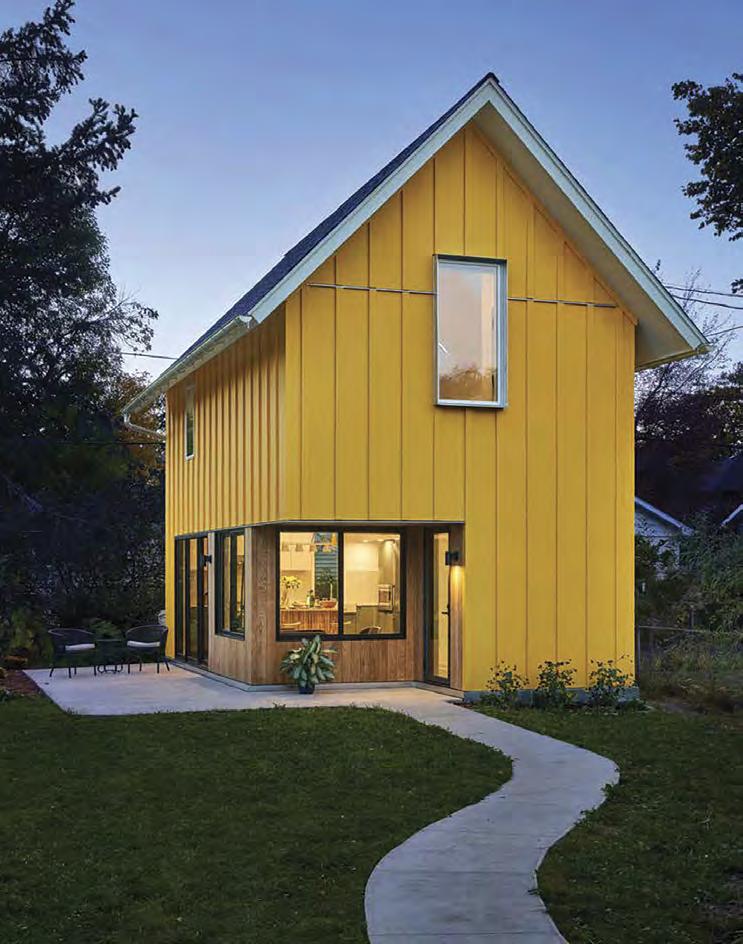
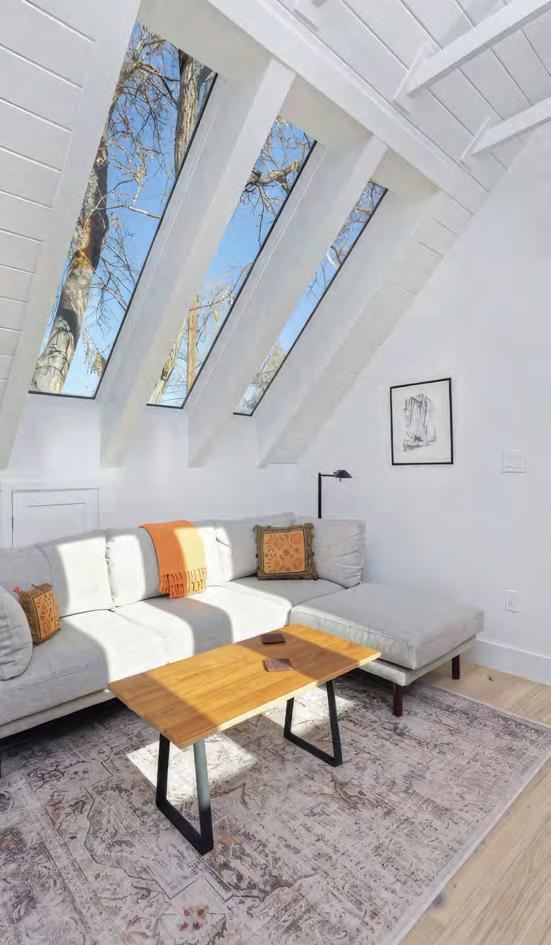
on the market for rent by property owners. They’re inconspicuous, blending into neighborhoods better than a new multiplex or other large developments, and could be invaluable tools in combating the housing crisis.
“Some homeowners are motivated to build an ADU because it can increase the value of their home by as much as 35 percent in those areas where they are zoned,” Koones writes. “An ADU provides housing for those people looking for a smaller house. Millennials in general have smaller families, so they need less space, and, being an environmentally conscious generation, they prefer to use less energy to heat and cool their homes. Boomers need less space when they are empty-nesters, and many try to reduce their expenses when they stop working.” With that kind of intergenerational appeal and versatility, it’s no wonder there are already 1.5 million ADUs in the US, and they’re growing at a rate of about nine percent a year.
Supplying Housing
In the Hudson Valley, some programs and regulatory changes aimed at making ADUs a staple of the housing landscape have popped up these last few years. Last year, a $1.75 million state grant from the
New York State Homes and Community Renewal was given to Ulster County to help build about a dozen or so code-compliant ADUs, with $125,000 being set aside for residents who are awarded funding through the Plus One Home program. And in the fall of 2022, the Beacon City Council paved the way for easier add-on unit approval and construction through new changes to the zoning code. Along with increasing the housing supply, many of these moves include provisions preventing these units from turning into short-term rentals to serve local, long-term residents.
“ADUs are adding density to communities without homeowners having to build larger homes and optimally without large multiplexes being built for additional housing in the area. Building standards for them are often stricter than for the main house, making them environmentally friendly. They provide housing for people who might not be able to otherwise live in these communities, while adding needed income for homeowners,” Koones writes in her book.
Aesthetically, the look and feel of an ADU is limited only by the architecture and construction involved. In other housing-strapped municipalities like Los Angeles, homeowners have taken full advantage of ADUs by melding modern home design
and sustainability. In one use case, the Plymouth ADU, Koones showcases how LA homeowners Leslie-Anne Huff and Reggie Panaligan expanded their living space by constructing an ADU behind their main home where a carport used to be. What they ended up with was a 370 square feet fully functional living space—equipped with a kitchen, bathroom, workspace, and loft—kept comfortable by a cool-roof system, heat pumps, and other energy-efficient products. “Throughout the ADU, every formal move and architectural element from the scale of the building to furniture and finish was designed to contribute to an atmosphere of lightness and usability without impeding circulation,” project manager Jesse Chappelle explained in the book.
On a national level, ADUs promise real change while largely maintaining the visual landscape of an area. And the popularity and intent is there. A recent survey by California homebuilding company Villa found that a fifth of homeowners added ADUs specifically to help create new affordable housing in their area. With that kind of momentum growing on a rural, suburban, and urban level, we could be that much closer to making space for everyone here and across the country.
18 • online at upstatehouse.com
A 780-square-foot ADU in St. Paul, Minnesota designed by Christopher Strom Architects.
Photo by Alyssa Lee Photography
Multiple skylights make this room in a Denver ADU designed by Simple Homes feel more spacious.
Photo by Zachary Cornwell
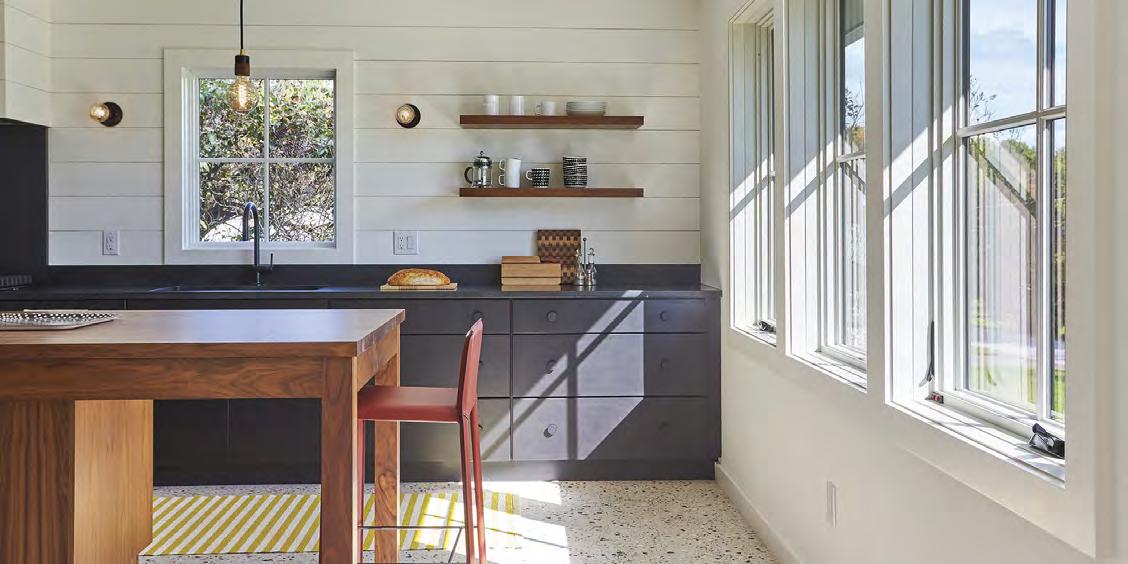

upstate HOUSE | SPRING 2024 • 19

Excellence in Roofing
Proudly serving homeowners and builders in the Hudson Valley for over 20 years.
Standing Seam Metal Roof Systems
Architectural Asphalt Shingles
Cedar Shakes & Shingles
Flat Roof Solutions
Copper Roof & Gutter Specialists
845-687-9182
SheeleyRoofing.com
HIGH FALLS, NEW YORK
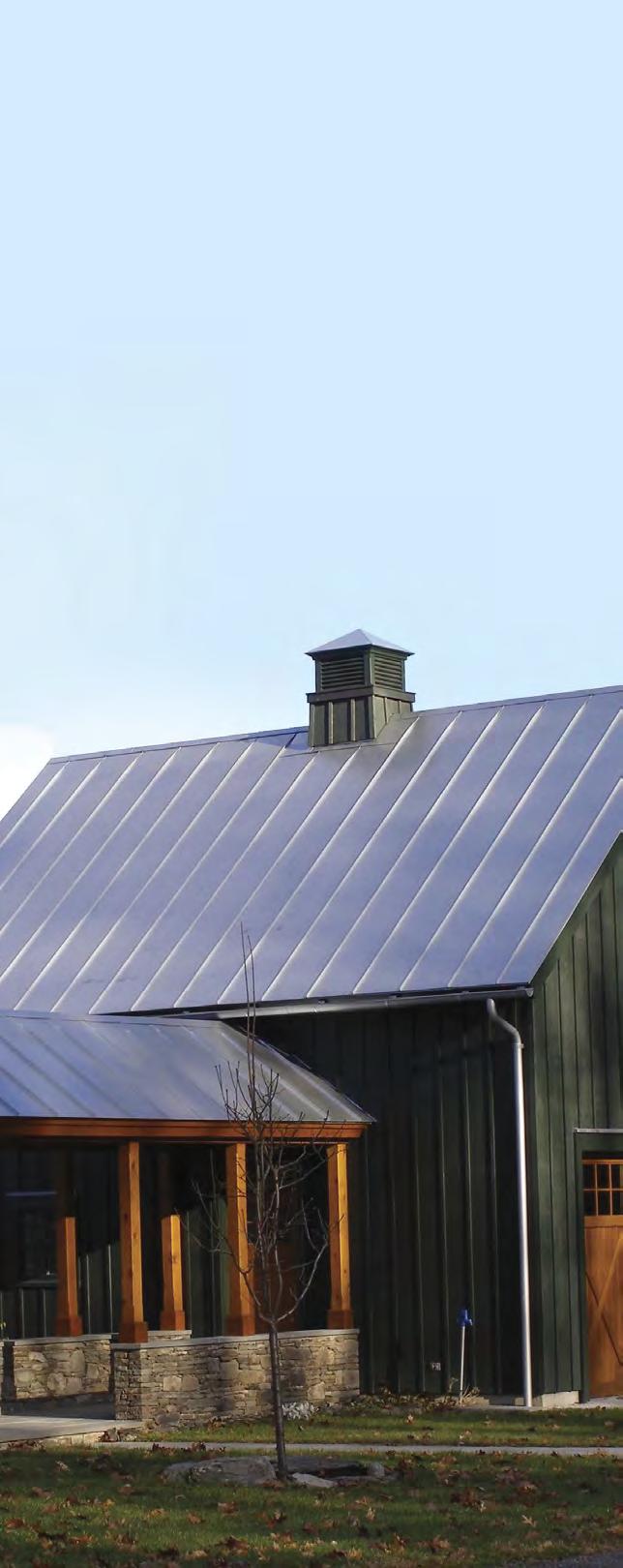

new homes professional craftsmanship
845.876.8367
handcraftedbuildersny.com handcraftedbuilders@gmail.com

20 • online at upstatehouse.com
Architectural Design: JSDnA / Frank W Chen
HA ND CRAFTED B UIL D ERS

TOWARD AN ENERGY-EFFICIENT HOME
AN ENERGY ASSESSMENT CONVERSATION WITH MARCY CLEVELAND
By Jeff Eckes
As a full-time builder, I work with many gifted professionals to deliver high performance (low-energy use) housing to our clients in the Hudson Valley. One of the most important partners I have in this are the testers and assessors of the technology we use. Testing before the work is contracted on an existing home is essential to getting the right work quoted and performed, testing after that work is done proves that the work was done to specifications.
Homeowners can enlist what is known as an “energy auditor” or assessor, the same exact testers that I use professionally, and the earlier they do that the better the outcome of any energy retrofit like insulation, air sealing, ventilation, and electrification with heat pumps for hot water and heating/AC will go. This year, with so much funding being provided by New York State and the Inflation Recovery Act, it’s even more important to have a real, tested assessment of an entire home’s energy profile.
For some testing (like Passive House and Energy Star certification), an independent certified inspector is required—in all cases it’s simply best practice. For a homeowner, it provides facts that are independent of the contractors you choose to do the work, as well as a scope of work and helps control for those times that you hire a “less-thanperfect” contractor to do the work, and the good news, a basic audit is free to all New Yorkers. Yes, that’s right, free.
For the first episode of my new podcast series, “Passive Aggressive,” I talked with Marcy Cleveland about energy audits. Cleveland is the owner and operator of Green Building Specialists, a home performance assessment company based in Pine Bush. She’s a BPI-certified building analyst and envelope professional and Department of Energy Home Energy Score Assessor, as well as a realtor with a Green Designation and Earth Advantage Broker Certification. (This interview has been edited for length.)
Jeff Eckes: I know you’re as passionate about building science and the climate and as I am, but I also understand that you have a lot of other interests. What is your number one passion right now?
Marcy Cleveland: Everything that I’ve been doing professionally is about identifying and correcting inefficiencies that I see. Those inefficiencies could be in process, it could be in design, or energy inefficiencies. It’s discovering those opportunities for betterment, and how we can do something better. How can we leverage technology to make things easier for us, how do we break down a complex subject and make it easier to understand? That kind of leads into AWE, which we’re going to talk about later.
It’s also about making improvements to your home that add value. Those improvements make
homes more comfortable, safer, healthier, and less costly to operate. They also make them more valuable, and what I’m really excited about is: How do people and the planet benefit from these improvements as well? It’s advocating for those changes, promoting these better and more efficient ways of doing things, talking to people, sharing that message, education, and community outreach. A big reward for me is just seeing how these efforts are making a difference for people. They’re happier in their homes because they’re more comfortable.
What you do each day when you go to work?
It depends on what hat I’m wearing—the energyassessment hat or my realtor hat. My day could look very different, depending on what I’m focused on
What hat do you wear the most?
Right now, it’s more the energy-assessment side of things, and I like to use the phrase “energy assessment” not “energy audit,” because “audit” has a negative connotation. An assessment is like a doctor’s checkup for your house, for both the exterior and the interior. I’m going to be looking at it and analyzing people’s utility bills, and their current mechanicals. Are they in good condition, running efficiently, how old are they, what type they are? I look at their appliances: are they old? Are
upstate HOUSE | SPRING 2024 • 21
HOME SERVICES
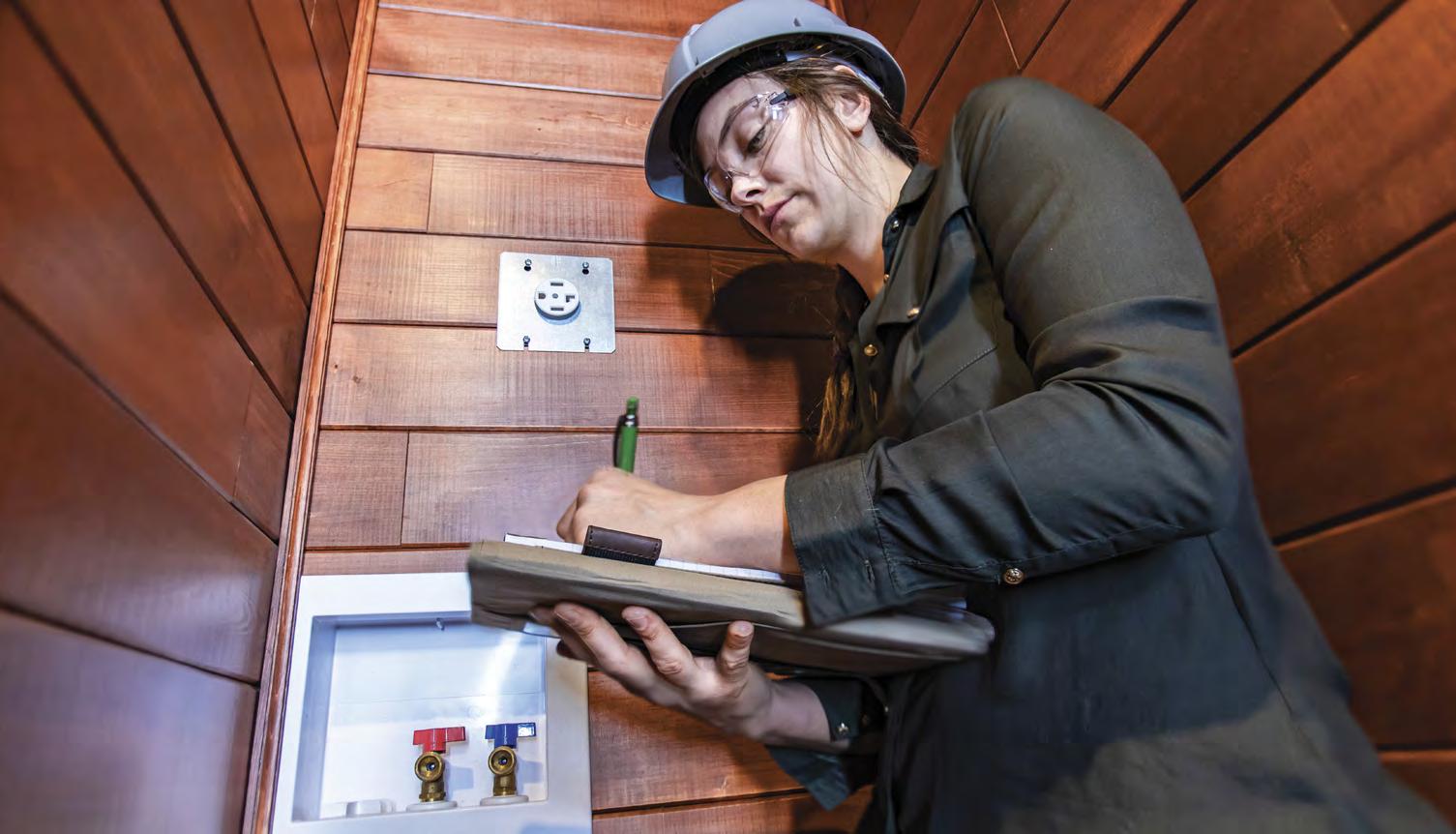
they Energy Star rated? What kind of lighting do they have? If you’re still using old incandescent light bulbs, change those out for LEDs, right now.
That’s a broad mandate, how do you acquire the expertise to be an energy assessor?
It’s education. I’ve been through more than a couple of certification courses, and I have a personal goal to get one new certification every year. I’m also not afraid to admit I don’t know something, but I’ll find the answer, and it’s going to be the right answer.
We’re blessed in this industry with a very collaborative group of experts nationwide. With a lot of big brains writing really, really good books and putting out really, really good research. Your mission is obviously green, so what’s your ultimate goal?
I suppose it’s getting the word out about energy assessments, as most important. We’re asking people to do make major changes to their homes to conserve energy, but you’ve got to get your home assessed, and this is where AWE comes in.
You mentioned that, what is AWE?
AWE: assess, weatherize, and then electrify, in that order. One thing that I do as a realtor when I’m working with buyers is to start a conversation very early on about decarbonization and electrification so that they know what they need to do after they purchase an older home. AWE is an easy acronym for people to remember how to do these upgrades,
and in what order, so they don’t make the mistake that I have seen so often; thinking they need heat pumps first, since that’s what they hear about, and getting a heat pump company that only cares about making money and feels that informing customers isn’t their job.
What a homeowner needs to do is a natural progression: Assess first and figure out where the problems are. Then weatherize, air seal, and insulate, and air sealing is really important, because insulation is just an air filter if you don’t seal first. Why would you buy a fancy heated coat, when zipping up the one you have usually shows better results? Then, and only then, electrify! That way the systems are sized for a properly sealed and weatherized home. You pay less for equipment, and for the energy to run it for the next 25 years of that equipment’s life!
Is there anything that regular homeowners can do to save money on these processes?
Yes, first, every New York homeowner and renter is entitled to a free energy audit! Get it, it literally does not pay not to. Also, once you have that assessment and have worked with the energy assessor to come up with a plan, you could help remove old insulation, and depending on your skill level, even learn how to do much of the air sealing too. Leave the final details to a weatherization expert though—they are trained to catch details that most are not. If the assessment comes back with problematic things like exposed asbestos, it’s also best to leave that to professionals.
What else do you look for?
Well, if there is natural gas or propane used in the home, we look for leaks. It’s not as unusual to find leaks as you might imagine. Also, we look at water, in all its forms. Liquid water outside, like broken gutters and leaders, can destroy a home. Excess vapor inside can accumulate on windows and walls and create favorable conditions for mold growth. Uncontrolled water of any kind is bad for a home.
Let’s talk about funding—there are a lot of incentives out there right now for this kind of upgrades, isn’t there?
Yes, quite a bit in fact. There is rebate and tax incentive money for assessments, insulation, induction stoves, heat pump water heaters, heat pump heating and air conditioning, and much more. NYSERDA is administering most of these rebates through their Clean Energy Hubs, and is a great resource for information as well. Another source is Rewiringamerica.org, which explains the subject of electrification in an easy-to-digest way.
If you had one thing that you wanted to leave readers with as important, what would it be? Get a home energy assessment if you haven’t gotten one. They’re free!
Jeff Eckes is the CEO of LDR Group, a Passive House design/build/renovate contractor located in the MidHudson Valley. His new podcast, “Passive Aggressive,” on high-performance housing technologies, is available on podcast platforms.
22 • online at upstatehouse.com






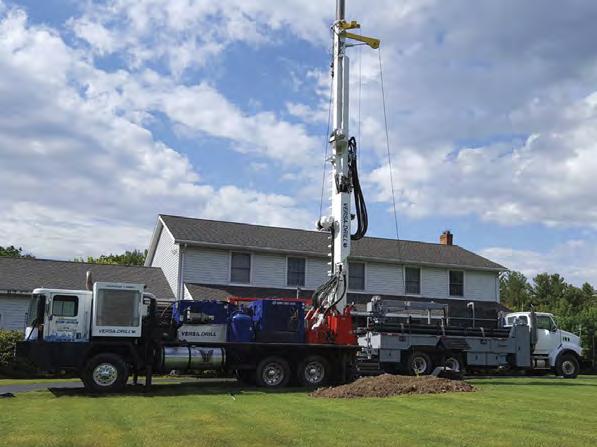







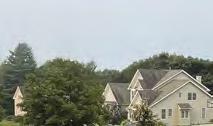









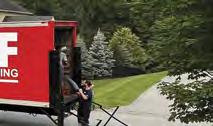
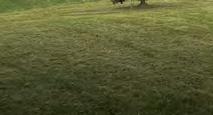





upstate HOUSE | SPRING 2024 • 23 “NO WATER” EMERGENCY SERVICE NO WATER EMERGENCY SERVICE Geothermal Well Drilling/ Water Well Drilling Well & Pump Services Filtration Installations & Service Well Inspection/Flow Test Well Chlorination/Water Testing Hand Pump Installs info@claverackpump.com www.claverackpumpservice.com 8960 NY-22 Hillsdale, NY 12529 (518) 828-6267 FREE Water Analysis PUMPS • WELL DRILLING • WATER FILTRATION Residential & Commercial Moving | Local & Long Distance Professional Packing | Storage Solutions | Family Owned Since 1924 arnoff.com | (845) 471-1504 ChronogramMedia.com/subscribe Subscribe because you still love print. Descent by Lily Morris
With


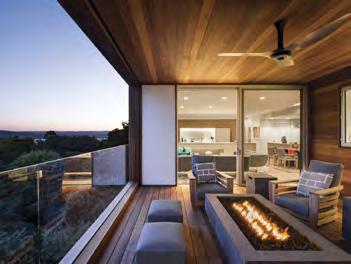
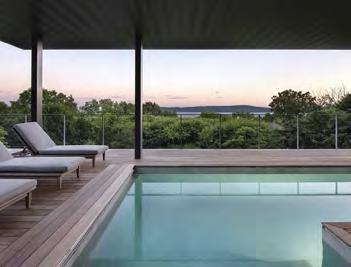

24 • online at upstatehouse.com Contact us today (845) 398-1778 173 North Route 9W CONGERS, NY 118 Rivers Bend Lane JEFFERSON, NY montanacontracting.com BUILDING HOMES OF DISTINCTION
over 40
help
by side with
the
845.265.2254 : @riverarchitects www.riverarchitects.com
years of custom home building experience, we
guide our clients through the entire process, working side
architects, engineers, and designers. Each project is pursued with
excellence and professionalism that our clients expect and deserve.
HISTORIC HOME SERVICES GUIDE
From stately stone homes to vernacular farmhouses, the architectural landscape of the Hudson Valley, Catskills, and Berkshires is defined by homes with history. Restoring these structures and bringing them up-to-date with contemporary aesthetics and energy-efficient systems takes considerable knowledge and care. Here is a list of local companies whose expertise in renovations is renowned.
HEAT PUMPS, HVAC, ELECTRICAL & PLUMBING HWS, INC.
HWS has been one of the region’s most trusted providers of clean energy heat pump installations, HVAC, electrical, and plumbing services for over 26 years. As Mitsubishi Diamond Contractors, we offer a three-year labor and 12-year parts warranty on all systems. Our highly skilled technicians will ensure your project is done right, on time, and on budget. Kingston, (845) 331-8948, Kingstonhws.com
HISTORIC REHABILITATION CONSULTING WORTH PRESERVING
Award-winning preservationist Kate Wood partners with homeowners, design professionals, and trades to unlock the potential of historic properties, applying decades of hands-on experience in advocacy, strategic planning, and project management. @worthpreserving, Worthpreserving.com
WOOD FLOORING PIONEER MILLWORKS
Pioneer Millworks’ reclaimed and sustainable wood flooring, siding, paneling, and decking have been a favorite option for homeowners and builders in upstate New York for over 30 years, and are manufactured right here in the USA in their employee-owned, New York mill.
1180 Commercial Drive, Farmington, (585) 924-3860 Pioneermillworks.com




SPONSORED



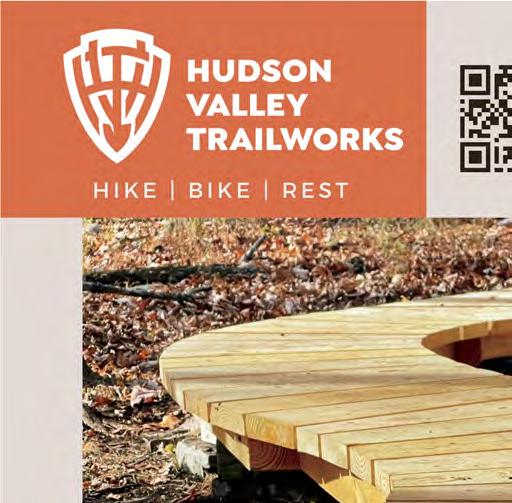






26 • online at upstatehouse.com

What do framed art, imported stationery, art books, and design magazines all have in common? If you ask graphic designer David McGillivray who needed a name for his new art and design store—the answer is simple: corners. “I was looking at our initial product selection, and I thought, ‘Everything’s a rectangle,’” says McGillivray. “And the name ‘Corners’ popped into my head.” Located in downtown Livingston Manor, Corners offers an eclectic and curated mix of artwork from local and international artists.
Before launching the store, McGillivray— cofounder of the loungewear brand Offhours had been splitting time between Brooklyn and the Catskills for several years. He and his wife, Rebecca Zhou—founder of skincare brand Soft Services—were especially drawn to Livingston Manor. “It was a town that had a lot of new energy constantly flowing through it,” says
McGillivray. The couple bought a house in the hamlet in 2017 and made it their full-time residence earlier this year.
McGillivray had a longstanding dream of opening an art and design boutique, and he saw an opportunity when a retail space on Main Street became available. “I had my eye on it for years,” he says. “There’s nothing else like it.” Originally built in 1956, the midcentury modern building that now houses Corners stands out for its angular front facade of aluminum-framed square panel windows. Its other architectural features include a wall-to-wall concrete floor, metal doors, and a floor level a foot above historic flooding levels. “It’s built like a fortress,” says McGillivray. “The space was originally built by an insurance agent, who was tuned into high tech and future-facing construction methods. It was built thoughtfully and built for the era.”
CORNERS
LIVINGSTON MANOR’S NEW ART AND DESIGN STORE
By Ryan Keegan
upstate HOUSE | SPRING 2024 • 27
THE SOURCE
Originally built in 1956, the Mid-Century Modern building that now houses Corners stands out for its angular front facade of aluminum-framed square panel windows. Its other architectural features include wall-to-wall concrete floor, metal doors, and a floor level a foot above historic flooding levels.
Photo by Noah Kalina
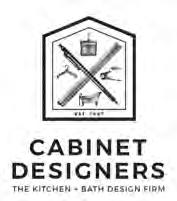
WE IMPROVE OUR CLIENTS' LIVES BY IMPROVING THEIR LIVING SPACES
New in 2024!
We are thrilled to announce that we have expanded our service offerings and are now able to assist our clients in designing their outdoor kitchens


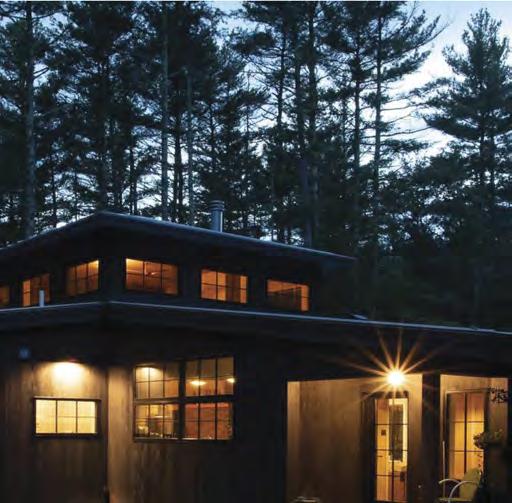



28 • online at upstatehouse.com
hoto Credit

Enticed by the space, McGillivray sought to define his store’s concept. He settled on providing ready-to-hang, approachable art. “I have so many friends who’ve got poster tubes in their houses or apartments,” says McGillivray. “When you finally decide to frame those, you take it to the framer and discover that it would cost 20 times more to get it framed than the actual cost of the art. I wanted to sidestep that entire idea and present an accessible selection of art that is ready to put on your wall.”
With that concept in mind, McGillivray secured the building and collaborated with architect Michael Groth to renovate the space. That meant installing new drywall, removing an internal wall, and refinishing surfaces. The concrete floors were ground down to reveal the aggregate, and white oak was used throughout to complement the building’s original design. In the middle of the space is a solid white slab table held up by two locally sourced objects: a 600-pound river rock on one end and steel I-beams on the other. “A customer came in the other day and described the space as monastic,” says McGillivray. “It was nice for me to hear, because this
is a place devoted to art and design. There’s a sense of reverence I wanted it to have.”
Corners opened on Labor Day weekend, and McGillivray is confident that the price range reflects his goal of making framed art accessible. Corners’ framed art collection includes vintage prints from iconic artists of the `70s, supervised by their estates and framed in solid wood, priced at a few hundred dollars. On sale now is a 1972 authorized reproduction of Joan Miró’s Personnage au Soleil Rouge I, framed in white oak for $500. On the other end of the price spectrum are higher-end art pieces, such as larger, one-of-a-kind works from local artists priced in the $1,000-range like New York sculptor Patrick Kim’s exclusive collection of Catskills black walnut and cherry carved pieces.
Rather than using a specific process, McGillivray’s curation is totally organic. “The art comes from all over,” says McGillivray. “Sometimes directly from artists, from auctions—like an Ellsworth Kelly print from an auction in Paris—or even vintage prints from a dealer in Florida. There are other works that ship in from artists all over the world. Sometimes,
customers just come in and recommend things.”
Some of Corners’ other products include a selection of internationally imported stationery, and a range of multifunction pens from Germany and Japan. There are also a rotating section at the front of the store, which currently has products from the Italian brand Alessi, like a lemon squeezer and a three-cup espresso maker. “There are already a lot of great places in the Catskills that really focus on local craftspeople and art,” says McGillivray. “Since that side of things is covered, Corners has a really international flavor. I have a small magazine selection, and people would come in and say, ‘I love this; you can’t get it anywhere up here.’ That’s a common reaction for people who come into the store.”
“In a way, I feel like an international selection does justice to Livingston Manor,” says McGillivray. “It reflects all the amazing things going on. We’re not just some local town. I meet so many amazing people—artists, designers, and architects. It’s an increasingly international place.”
CORNERSNEWYORK.CO
upstate HOUSE | SPRING 2024 • 29
Graphic designer David McGillvray had a longstanding dream of opening an art and design boutique, and he saw an opportunity when a retail space in Livingston Manor became available.
Photo by Michael Groth

30 • online at upstatehouse.com
Josh Morgenthau on a tractor at Fishkill Farm. The 270acre apple orchard, CSA, cidery, and vegetable farm in Hopewell Junction he inherited from his father was established in 1913 by his grandfather, a gentleman farmer, and was originally part of a much larger farm.

Pieter Estersohn’s newest book, Back to the Land (Rizzoli) introduces the reader to 35 quirky Hudson Valley farmers (and others who tend our local foodscape), many of whom the readers of this magazine may already be friends and neighbors with, in a beautifully shot coffee table book of idyllic rural landscapes, dreamy country interiors, and arresting portraits.
Estersohn is a relative newcomer to the local life. His remarkable photojournalism career had him based in New York City since the age of 19 when he worked for Interview magazine, later traveling the world shooting the grandest homes for Architectural Digest, Elle Decor and others. More recently he renovated his own Hudson Valley Greek revival home with his son Elio, and documented the region through his historyinspired 2018 book Life Along the Hudson: The Historic Country Estates of the Livingston Family. Now he turns his camera to more pastoral themes: His photos of the land are tremendous and span the seasons; images
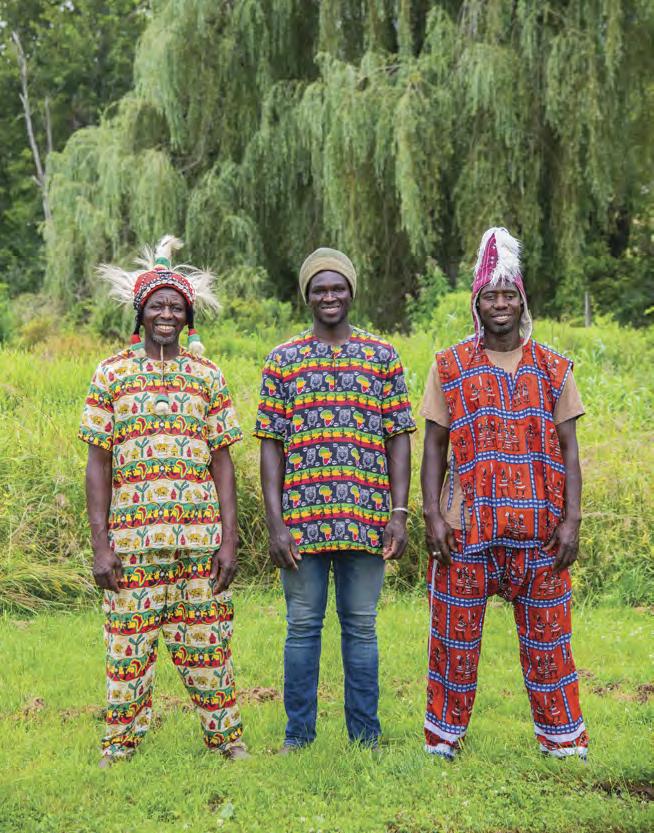
of farm houses and outbuildings reflect his stylish architectural eye for both structure and detail; and his photographs of those tending the farms show his admiration of their resilience and independence. We share three portraits here.
The full name of the book—Back to the Land: A New Way of Life in the Country: Foraging, Cheesemaking, Beekeeping, Syrup Tapping, Beer Brewing, Orchard Tending, Vegetable Gardening, and Ecological Farming in the Hudson River Valley—gives a good glimpse into the scope of its contents, and indeed it’s not “just” a photo book. Estersohn has written a love letter to what he calls “the new generation of independent farmers,” both generally and specifically, in 35 ways, one for each of his subjects. The last pages of the book contain a section dedicated to “Agritourism” comprising listings of farmers’ markets, restaurants, and other farming resources in the region. Back to the Land lovingly documents this moment in the long history of a very fertile region, once known as the bread basket of New York.
TO THE PEOPLE OF THE LAND PIETER ESTERSOHN’S PORTRAITS OF HUDSON VALLEY FARMERS
By Amara Projansky
Photos by Pieter Estersohn
upstate HOUSE | SPRING 2024 • 31
BOOKS
From left: Sarah Chase is part of the third generation to run Chaseholm Farms dairy and creamery. She is pictured in front of the barn complex where they bottle milk and cream in glass, and produce awardwinning cheeses with the milk from 33 grass-fed cows on over 300 acres in Pine Plains.
Nfamara Badjie and his son Malick, originally from Gambia, and Moustapha Diedhiou, originally from Senegal, are musicians and co-founders of Ever-Growing Family Farm in Kerhonkson, one of the only commercial rice farms in our region.
GARDENING BY THE MOON AND ZODIAC ASTROLOGICAL PLANTING 101
By Margaret Donsbach Tomlinson

Agarden often flourishes in its first year. Later, after pests discover it and soil nutrients become depleted, the same garden may decline despite being cared for just as diligently. This can be frustrating for gardeners, to say the least. Of course, following standard good gardening practices is all-important in keeping a garden healthy. In addition, timing gardening activities to the moon’s phases and its position in the zodiac can give a garden a significant boost.
Moon Phase 1: Leafy Crops and Ornamentals
When the moon is waxing from new to half is the best time to plant leafy crops like lettuce, spinach, and cabbage, which thrive under this influence. It’s also wonderful for ornamentals with showy leaves like coleus, dusty miller, and purple basil.
Moon Phase 2: Flowering and Fruiting Annuals
When the moon is waxing from half to full is the time to plant flowering and fruiting annuals. Vegetable crops like beans, corn, tomatoes and squash produce well when planted in this phase. Flowering plants started now will bloom more abundantly.
Moon Phase 3: Root Crops and Perennials
When the moon is waning from full to half, plant root crops, perennials, trees, and shrubs. Onions, potatoes, beets, and other root vegetables grow well when started during this phase. Hardy perennials, trees, and shrubs planted now develop extra strength in their root systems for overwintering and supporting a vigorous flush of growth in spring.
Moon Phase 4: Weeding
The phase when the moon is waning from half to new is considered barren. Anything planted now may fail to thrive. This is the best time, though, to discourage pests by scattering slug bait or using organic sprays like neem oil. It’s also fantastic for weeding. Many upstate gardens have heavy clay soil that makes it a struggle to dig out weeds with deep tap roots, like dandelions. But during the moon’s last phase, weeds release from the soil more easily, especially if the moon is also in a barren zodiac sign.
Fruitful or Barren?
Every zodiac sign is classified as either fruitful or barren. The most barren signs are the fire signs: Aries, Leo, and Sagittarius. The air signs— Gemini, Libra, and Aquarius—are also considered barren. Planting
32 • online at upstatehouse.com GARDEN
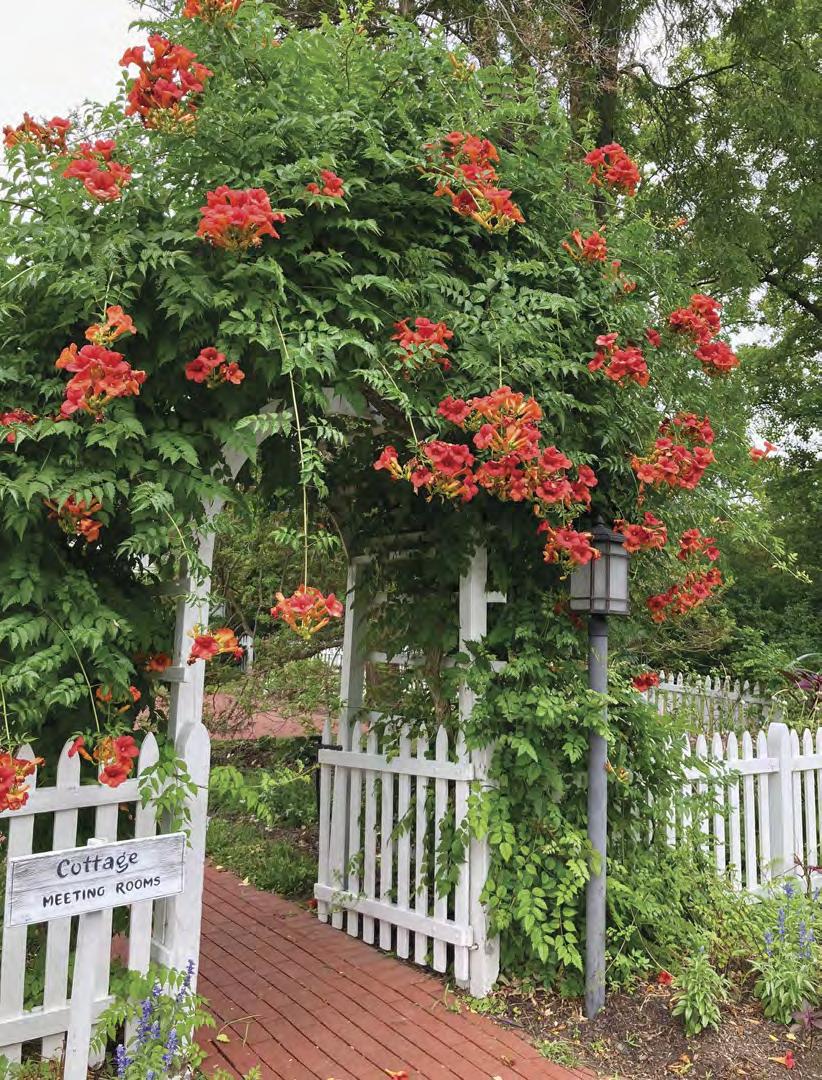

when the moon is in a barren sign and in its last phase is risky. The plant could die a rapid death or limp along for a while before fading away. It can be a delight, though, to discover how much easier weeding can be when the moon is in a fire sign and its last phase.
The most fruitful signs are the water signs, Cancer, Scorpio, and Pisces. The earth signs, Taurus, Virgo, and Capricorn, are also considered fruitful. These six signs are the best for planting, especially during the appropriate phase of the moon. Scorpio tends to have a bad reputation, associated with death and loss, but it also symbolizes rebirth and can be a wonderful sign for planting. In fact, perennials, trees, and shrubs planted when the moon is in Scorpio and its third phase gain extra vigor to survive winter and come back strong in spring.
Read the Signs
Several other signs have qualities of special interest to gardeners. Virgo is great for planting vining ornamentals. Clematis, trumpet vine, wisteria, and other flowering vines planted when the moon is in this sign grow well and bloom abundantly, although vining vegetables like beans and squash may produce less fruit. Virgo is
associated with digestion; plants started now make maximum use of available nutrients to grow long, sturdy vines, but fruiting can get short-changed.
Libra symbolizes balance, beauty, and love. It’s fabulous for growing flowers and ornamentals. The rose, the flower most often given to one’s beloved, can produce outstanding blooms if planted in good soil when the moon is in Libra and its third phase and if well cared for with enough sun, water, and organic fertilizer.
Sagittarius is generally considered barren but can work well for herbs and vegetables in the onion family. These plants have flavors that are strong and sharp, like the arrow loosed by Sagittarius the archer. Some herbs, like thyme, oregano, and rosemary, don’t need as much water as other plants, and the drier growing conditions Sagittarius fosters can concentrate their flavors.
Gardening by the moon, the oldest form of astrology, is simpler to learn than the complex astrology interpreting the sun and seven planets. Many calendars show the moon’s phases. Farmers’ almanacs and astrological calendars show when the moon enters and leaves each sign of the zodiac. With these basic guides, gardening with astrology can help create a beautiful, healthy, and productive garden.
upstate HOUSE | SPRING 2024 • 33
Timing gardening activities to the moon’s phases and its position in the zodiac can give a garden a significant boost.


34 • online at upstatehouse.com GARDEN


ROOM TO GROW EXPERT TIPS FOR DESIGNING A HOME GARDEN
By Hannah Van Sickle
By the time spring arrives in the Hudson Valley (where, let’s face it, mid-May marks the region’s average frostfree date), garden enthusiasts are hankering to get their hands dirty. Despite endless varieties insofar as shape, size, and style are concerned, a common denominator exists: gardens are serene spaces to connect with nature in order to relax and be restored. For homeowners keen on cultivating some horticultural eye candy and creating curb appeal in the process, deciding where to start can be a daunting endeavor.
“Garden design is like a four-dimensional art form,” says Katie Gasior, horticulture program coordinator for Cornell Cooperative Extension Sullivan County, who—beyond the height, width, and depth of any given plot—emphasizes that gardens are dynamic spaces. “There’s always going to be change [according to the seasons and over time], so it’s important to roll with the punches,” she says, reminding neophytes of a wellknown, but oft-forgotten, truth: It can take many, many years for a garden to reach its full potential. As the soil warms and backyard beds beckon, dig into these tips for getting the most out of your home garden design—green thumb not required.
Assess Your Site
The bedrock of garden design begins with observing, in a mindful way, the space you’ve got to work with. “Take a step
back and look at your surroundings,” suggests Gasior of a process that precedes everything from leafing through seed catalogs and visiting the local nursery to envisioning an end result. The goal is to understand what will thrive in your specific site based on soil conditions and sunlight. “The best way to test your soil [and determine if it is loamy, clay, or sandy] is to stick a spade in it,” says Gasior. Sunlight, on the other hand, needs constant evaluation. While shade tends to be straightforward, a spot you think is full sun might in fact be partial or dappled due to the overhead canopy that has yet to leaf out or dormant shrubs that will encroach once in bloom. A good rule of thumb? “When starting to plant a garden, take a full day [to evaluate your plot] and, once every hour, go out and take note of how much sunlight is coming through,” says Gasior, distilling things down to a simple motto: The right plant for the right place. “You can’t put shade-loving plants in a sunny spot, and if you have well-draining soil, a plant that likes soggy conditions is not going to do well there,” she explains of the biggest indicators as to whether or not your garden is going to be successful.
Plan Your Plot
When it comes to seeing the big picture, Gasior suggests creating an aerial diagram (think bird’s-eye view) of your
upstate HOUSE | SPRING 2024 • 35
Above, from left: A dahlia garden in full bloom in Westchester County.
Photo by Katie Gasior
Dino kale on the left, and Queen Lime Zinnias on the right at the Sullivan County Cornell Cooperative Extension raised-bed garden in Liberty.
Photo by Katie Gasior
Opposite, from top: A bee on an aster flower, which is native to New York. )
Photo by Katie Gasior
Eric Ruquist, director of horticulture at Berkshire Botanical Garden in Stockbridge, leading a tour of the Berkshire Botanical Garden’s native wildflower meadow.
Photo courtsey of Berkshire Botanical Garden




















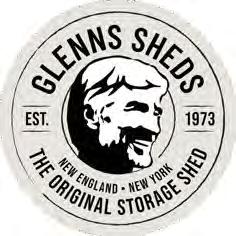






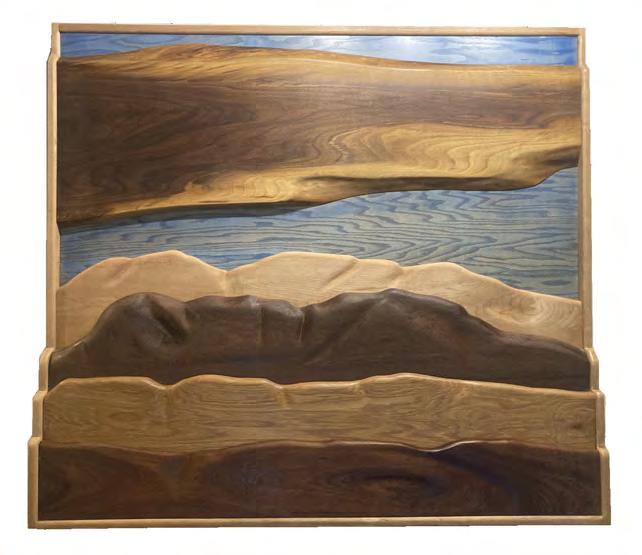
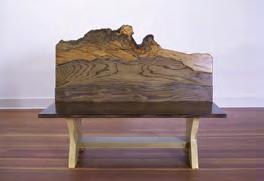

36 • online at upstatehouse.com ©2017AugustineNursery ©2015 Augustine Nursery ©2017AugustineNursery ©2015 Augustine Nursery FULL-SERVICE NURSERY • CUSTOM LANDSCAPE DESIGN & INSTALLATION • STONE YARD & HARDSCAPING Of Choice. ©2017AugustineNursery ©2015 Augustine Nursery FULL-SERVICE NURSERY • CUSTOM LANDSCAPE DESIGN & INSTALLATION • STONE YARD & HARDSCAPING Of Choice. 9W & Van Kleecks Lane, Kingston, NY Spring Hours: Monday–Saturday, 8am–5pm and Sunday, 10am–4pm FULL-SERVICE NURSERY • CUSTOM LANDSCAPE DESIGN & INSTALLATION • STONE YARD & HARDSCAPING WATER FEATURES • IRRIGATION • LIGHTING • RETAIL SHOP & MORE A Forest Of Choice. The broadest selection of the biggest trees and plants in the Hudson Valley. ©2017AugustineNursery ©2015 Augustine Nursery 9W & Van Kleecks Lane, Kingston, NY (845) 338-4936 AugustineNursery.com Spring Hours: Monday–Saturday, 8am–5pm and Sunday, 10am–4pm FULL-SERVICE NURSERY • CUSTOM LANDSCAPE DESIGN & INSTALLATION • STONE YARD & HARDSCAPING WATER FEATURES • IRRIGATION • LIGHTING • RETAIL SHOP & MORE A Forest Of Choice. The broadest selection of the biggest trees and plants in the Hudson Valley. Enlightened Landscaping 845-687-9528 hudsonvalleynative.com Forest Stewardship • Invasive Plant Removal Tree Care • Ecosystem Restoration • Landscape Design Reclaim Your Yard Heavy-Duty/Stick-Built 8’x8” Utility Shed HANDMADE SHEDS BUILT TO LAST FIREWOOD SHEDS | UTILITY SHEDS | CUSTOM SHEDS GLENNSSHEDS.COM 845-328-0447 BENCHES BY RENNIE CANTINE T HE OVER L OOK SERIE S Ar t & Furniture Re nn ieCa n ti n eDesi gn co m Renn ie Ca nt i ne@gmail.co m THE OVERLOOK SERIES MOUNTAINSCAPES Select work on view at EvolveD Interiors 68-88 MILL HILL ROAD, WOODSTOCK

property. Once the primary planting areas are sketched out, label the distinguishing features of each. Which area gets full sun? Has the best drainage? Provides clear sight lines to the neighbor’s yard? Next, determine the garden’s function. “Is it simply aesthetic or will your garden serve a particular purpose?” says Gasior of options ranging from edible gardens and pollinator pathways to foundation planting and stand-alone specimen trees—plus dozens of others in between. Regardless of the specifics, Gasior’s advice remains the same: “Start small and don’t overwhelm yourself,” she says, suggesting folks tackle the easiest, most accessible space first in order to gain the competence (and confidence) to ultimately conquer bigger and bigger spaces.
Decide on a Vibe
Home gardeners know in their gut if the goal is a formal, manicured look or a more free-form, organic approach. Perennials, for instance, can be divided and moved from season to season—in order to maintain pristine pathways and fill in empty spaces— or left to spill onto stone steps and propagate to their heart’s content.
A recent trend, letting portions of lawn revert to meadow, is a sign of the progressive gardening times. “Meadow landscapes indicate that people are becoming aware of the importance of native
species as opposed to those that are exotic and often invasive,” says Eric Ruquist, director of horticulture at Berkshire Botanical Garden in Stockbridge, Massachusetts. The self-described “plant geek” suggests creating a sustainable, eco-friendly environment that sustains natural wildlife by devoting 70 percent of your garden to native species and leaving 30 percent for showstoppers—that not only create visual interest but also urge folks along, drawing their attention from space to space.
Choose Your Specimens
In addition to supporting biodiversity and preventing invasions of non-native species, native plants have evolved to thrive in their given habitat. “[Think of it] like a template that’s already there,” says Gasior, who is always going to promote a native pollinator garden. Ditto for chatting with neighbors and attending local plant swaps to find plants that love where you live. In the case of perennial beds that won’t reach their full potential for several years, Gasior suggests using annuals to fill gaps and create beauty while the garden of your dreams develops.
Ruquist remains a fan of planting perennials close together and, when he can’t, turns to mulch—ideally, “something organic, that breaks down quickly and feeds the soil, like shredded leaves.” His top tip this season? Plant plugs instead of perennial gallons—a plug is simply a smaller version of the one-or-three
gallon plants typically around two inches wide. Ruquist suggests that plugs lends convenience and variety—especially as more and more local nurseries offer mix-and-match plug flats.
Consult Community Resources
When in doubt, expert advice abounds. “Local nurseries are a great resource,” says Gasior, as are nonprofits like Cornell Cooperative Extension that offer testing for the home gardener keen on learning the specifics of their soil’s pH and micronutrients. Cornerstone local suppliers like Hudson Valley Seed Company do a brisk business and boast pre-mixed wildflower seed mixes (in varieties ranging from Bird Lover’s to Northeast Native) bursting with blooms native to the Catskills, ideal for homeowners ready to shift from mowing the lawn to attracting native bees— an essential and dwindling part of the ecosystem.
Garden design is not a science, so dive in and don’t get discouraged. “The more you do it, the better you get,” says Gasior who reminds home garden enthusiasts that, when it comes to garden design, chunking the task is essential—as is leaving ample room to grow. “If you take the project on yourself, and tackle it in small pieces, it’s definitely doable,” she says, issuing a balanced sentiment shared by Ruquist. “It’s great to [strive for] a sustainable, ecofriendly yard that can be beautiful and appealing,” he says.
upstate HOUSE | SPRING 2024 • 37
Eric Ruquist planting a perennial in the Woodland Garden at Berkshire Botanical Garden in Stockbridge.
Photo courtsey of Berkshire Botanical Garden

NEWBURGH
WResurgent for Real
By Anne Pyburn Craig Photos by David McIntyre
hen Ramona Monteverde walked into the Hotel Newburgh for the first time, in 2002, she was stunned by the task that lay ahead. “I walked right back out and said ‘There’s no way this can work,” she recalls. “Then I went home and my partner said, ‘C’mon, you know you have to give it a chance.”
Two years later, Safe Harbors—the organization for which Monteverde serves as director of operations—got $21 million in funding and transformed the dilapidated, single-room occupancy hotel into supportive housing with a long list of amenities and programs. Monteverde, elected Ward 2 councilwoman in 2018, finds herself trying to help the city through an affordability crisis that led the council to declare a state of housing emergency late last year. “There’s a lot going on right now—every other street you drive down you see a building being rehabbed,” she says. “But even a shell of a building is now priced somewhere over $200,000 for a property that could cost you another half a million to renovate. My daughter and her fiance are looking to buy a home, and there’s just nothing attainable.” Monteverde is hoping the housing emergency declaration will help protect tenants while affordable developments come to fruition, including the Kearney Group’s projects on Colden and Montgomery streets and Safe Harbors’ own latest
effort, on William Street. “All of these projects take a couple of years to get through the permitting and financing process. Existing affordable housing has long waiting lists. Still, it’s finally happening—I just hope it doesn’t slow down. I hope developers continue to invest in Newburgh, and that we can keep figuring out how to keep people housed here, while also staying mindful of the environment and climate change.”
Just west of the city limit, in the Town of Newburgh, I-84 and I-87 converge just minutes away from Stewart International Airport, making for prime commercial real estate; as of 2022, there were 40 projects underway or planned. Last August, Tesla announced it would lease 927,000 square feet of brand-new warehouse space for a distribution center. New Jersey-based developer Matrix built that building and another on spec, citing logistical advantages and a strong local labor pool.
The Scene
Newburgh-born chef Chuck Bivona came home in 2019 to handle family matters and stayed to partner with a longtime friend and open Bivona’s Simply Pasta, a handmade pasta shop and deli on Liberty Street’s resurgent Restaurant Row—where as soon as one restaurant closes another opens up.
“The unique culture of a community, the roots,
is the draw—that’s why, say, Arthur Avenue in the Bronx is still bubbling after a century,” Bivona says. “As a sort of stepchild borough [of New York City], we get much of the same diverse, talented melting pot, and the result is entrepreneurial energy—Latin American, Black, European, a small but growing Asian presence. So we have bangin’ Jamaican jerk spots and Mexican sweets and ice cream, along with great Greek and Italian food, places like Torino Bakery and Newburgh Lunch, multigenerational success stories. G&H Deli just did a major remodel; it’s gorgeous. And there’s a diversity of thought—you can be politically passionate in whatever way, and somewhere in the greater Newburgh area you’ll find allies. But please, don’t come here thinking you have the magic recipe that will make Newburgh cool. Newburgh was never not cool.”
Sam Satanovsky owns Toasted, a restaurant and nightlife spot a few doors from Bivona’s. “I’ve never pretended to be from here. I came to a city I loved hanging out in because I thought I could make money here,” he says. “I’ve seen others come and go, and sincere community commitment will make or break you here.” Amid live music, comedy, and drag nights, Toasted reserves multiple nights a month for talented local youth.
“When we first arrived, this was a stretch of nothing but condemned buildings,” Satanovsky says.
38 • online at upstatehouse.com
COMMUNITY

“Now, I come in on a Tuesday to take out the trash and there’s a line out the door at the pasta shop. There are so many people coming here, so many eyes on our city right now, and I think what we do in the next five years can stop the roller coaster ride and establish us as a solid destination going forward, but it’s going to take intelligent government.”
This spring, nightlife will be sparkling at both Toasted and the Silk Factory, a 1910 industrial space reimagined by Newburgh native Rich Fracasse into an elegant cafe and venue. On May 11, Newburgh Mercantile will host an urban outdoor art market, Art on the Block. A brand new independent bookstore founded by pandemic-era transplant Angie Venezia last fall, the Golden Hour, is named for the look of the city at sunset.
The Market
Sarah Beckham Hooff, broker/owner at ReAttached Real Estate, says that Hudson Valley locals and city transplants alike are drawn by Newburgh’s advantages: a compact, walkable, friendly city on a hill that protects against flooding issues. “Newburgh’s outdated reputation is fading, in part, because racism is going out of style,” she says. “There’s been a
tremendous amount of investment here over the past 10 years, and the city’s doing a good job reorganizing. Money is being spent on roads and sewers, the credit rating has been improving. Over the next few years, there’s going to be a lot of new, high-quality housing created—some affordable, some artists’ lofts, some market rate, like the beautiful Lofts at The Foundry. You need all of those to balance things out.”
“We still have a lot of fixer-uppers, and homeowners are taking advantage of renovation loans and of changes to FHA guidelines that make it affordable to purchase buildings of up to four units, so you can live in one and rent the rest,” Hooff says. “And despite the pandemic boom, you can still find a renovated townhouse with river views for what you’d pay for a bland little cottage on a side street in, say, Beacon.”
At press time, there were fixer-uppers, some smaller bungalows and Colonials, and condos listed for under $250,000. Between $400,000 and $500,000, one could find multifamily properties, some brick gems, and ranches and Colonials on larger lots on the outskirts of town. An architect-built three-bedroom with deeded river access, high ceilings and generous patio and pool was on the market for just under $2,000,000.
THE FACTS
ZIP CODE: 12550
POPULATION: 28,196
MEDIAN HOUSEHOLD INCOME: $48,555
PROXIMITY TO MAJOR CITY: Newburgh is 60 miles from New York City and 90 miles from Albany.
TRANSPORTATION: Newburgh is located at the crossroads of Interstate 84 and the New York State Thruway. There are four commuter bus runs to and from Manhattan each weekday, and the NewburghBeacon Ferry connects to Metro North’s Hudson Line. New York Stewart International Airport is located just outside the city. City busses provide transit along the Broadway corridor on the half hour.
NEAREST HOSPITAL: Montefiori St. Luke’s Cornwall Hospital is within city limits.
SCHOOLS: Newburgh Enlarged City School District serves 10,913 students in grades K-12 at its 13 schools. Independent schools include the San Miguel Academy and Nora Cronin Presentation Academy. Mount Saint Mary College and a SUNY Orange campus are located in Newburgh.
POINTS OF INTEREST: Washington’s Headquarters, Downing Park, Newburgh Free Library, Atlas Studios, Grit Gallery, Liberty Street, Thornwillow Press, Ritz Theatre, Bank Art Center, Waterfront Trail Urban Walk, Newburgh Wireworks, Waterfront Restaurant District, Motorcyclepedia Museum, Newburgh Brewery, The Wherehouse, Blacc Vanilla Cafe, East Side Historic District, David Crawford House, Newburgh Armory, Dutch Reformed Church, Newburgh Colored Burial Ground.

upstate HOUSE | SPRING 2024 • 39
Above: Jerrod Lang, owner of Blacc Vanilla Cafe on South Street. His Blacc Vanilla Foundation helps place city youth in apprentice programs.
• Great Barrington
Opposite: Members of the Downtown District Business Alliance on the corner of Broadway and Liberty Street in Newburgh.

SAUGERTIES
Saugerties, a compact hillside village and sprawling surrounding town, began being settled by European immigrants in the mid17th century, over 100 years before the first Eurosettler hit its inland neighbor, Woodstock. Over the centuries, enough development has sprung up along the 10-mile stretch of Route 212 that connects them that it’s sometimes called Saugerstock.
But make no mistake, these are two wildly different communities despite a shared love of art and good food.
Back in 1994, Saugerties agreed to something that Woodstock, a quarter-century earlier, had declined to do: host a music festival. The 25th Woodstock reunion, billed as “2 More Days of Peace & Music” featured a long list of big names from Metallica to Santana. Around 350,000 people—roughly 200,000 more than the organizers had expected—showed up at Winston Farm for what turned out to be a wet, chaotic, memorable weekend. The town was, of course, overwhelmed. It might have put some places off partying forever.
But not Saugerties. There are conversations in the works about commemorating the 30th anniversary of that gathering, a fond memory for more than a few who were there. And Saugerties
Festive Spirit
By Anne Pyburn Craig Photos by David McIntyre
is, in fact, a town that dearly loves its festivals— although mostly at a far more manageable scale.
“The Chamber of Commerce is organizing a week of smaller events,” says Bob Siracusano, founder/owner of Sawyer Motors and Sawyer Ice Cream Company, christened “Mr. Saugerties” for the boundless well of volunteer organizational and fundraising energy he devotes to the community’s good causes. “They’re having a lot of the local musicians who played at the original festival at various places around town, and the Kiersted House is going to have a big exhibit of photos and memorabilia.”
The Scene
Celebrating a massive rock fest at a 1727 stone house is far from the only fun happening in Saugerties this year. Siracusano says the town’s entire packed dance card has come roaring back to post-pandemic life. “One of the bigger events is our car show in July; we expect about 700 cars and around 10,000 to 15,000 spectators,” he says. “Then there’s the Garlic Festival in October. The Kiwanis do that one, and all the proceeds from both of those go to local nonprofits. Then there’s the Mum Festival at Seamon Park, the big Fourth of July parade, the art studio tour in August. Oh, and
they’re doing a second annual Snow Moon Festival. They gave $15,000 to the food pantries from last year’s. Between all of that, plus a lot of smaller stuff, I think there are a lot of towns out there that would love to be more like Saugerties.”
Upstate Films now operates the historic Orpheum Theatre and is putting the finishing touches on The Mark, a 99-seat state-of-the-art screening room with acoustical architecture by John Storyk of WSDG. A freshly opened event venue in a restored 19th-century Dutch chapel, The Local, is hosting a wildly diverse series of performances curated by an ownership team with three decades of top-flight event production experience.
Laura Huron, owner of Bosco’s Mercantile, a hone goods store on Partition Street, is bringing in more bedding brands and doing “a little remodel of the atrium and the main room.” She’s rejoicing in the arrival of Enoki, an Asian grocery that’s relocated from Catskill. “The young couple is beyond lovely, and an Asian pantry is a huge win for Saugerties,” says Huron. “I know her mom makes the kimchi every week, and it’s spectacular. We’ll all miss Emerge Gallery, but the owner of that building is a great community supporter, and I’m sure she’ll find the right tenant.” (Robert Langdon’s Emerge
40 • online at upstatehouse.com
COMMUNITY

ZIP CODE: 12477
POPULATION: 19,090
MEDIAN HOUSEHOLD INCOME: $70,368
PROXIMITY TO MAJOR CITY: Saugerties is 110 miles from New York City and 45.3 miles from Albany.
TRANSPORTATION: Saugerties is located on the NYS Thruway at Exit 20, and there are daily bus runs to Manhattan and Albany via Trailways; you can hop on an Amtrak half an hour away in Hudson. The nearest airports are Albany International (50 minutes) and Stewart International in New Windsor (also 50 minutes).
NEAREST HOSPITAL: HealthAlliance Hospital of Kingston is 14.5 miles to the south. Northern Dutchess Hospital in Rhinebeck is 13.5 miles away via the Kingston-Rhinecliff Bridge.
SCHOOLS: The Saugerties Central School District serves 2,608 students at its high school, junior high, and four elementary schools. Nearby private options include Woodstock Day School and Zena Democratic School in Kingston.
Gallery is very much still active in cyberspace.)
Lifelong resident Nina Schmidbaur has transformed Clovelea, a derelict Queen Anne mansion, into the home of a flourishing therapeutic collective of ten practitioners offering mental health and acupuncture. A nonprofit, RYAN House, is working to turn the former Knights of Columbus Hall into a sober living and recovery space.
The Market
“Like most places around the Hudson Valley, we’re still struggling with very limited inventory,” says Sheena Lepez, an agent with Berkshire Hathaway Homeservices Hudson Valley Properties. “Not a lot of selection, and plenty of buyers still eager for a house. I had an open house on the coldest Saturday in January, and I was surprised by how many came out.”
It’s no mystery to her why people love the town. “We have built-in advantages here. You can get a lot of mountain views and privacy and be just moments from this cool, walkable little village with some great food, great bars, a cinema, a fantastic indie bookstore. Then, of course, we have the river—all of this just a few minutes from
Woodstock at a slightly lower price point. What more could anyone need? I’m born and raised here, I’m raising my kids here, and they can walk and bike all over the place.”
Low inventory, high prices, and high interest rates make it challenging to get a piece of this bliss, but Lepez says it can be done. “Find an agent you can trust, who’s going to look out for you. If you wind up in a situation with multiple offers, you want someone there who’s experienced with that scenario and can get creative with the terms of your offer.”
At press time, there were a few fixer-uppers priced under $200,000 and a variety of modest ranches and colonials in better shape listing between $250,000 and $350,000. Between $400,000 to $600,000, one begins to see acreage, larger homes, and village locations. Farmhouses on larger lots and raw land with particularly spectacular mountain views can be had in the $750,000 range, and closer to $1,000,000 there were properties with views and waterfalls. A minimalist three-bedroom contemporary ranch with vast expanses of glass facing Hudson River panoramas was being offered by Hudson River Homes for $1,999,000 as a to-be-built spec house.
POINTS OF INTEREST: Saugerties Lighthouse B&B, Opus 40, Cantine Field, Diamond Mills Hotel, Kiwanis Ice Arena, Saugerties Village Beach & Playground, Catskill Animal Sanctuary, Esopus Bend Nature Preserve, Tina Chorvas Waterfront Park, 11 Jane Street Art Center, Inquiring Mind Bookstore and Gallery, Kiersted House.
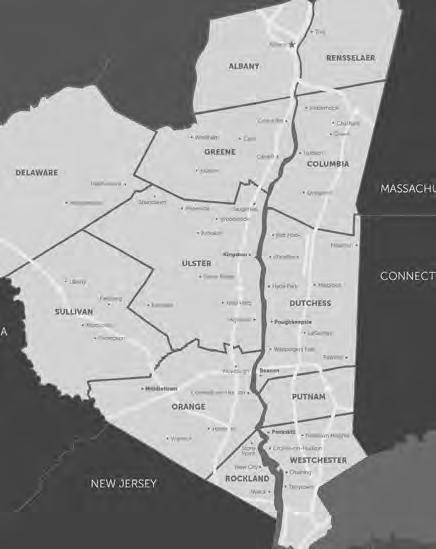
upstate HOUSE | SPRING 2024 • 41
THE FACTS
Above: Vanessa Piazza, owner of Josie’s Coffee Shoppe.
Opposite: Artist Ze’ev Willy Neumann in front of his Saugerties sculpture/sign on Snyder Hill off Route 212.

42 • online at upstatehouse.com


WARREN STREET REDUX
A Historic Home Gets a Renewable Renovation
By Joan Vos MacDonald
Renovation sometimes requires rethinking the original plan—especially in older homes, which often present expensive surprises. That’s what happened to architects Craig Tooman and Shukri Sindi during the process of updating an 18th-century townhouse on Hudson’s Warren Street.
Implementing passive design and construction standards in a historic building is a skill that the CTA Architects have mastered while working on a variety of New York City structures, including multiple schools, apartment buildings, and public spaces. When the architects bought the Warren Street townhouse in 2011, the idea was to preserve and restore the historic structure while making it more energy efficient and reducing its carbon emissions.
“We’re a New York City firm, we’re an urban firm, we’re a design firm, we’re a restoration firm and we’re a preservation firm,” says Tooman, AIA, LEED-AP, CPHD, a certified Passive House designer. “We wanted to try and put all those things together, so we chose Hudson because it has a significant downtown historic district.”
upstate HOUSE | SPRING 2024 • 43 HOUSE PROFILE
Above: A side view of the facade of the 18th-century townhouse that was reimagined by CTA Architects.
Left: The building features a modern take on the oriel, the boxed bay windows that grace older structures on the Street.

Rebuilding, Not Replicating
The idea of Passive House and its high standard for energy efficiency has become increasingly popular over the last few decades—but some might mistakenly think these technologies can only be employed in new construction. That’s not the case. “We didn’t want to buy property with a beautiful vista in the country somewhere and put something there that had never existed before,” says Tooman. “We wanted to take something that was here already and rehabilitate it, use the embodied energy and not increase urban sprawl.”
The architects’ plans faced an unexpected disaster in 2018. While trying to make the basement more useful for the building’s first floor retail space, contractors dug out some of the basement floor. “He dug it out beautifully,” says Tooman. “Because it’s a very clay-like soil here, it’s like cutting a piece of cake.”
Everything seemed to be going smoothly before an unusually intense bout of bad weather decimated their plans. After it rained steadily for two weeks, water began to pour into the basement and the flooding weakened one side of the foundation. Attempts were made to shore up the building, but eventually the whole foundation collapsed. The architects,
who worked on the project under the name Passive Aggressive Housing, wondered whether to invest more time and money into what had become a pile of rubble. Eventually, they decided to build a new house, one that still seemed at home on a historic street, despite being the only newcomer. The new plan faced subsequent challenges that included construction during the pandemic and winning approval from Hudson’s Historic Preservation Commission.
“We didn’t want to just replicate the house, which some people wanted us to do,” says Tooman. “We wanted to make something modern, but that was respectful of the street.”
The inspiration for the look of the new house was really the rest of Warren Street.
“We chose the materials specifically because they’re common to Warren Street,” says Tooman. “The shape of the house is the same as what was here before. It was two stories. It had an attic. The only thing we changed was that we moved up the roof line, so that we actually had a full attic upstairs. We added attic windows that are common all the way up and down Warren Street. We took the original house as inspiration, we took Warren Street, and then we tried to give it a little bit of a modern twist.”
Some of the buildings original boards propped up against the wall near the staircase. Architect Craig Tooman plans to use the boards for an art installation.
44 • online at upstatehouse.com




upstate HOUSE | SPRING 2024 • 45 366 WARREN STREET, HUDSON NY | 518.822.8120 | HUDSONHOME.COM GARDEN PARTY CHIC OUR EXCLUSIVE OUTDOOR FURNITURE COLLECTIONS HAVE ARRIVED 518.587.7120 phinneydesign.com NY PA MA VT ARCHITECTURE, INTERIOR DESIGN & CONSTRUCTION MANAGEMENT Serving Commercial, Hospitality & Custom Residential clients throughout the Northeastern United States DESIGN BUILD RECONCEIVE jeffreyaeckes@ldrgroup.net LDRgroup.net



















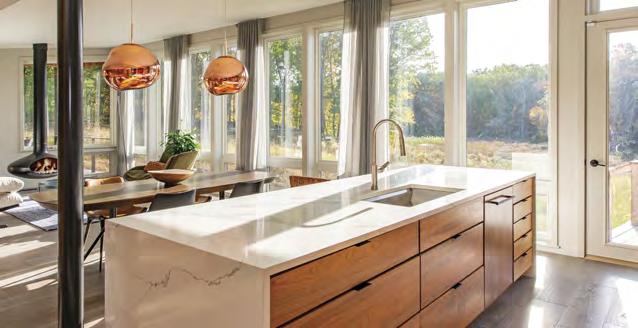

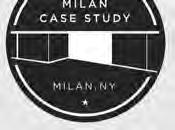

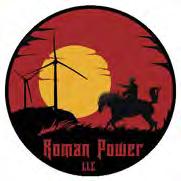
46 • online at upstatehouse.com ROMANPOWERLLC.COM The Chronicles will explore the journey to renewable energy TOMKINS COVE CHRONICLES 9477 Route32, Freehold, NY12431 518-634-2226 milancasestudy.com 917.865.0227 nick@milancasestudy.com A MODERN RESIDENTIAL DEVELOPMENT LOCATED MINUTES FROM RHINEBECK, NY WITH HOMES DESIGNED BY AWARD WINNING ARCHITECT JAMES GARRISON EvolvedInteriors.com 86-88 Mill Hill Rd, Woodstock, NY 845.679.9979 Interior Design, Kitchens, Baths, Additions & Decks, Finished Basements, Saunas, Steamrooms & Outside Showers, Cabinetry & Countertops, Sinks & Faucets, Hardware & Lighting, Tile, Hardwood, Carpets, Wall Coverings evolvedinteriors.com
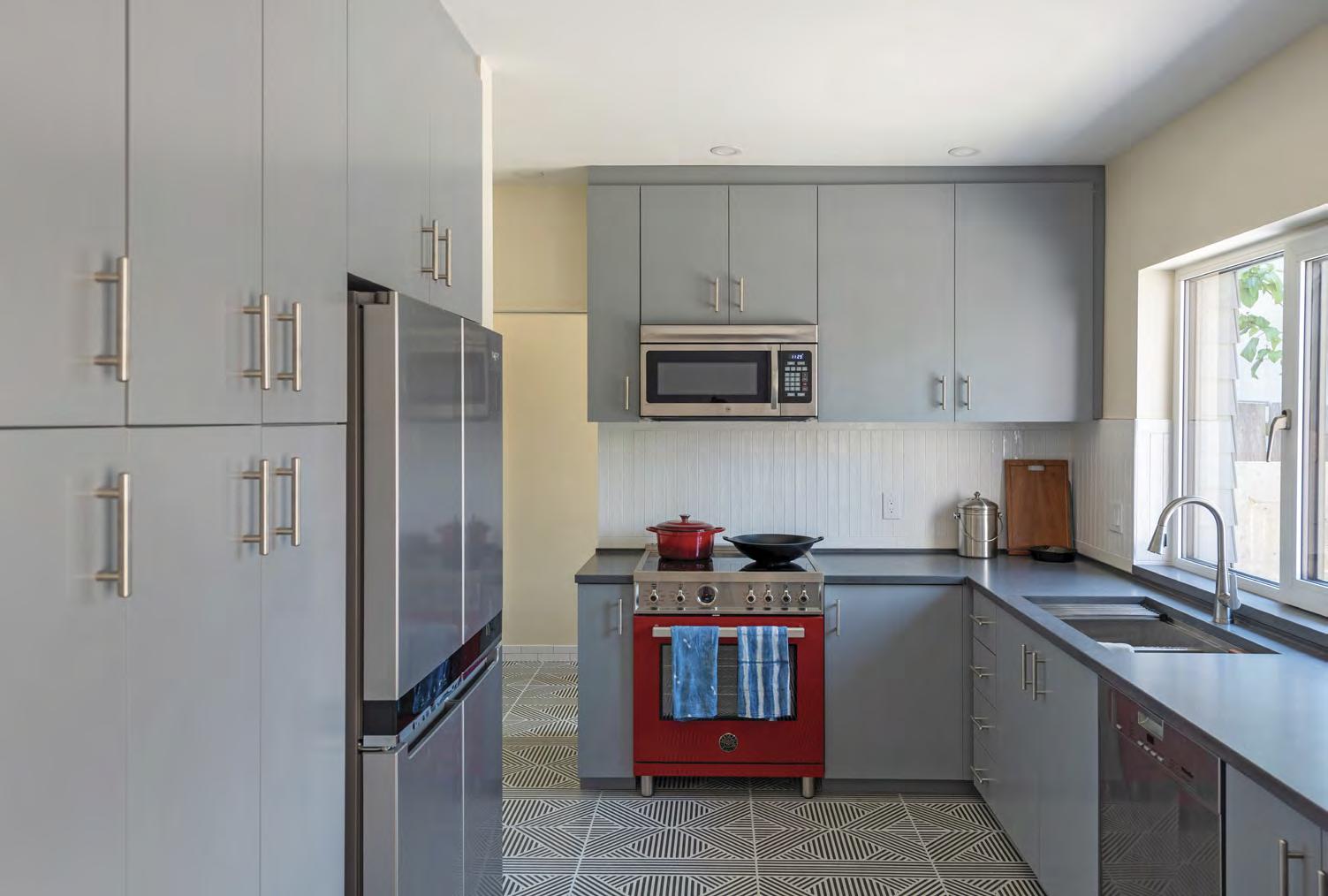
Agressively Passive
Many of the street’s older buildings have an oriel—boxed bay windows that jut out over the street—so the architects included updated reimagined examples in their new construction, blue cantilevered rectangles, on both the front and back facades.
“We bumped out the blue oriel over the storefront because it’s common to Warren Street,” says Tooman. “We made it in wood because they’re in wood on Warren Street, and we made it a bright blue, because they’re often colored very brightly, as is the case with the building next door to us. And we picked a concrete board to do the clapboard on the side. Clapboard is very common here, but we also wanted to use some more modern materials, some more resistant materials. So we used concrete cladding, and then pushed the oriel back all the way along the back facade so that it shades the first-floor back windows in the summer.”
The updated house design includes solar panels, which have so far contributed 25,000 kilowatt hours to the grid. Interior considerations keep the home from losing heat in the winter or cool air in the summer. The Warren Street house was recently certified by the US Department of Energy as a zeroenergy home and certified by PHIUS as to its Passive House energy standards.
“The walls are super-insulated,” says Tooman. “They also have an air barrier, so there’s no or very minimal airflow through them. The windows are triple glazed, so they’re extremely energy efficient. We have an ERV, an energy recovery ventilator, because when you seal a box, the air can get stagnant inside.”
The ventilator keeps the air fresh without making the house colder in the winter or warmer in the summer. It recovers the energy put into heating or cooling the interior of the house, while bringing in fresh air from the outside, and this also helps eliminate mold.
As well as LED fixtures, the house has a condensing washer/ dryer in the basement and a condensing hot water heater. A gravity-fed hot water loop supplies water that is instantly hot. During construction, the builders also used as many local materials as possible, employing wood flooring supplied by Ghent Wood Products and concrete countertops crafted by Marveled Designs in Chatham.
The expansive deck behind the house is made from wood recycled from New York City water towers. “I have a friend who builds water towers in New York City and they’re either cedar or they’re redwood. They last about 20, 25 years,” says Tooman. “Then they strip them and throw them away. But the lumber is two-and-a-half inches thick”
upstate HOUSE | SPRING 2024 • 47
A cherry red induction stove provides a splash of color in the sleek, contemporary kitchen.

48 • online at upstatehouse.com
Raising the roofline allowed for an extra set of windows and brighter, airier bedrooms.
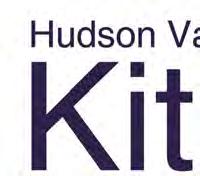

















upstate HOUSE | SPRING 2024 • 49 WHERE FUNCTIONALITY MEETS DESIGN Get a personalized quote 2713 Route 17M, New Hampton, NY | 845-615-9410 HVKDC.COM SERVING THE HUDSON VALLEY FOR OVER 30 YEARS Reliable and Trustworthy Your Neighbors at Work! lighthousesolarny.com Serving the greater Hudson Valley since 2009 4 Cherry Hill Road, New Paltz, NY 12561 • 845-251-3926 RESIDENTIAL AND COMMERCIAL SOLAR ENERGY STORAGE SYSTEMS 71 Main St, New Paltz, NY blejerarch.com 917.637.0341

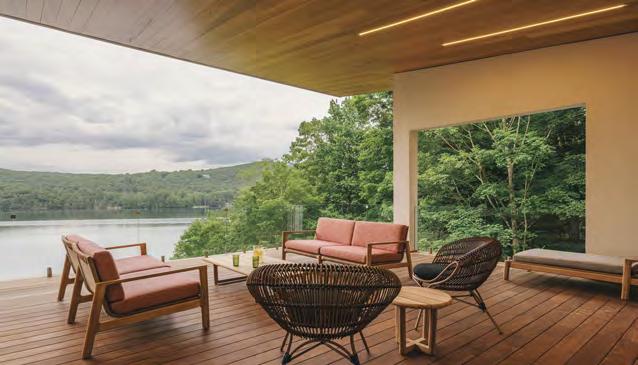
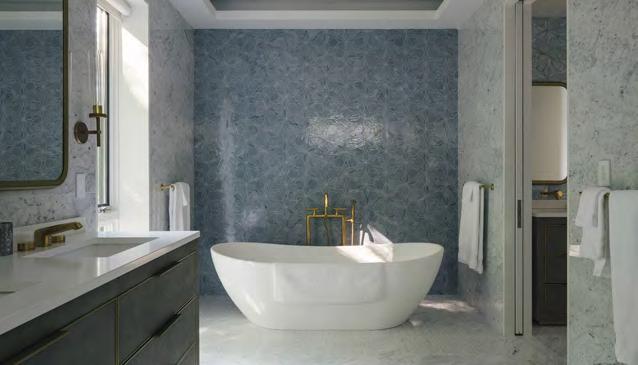
ADIRONDACK DESIGN ARCHITECTURE
MICHAEL L. BIRD, A.I.A.
MICHAEL L. BIRD, A.I.A.
ADIRONDACK DESIGN ARCHITECTURE
MICHAEL L BIRD, ARCHITECT PC ADIRONDACK DESIGN ADIRONDACK DESIGN ARCHITECTURE
MICHAEL L. BIRD, A.I.A.
FRO M CO U NT RY ESTATES , TO SOP HISTICATED
FRO M CO U NT RY ESTATES , TO SOP HISTICATED
TOWN HOUSE S , AND RUSTIC R ET REATS .
FRO M CO U NT RY ESTATES , TO SOP HISTICATED
TOWN HOUSE S , AND RUSTIC R ET REATS .
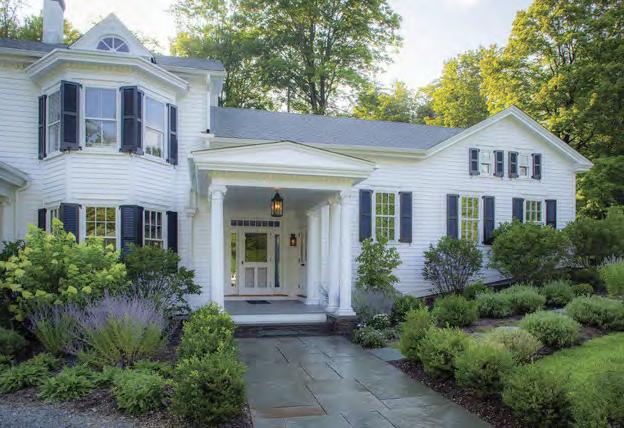
TOWN HOUSE S , AND RUSTIC R ET REATS . M




WWW. ADKGREATCAMPS.COM
ARCHITECTURE


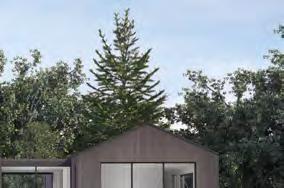


50 • online at upstatehouse.com laurenwegel.com
& Interiors SERVING NYC & THE HUDSON VALLEY MIHAI RADU ARCHTECTS Architecture & Interior design 494 8th avenue, New York, NY 10001 212.691.1711
Ackerley Road, Gilboa Catskills, NY 12076 917.822.0597 mradu@raduarchitects.com
Architecture
194
IC HA EL L . BIR D AI A RHINEBEC K , NY | 51 8 - 63 7 - 25 24 SARANA C LAK E , NY | 51 8 -89 1 -52 24
M
WWW. ADKGREATCAMPS.COM
M IC HA EL L . BIR D AI
RHINEBEC K
NY | 51 8 - 63 7
25 24
C LAK E , NY
51 8
1
24
A
,
-
SARANA
|
-89
-52
D AI
RHINEBEC K , NY
51 8 - 63 7
25 24
C LAK E , NY
51 8
1
24
IC HA EL L BIR
A
|
-
SARANA
|
-89
-52
WWW. ADKGREATCAMPS.COM
NEW CONSTRUCTION + RENOVATION jansonscuro.com 212-691-1611 NEW YORK CITY HUDSON VALLEY BERKSHIRES CONNECTICUT RIVER RESIDENCE - IN PROGRESS
INTERIOR
DESIGN
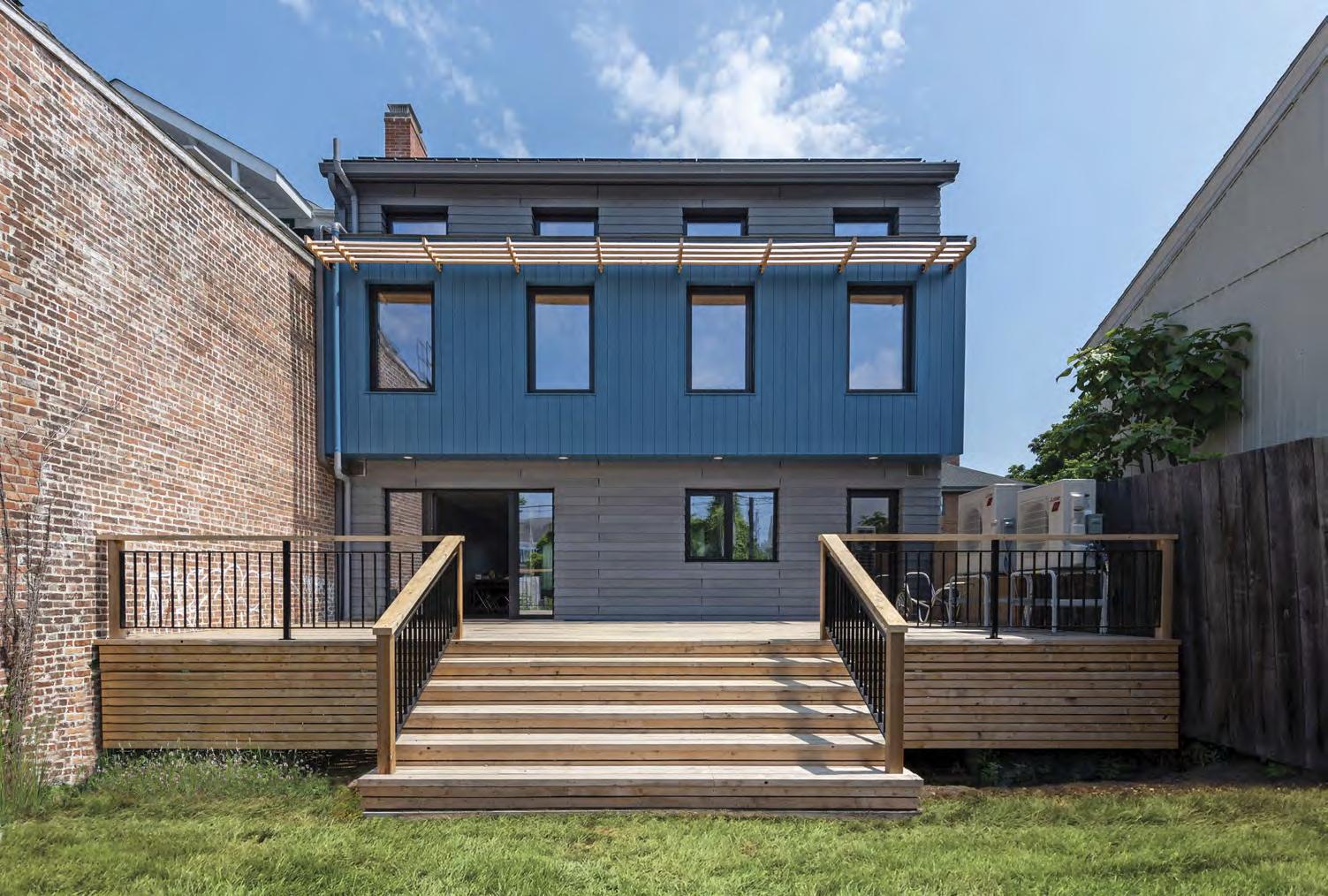
A Reminder of History
As well as the retail space at street level, the 4,000-squarefoot home has an elongated living space, kitchen, and mudroom on the first floor. The kitchen is open to the living/dining space, which looks out onto the deck and sizable urban backyard. The kitchen’s focal point is a cherry red induction stove, surrounded by gray cabinetry that’s topped with gray, red-speckled concrete countertops. The upper floors feature five bedrooms and three baths. Thanks to the raised roofline and added windows, the sunny upstairs bedrooms seem at once cozy and spacious.
Tooman, who grew up partly in Rome and Hawaii, has always loved architecture and design, but he also appreciates nature and prioritizes sustainability. That’s part of the mission behind CTA Architects, which is a certified B-Corp. The B-Corp movement is a global community of people using businesses as a force for good, ideally balancing people, planet, and profit. Passive House construction meshes into that, mixing the latest developments in design and architecture with concern for the environment.
“We need to continue to house people,” says Tooman. “So how do we do that without hurting the planet? We build in urban areas and we build as efficiently as possible. That just seemed to be a natural progression in my career.”
Reducing a home’s carbon footprint can be as simple as using better insulation, efficient ventilation systems, and installing new windows. “The concept is very simple,” says Tooman. “The implementation is not always so simple.”
After the original structure’s unfortunate implosion, Tooman saved some of the building’s boards, which he plans to use as art in the new space, a reminder of the street’s history. “They have mismatched wallpaper on them,” he says. “In the house that came down, there was a middle wall that held up the house, and it was clearly something that in the 1780s had already been salvaged. Those boards are mismatched. It was obviously not original wallpaper to this house. It was wallpaper from another house on the boards that they had put here and held up the house. So, I feel like this is the next iteration.”
upstate HOUSE | SPRING 2024 • 51
Wood from New York City water towers was recycled to construct the home’s back deck.


52 • online at upstatehouse.com SPONSORED

A TRIUMPH OF TEAMWORK
HOW CLEMENT, BROOKS & SAFIER BECAME THE LEADING BROKERAGE TEAM IN ULSTER AND DUTCHESS COUNTIES
Buying or selling a home in the Hudson Valley used to be a much more casual affair. Even just five years ago, many of the real estate agents in the region worked independently and part-time, jumping in and out of the market as their client list waxed and waned.
and the number one team in the entire Berkshire Hathaway HomeServices network from New York City to Rhode Island. They have set sale-price records in Kingston and the towns of Rosendale and Marbletown, and have closed deals even in the most heated multiple-offer environments.
Opposite:
Even before the pandemic transformed the region’s real estate landscape, however, longtime local agents Hayes Clement, Donna Brooks, and Harris Safier noticed that there was a shift happening in the industry driven by the introduction of smaller, closely knit brokerage teams who could collaborate instead of compete. At the end of 2019, they founded one of the Hudson Valley’s first brokerage teams, the Clement, Brooks & Safier team at Berkshire Hathaway HomeServices Hudson Valley Properties with the goal of pooling their collective 60 years of experience and providing a greater whole for their clients and colleagues alike.
Though somewhat novel, the brokerage team approach to real estate has been gaining traction in recent years and now accounts for 26 percent of realtors. The efficacy of the Clement, Brooks & Safier approach—a blending of the principals’ diverse skill sets and increased efficiency, adaptability, and support—has been undeniable. Last year alone, they wrote or closed more than $104 million in sales, making them the leading brokerage team in Ulster and Dutchess counties,
“No one person can fulfill everything a broker needs to do successfully, and we don’t have a tremendous amount of overlap in our strengths, which gave us a strong foundation for the team,” says Brooks. “When we first started talking about becoming a team, I couldn’t find that dynamic anywhere else.”
Brooks comes to real estate with over 15 years of experience in sales, marketing, and customer service, which she honed in part at Hudson Coffee Traders, the Kingston coffee shop she owned for almost a decade before becoming an agent. Clement, a former television development executive and publisher who moved to the Hudson Valley in 2010 and became a real estate agent in 2013, brings 25 years of marketing and financial experience to the equation. Safier, a 40-plus-year veteran of the Hudson Valley real estate industry who sold his Ulster County brokerage, Westwood Metes & Bounds Realty, to Berkshire Hathaway in 2018, has always been known for his deep commitment to cultivating an atmosphere of ethics and integrity among the agents who work with him.
upstate HOUSE | SPRING 2024 • 53
Above: The 15-agent Clement, Brooks & Safier Team meets in person regularly to collaborate and share knowledge.
Since its founding in 2019, the team has been setting records across Dutchess and Ulster counties. Recently listed and sold properties include 520 Binnewater Road in Rosendale (top) and 205 Kelder Road in Olivebridge (bottom).

“Our values aligned in a really solid way, and I think that’s a lot of what sets us apart,” says Clement. “Our ethos is really about making things happen for our clients, and fixing any problem that comes our way.”
At the team’s Kingston office, the three principals work sideby-side with their 12 agents to craft strategies for their buyers and sellers that draw from their collective experience while focusing on building expertise among the newer agents who join their team. “Most agents in a brokerage are competing against each other, but we’ve been able to really foster and cultivate a very different dynamic and a team-oriented approach where our clients really get the benefit of all of our backgrounds, ideas, expertise,” says Brooks. “I think it’s what has enabled us to take people who are newly licensed and teach them how to be successful in this industry in a way that people who are four or five years into real estate even aren’t.”
The process of collaboration can be felt from the moment a seller approaches the team about listing their home. After an initial visit to walk through the property and discuss the seller’s wants, needs, and timeframe, the listing agent meets with multiple members of the larger team to put together the strategy for the sale. It includes a fully fleshed out price opinion with a values statement about the property’s position in the market and a marketing plan that prioritizes traditional touchpoints like open houses, postcards, and press opportunities just as much as the digital avenues like email
newsletters and social media that have become indispensable in recent years. “I don’t think there’s one magic bullet to getting a house sold,” says Brooks. “I think it’s about developing and executing your total plan, and that total plan is what ends up driving success.”
Staging is another area where the team goes the extra mile. They have an entire warehouse of furniture and decor for homes that need a little something extra to make marketing photos pop, and for larger projects they even work with a professional stager who can change the entire aesthetic of the interior to appeal to the ideal buyer. “Staging wasn’t really done in the Hudson Valley market much,” says Clement. “I wasn’t a big believer in it initially, but we’ve seen the dramatic difference that it can make in reducing your days on market and increasing the number of showings.”
The team’s commitment to doing right by their clients as well as other brokerages and the Hudson Valley community is baked into the way they do business. “We really believe in being active in our communities outside of real estate. Each person on the team is involved in their community in a genuine way,” Brooks says. “We also believe in fostering close relationships within the realtor community, because that is so important to our clients’ success. I once had another agent tell me that my client didn’t have the highest offer, but that they were going to accept ours because they knew I was going to make it a seamless process right up to the closing table.”
Above: This Calvert Vauxdesigned mansion on Kingston’s renowned West Chestnut Street is one of the team’s recent sales of historic properties in the region.
Opposite: Now on the market with the Clement, Brooks & Safier Team is the iconic Wilson Gray Homestead in Kerhonkson, which underwent a twoyear restoration to honor its storied past while providing a move-in-ready home with modern, state-of-the-art conveniences.
54 • online at upstatehouse.com
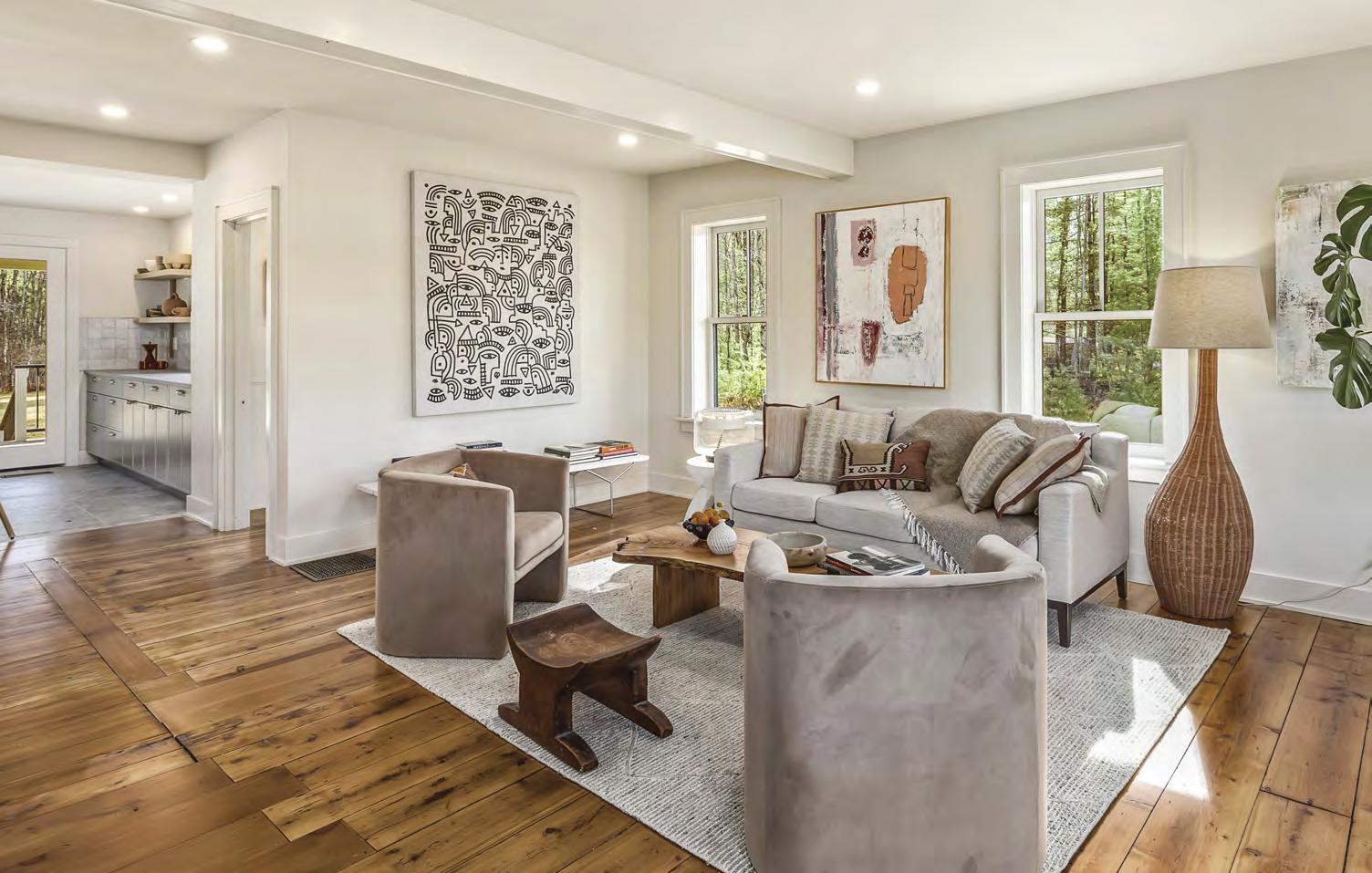
Featured on the Cover and Above
Following a two-year overhaul by some of the region’s most renowned contractors and designers, the iconic Wilson Gray Homestead is ready for a stylish new chapter in its already storied life. The farmhouse, built in the early 1800s but dismantled and moved in 1915 to make way for the Ashokan Reservoir, is one of the few Ashokan-displaced houses still standing in the Hudson Valley— and now one of its most stunning, too. The iconic home, known for its signature wraparound stacked verandas, has been fully renovated in a style that respects both its architectural heritage and modern sensibilities, featuring a thoughtful and consistent balance of openness and privacy throughout three levels of space.
1078 Samsonville Road, Kerhonkson
$1,695,000
4 Bedrooms
3.5 Baths
Clement, Brooks & Safier Team
Berkshire Hathaway HomeServices Hudson Valley Properties
Hayes Clement
Associate Real Estate Broker
16 Hurley Avenue, Kingston (917) 568-5226
Unlockupstate.com
The intentional, values-based approach is one that has earned them the loyalty of repeat buyers and sellers who recognize the amount of work they put into each sale. “A lot of our clients end up being friends, and we stay in touch with each other long past their closing,” Brooks says.
“By the time Hayes came along, we had already gone through three other agents,” says Carol McCann, one of Clement’s clients who has bought and sold two houses in Ulster County with him. “He understood that the house was special. I’m sure a lot of people think that about their house, but it was a 100-year-old-home that had a really interesting history and all kinds of details that you would never find these days. When Hayes walked through the house, he really saw it, and I think that was the difference. He knew the kind of buyer who was going to like it, and he really saw what made the house unlike others.”
When McCann and her husband, who own a film production company, were ready to buy a smaller home in the Catskills, they knew exactly who to turn to. Another agent on the Clement, Brooks & Safier team was selling a house that Clement knew would be the perfect fit for the couple, and he helped them find the right local lender who understood how to look at their finances as artists and business owners. “It’s such a huge commitment,” says McCann. “You really want somebody that you’re sure is in your corner, and Hayes brings that kind of wisdom to the process.”
It’s a responsibility the team doesn’t take lightly. “What’s more intimate than someone’s home?” asks Brooks. “It’s where you spend your time and where you sleep at night and where your whole life plays out. To me, it’s a very emotional experience, aside from the financial aspect. We are privy to this window in peoples’ lives, and it’s an honor to help them walk through that.”
Produced by the Chronogram Media Branded Content Studio.
upstate HOUSE | SPRING 2024 • 55

56 • online at upstatehouse.com
Beth Sigler and Paul Henderson of Newburgh’s Sigler Henderson Studio were brought in to reconceive a 2,400-square-foot home in Cold Spring that was a mess after three additions.

FROM JUMBLE TO JEWEL
A Cold Spring Home Gets a Stunning Makeover
By Joan Vos MacDonald
Photos by Pamela Cook
When Adam and Diana Hird bought their Cold Spring house, the sixacre lot and views of Clove Creek were a strong selling point, but the homeowners recognized that the structure’s existing layout was problematic. Originally built in 1956, the house had seen three additions since then, growing from 890 square feet to almost 2,400 square feet, resulting in a jumble of impractical spaces. The homeowners knew the layout needed work, so in August 2020 they hired Beth Sigler and Paul Henderson of Newburgh’s Sigler Henderson Studio. Adam had been impressed by Henderson’s architectural insights when they served together on a building committee for the Haldane School District. The couple’s wish list included a spacious layout with rooms that flowed efficiently into each other. They wanted a kitchen that allowed multiple cooks to collaborate, ample storage to streamline organization, and an abundance of windows for natural light. To realize the homeowners’ vision, the mishmash of additions required a gut renovation—changing everything from finishes to mechanicals, electrical, plumbing, HVAC, and moving the kitchen.
upstate HOUSE | SPRING 2024 • 57
PROFILE

“It had so many different additions to it and there was no cohesiveness to it,” says Henderson. “There’s a creek, all of this land around it, but there were no windows or views. That was the essential thing we started with, how to make this a cohesive house, how to make it respond to their needs. And since it was an ample size, because it was added to so many times, we had to consider how to work within this structure to give them the spaces they need, to create views to the exterior and really open it up.”
Opening up the space meant removing the walls that divided the interior into dark and disjointed rooms. To provide a reliable replacement for the load-bearing walls, the renovation employed a network of unadorned steel beams, which gave the new layout the sophisticated look of a city loft. “Inserting a steel structure into the house allowed us to open it up,” says Henderson. “We chose beams that would carry the load, but not reduce head room or ceiling height.”
The dramatic steel beams could have been disguised, but the homeowners liked the way they defined the interior spaces and how their sleek industrial lines are mirrored by black window frames. “The clients were definitely receptive to having exposed steel as opposed to cladding it with wood and making it artificial,” says Sigler. “Because it was really a
material honesty question: Can we see what’s holding things up? And frankly, to go to wood, we would’ve had to get so much deeper. That’s where we would’ve actually then had an effect on ceiling height.”
Space for Change
Relocating the staircase allowed for a more practical division of rooms on both floors. To replace the conventional but cumbersome existing staircase, the firm crafted an elegant sculptural stairway, with a steel frame and rungs made from the same gleaming white oak as the floors. Placed against a far wall, the steps reclaimed wasted space on the first floor, allowing for a more harmonious flow. Upstairs it allowed for the reconfiguring of two tiny bedrooms and a pointlessly large main bedroom.
“Once we moved it, things changed,” says Henderson. “And we could then create different areas and get the kind of bedroom space that they were looking to get.”
The homeowners wanted a spacious kitchen that was central to the house. In their previous home, it was difficult for two people to work together in the kitchen without bumping into each other. The new kitchen design incorporates two dishwashers, two ovens, and a special baking area, allowing multiple cooks to comfortably work together.
Unadorned steel beams replace the walls that previously divided the home into dark, disjointed spaces.
58 • online at upstatehouse.com










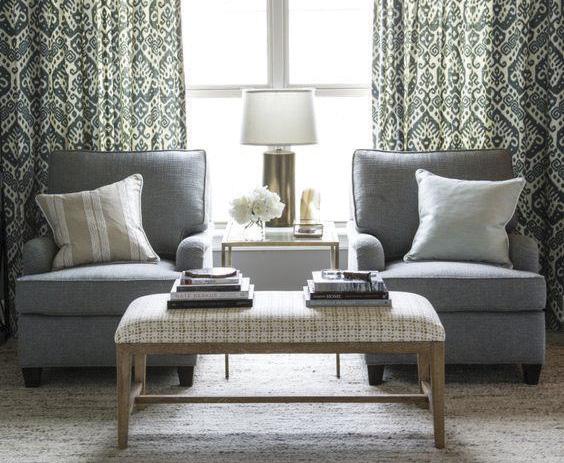


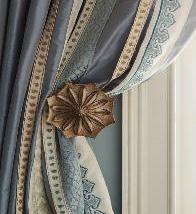


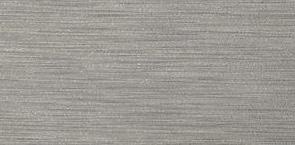

upstate HOUSE | SPRING 2024 • 59 CUSTOM WINDOW TREATMENTS 88 North Street, Pittsfield MA 01201 HunterDouglas Shades · Draperies · Fabric · Upholstery CUSTOM WINDOW TREATME NTS 88 North Street, Pittsfield MA 01201 413-448-6000 CWTBerkshire.com Bringing together all th e elements of design to transform your home or office into an inspired vision of style, elegance , and comfort. g Yoga Retreats Teacher Trainings Weekend Events Customized Experiences oga Classes STAY WITH US! STUDIO APARTMENT INCLUDES YOGA stonewaveyoga.com 845-419-5219 80 Miles North of Manhattan Hudson Valley Yoga Experience
The definitive guide to the Rural Intelligence region. Delivered directly to your inbox.
Subscribe today.
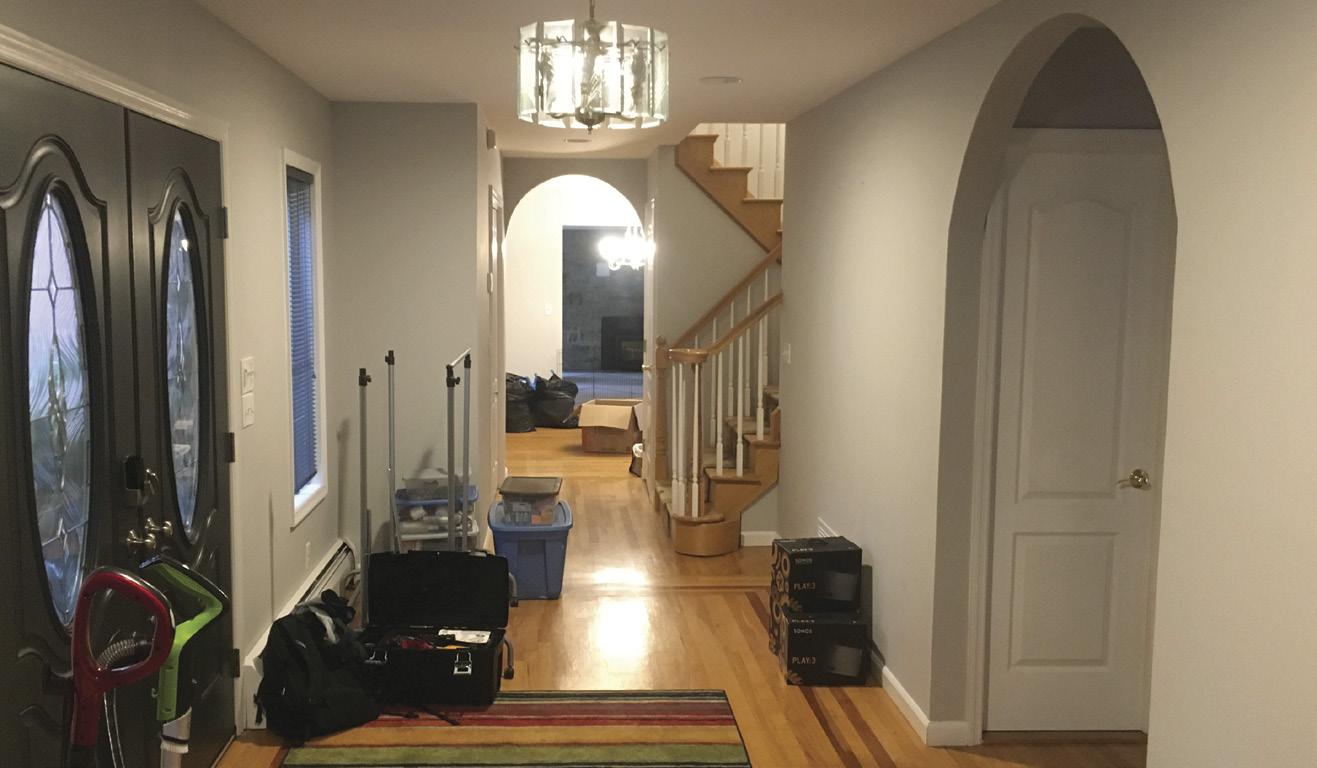
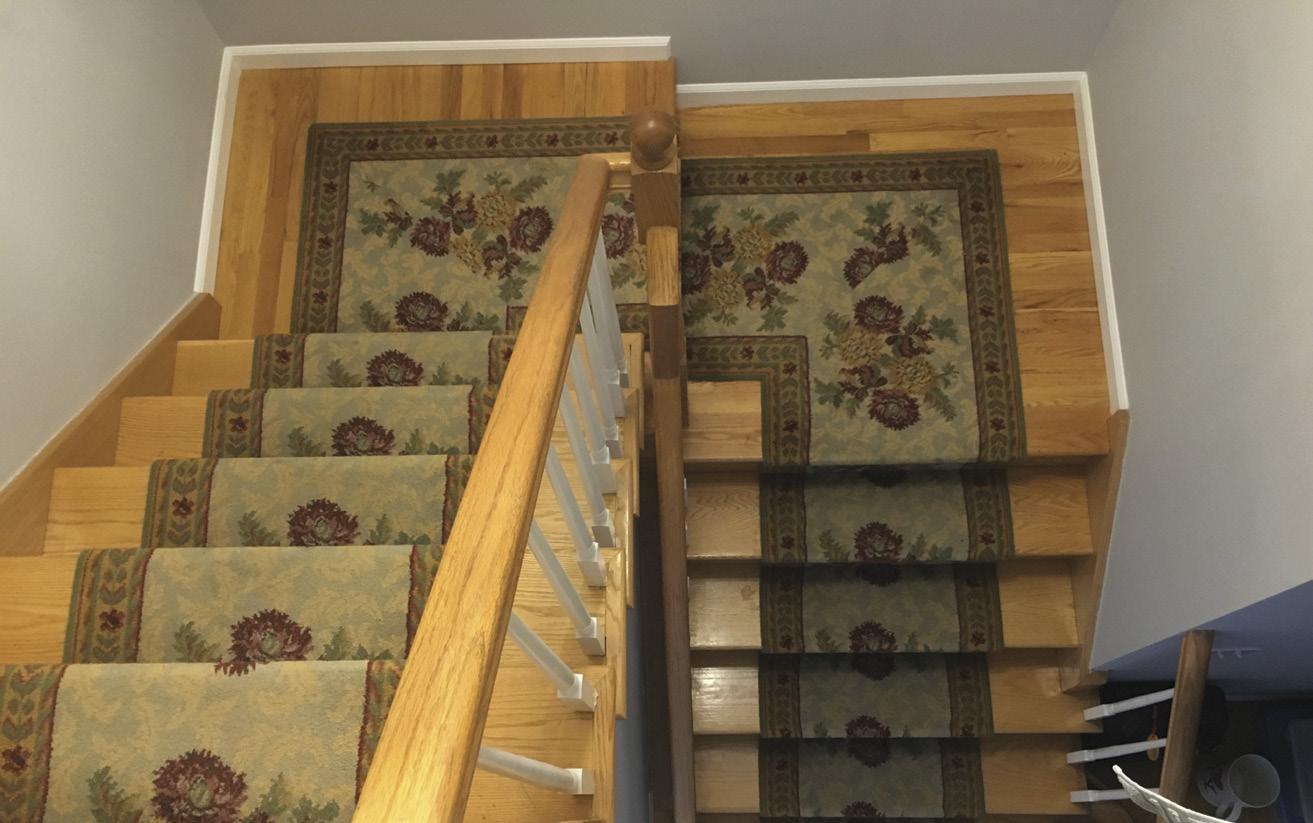
60 • online at upstatehouse.com



upstate HOUSE | SPRING 2024 • 61
The new staircase is crafted from the same steel as the sturdy beams and the same white oak as the floor. Steel beams define the space, offering the sophisticated look of a city loft.
Opposite: Prior to the renovation, the house’s was cut up into impractical spaces. A cumbersome staircase divided the upstairs floor into two tiny bedrooms and an overly large main bedroom.
Photos provided by Sigler Henderson Studio

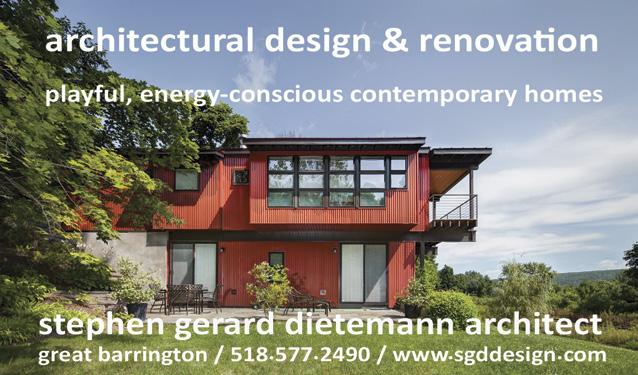
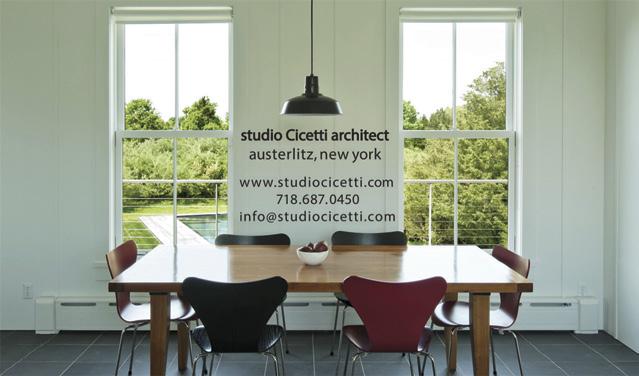










62 • online at upstatehouse.com COMPLETE GARDEN PROJECT MANAGEMENT DESIGN · BUILD · IMPLEMENT · RESTORE 845-443-1067 · Catskills · IG @hrvgardens · HRVGardens.com PAUL GOLDBACHER CIVIL & STRUCTURAL ENGINEERING l RESIDENTIAL l COMMERCIAL S T I N E M I R E E N G I N E E R I N G . C O M J O H N @ S T I N E M I R E E N G I N E E R I N G . C O M
JOHN E. STINEMIRE, P.E. OHN
www.alrci.com DESIGN AND PLANNING Residential Design Kitchen/Bath Design Construction Management Project Representation 413.528.4960 623 Main Street, Great Barrington, MA 01230 Christopher Blair
Photo by: Nils Schlebusch
One of the homeowners’ top priorities was that their new kitchen be central to the house. Multiple family members can now work together in the spacious kitchen, which features two dishwashers and two ovens.
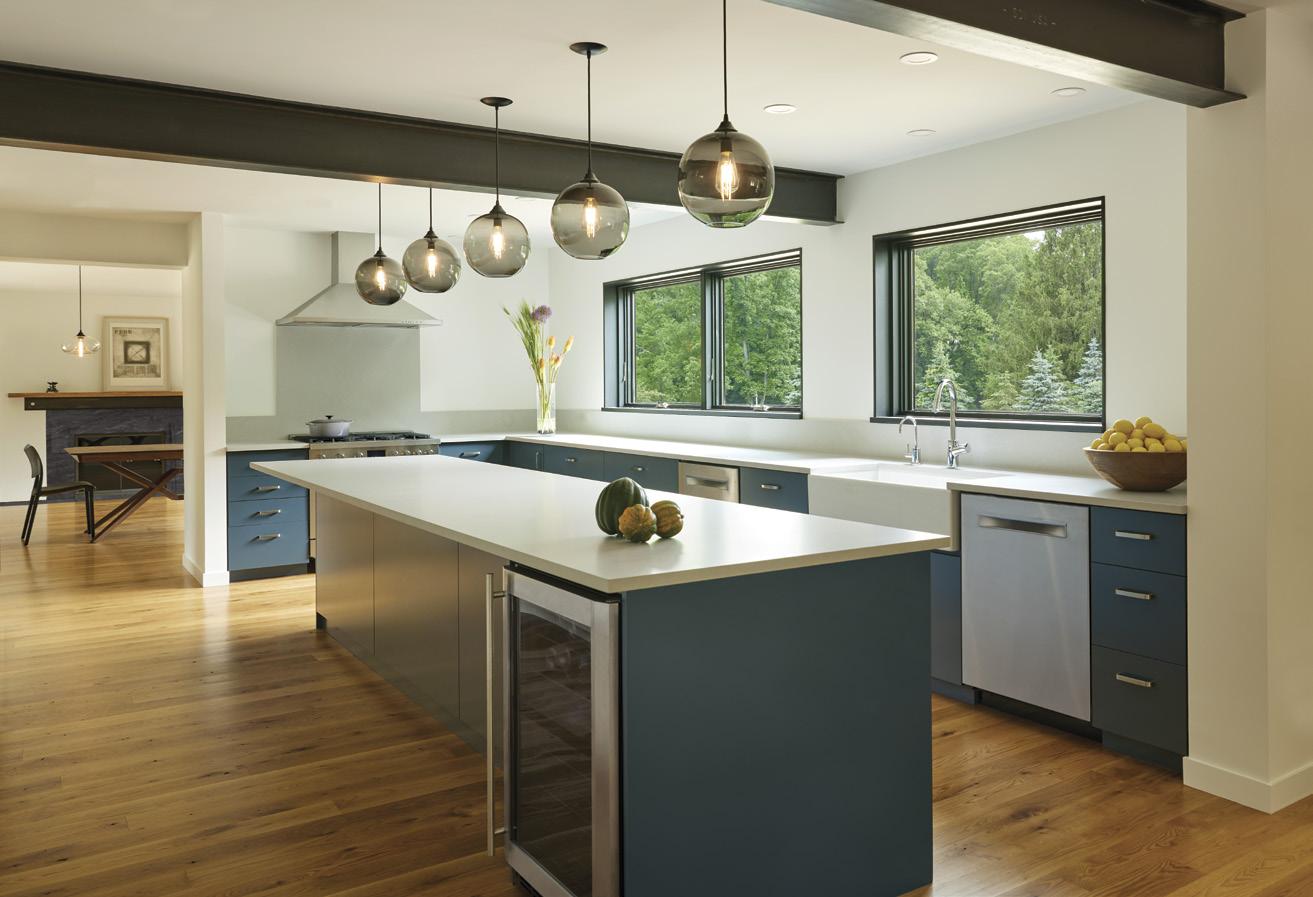
“They love to cook,” says Sigler. “Diana is an avid baker and the idea was that they wanted the kitchen to be central, but they wanted to see into the living room. We want to watch our daughter play the piano, they said, and we want to have this open space, so that we can all be connected in different rooms while doing different things.”
Sigler has found the open floorplan to be popular with families that have young children. “They want to be able to be in their kitchen and watch their kids playing,” says Sigler. “It lends itself to being a more open space. I think what we always try to do, ideally, is create flexible space that can be used in multiple ways that can change throughout the life of the house. Since Diana and Adam plan to live here for a long time, we created a guest suite on the first floor. If they want to live all on one floor in the distant future they can convert that to their bedroom and have an en suite bathroom.”
New Views
Making the most of the surrounding view meant adding more windows and replacing smaller ones. While the original kitchen only had one small window, the new kitchen features a long bank of windows with a view that overlooks the backyard pool and Clove Creek. “In the living room, the windows now start a foot above the floor, where
there’s an operable unit, and then there’s a fixed panel above,” says Henderson. “It really opened it up. Instead of just having these little high-up windows that were there before. There was literally one window crammed into a part of the kitchen over the sink that looked out in that direction, which is now the main view in both rooms.”
The best place to enjoy the view upstairs was previously occupied by a huge Jacuzzi. “That meant you couldn’t actually see out into the woods unless you were in the tub,” says Henderson. “And that bathroom is what we converted into their large bedroom.”
A deck was added off the primary suite, as well as an enclosed porch off the living room, an area for a kitchen garden, and a small terrace on which to savor morning coffee. “Now they have this expansive view and there’s also a deck off of that bedroom over the other deck,” says Henderson. “They can be outside in the landscape overlooking the pool, so they can watch their daughter and her friends and keep track of them.”
The home’s landscaping was updated with a focus on privacy, sound remediation, and the environment. Some of the yard was returned to its natural state, transforming the lawn into a meadow that attracts birds and bees. New plantings were designed to offer privacy from neighboring
homes and to help with noise reduction. Having purchased the home during the pandemic, when Route 9 was less busy, the homeowners did not realize how noisy the highway might otherwise be. “The client worked very closely with the landscape designer to create planting areas to buffer the noise from Route 9, which you can’t see from the house, but you can hear it,” says Henderson.
During a cleanup of the land’s wooded area, landscapers discovered and repaired old stone walls that now serve as a visual barrier between the active entertainment area and the preserved woods.
Perfect Harmony
The renovation also involved making the home more energy efficient. The oil boiler and gas water heater were replaced with air-source heat pumps for heating and cooling. The solar panels installed on the roof provide more than 75 percent of the home’s energy needs. The only fossil fuel used in the home is for the cooktop and the generator.
The Hirds were pleased with the renovation, completed in the summer of 2023. They were especially happy with the spacious kitchen. On Thanksgiving, 10 family members worked harmoniously in the kitchen at the same time. No one bumped into anyone else.
upstate HOUSE | SPRING 2024 • 63

MAXIMALIST MAGIC
Embrace the Shift Toward More-Is-More Design With Vibrant Paint Colors
Over the past decade, white walls, clean lines, and Scandinavian-inspired minimalism have dominated the interior design landscape. While the goes-withanything possibilities of white may never fully go out of style, the maximalist aesthetic is making a triumphant return.
“People are craving spaces that tell a story and resonate more deeply with their personalities,” says Kim Williams, SVP of Retail Operations at Williams Lumber and Home Centers, the go-to name for home improvement in the Hudson Valley since 1946. “Nowhere can this vibrant shift be seen more clearly than the Benjamin Moore Color Trends 2024 palette,” says Williams. “The color of the year, Blue Nova, and the other nine paint colors in this year’s palette have endless possibilities for adding depth and character to any space in your home.”
Here are a few tips from Williams for shaking up the design routine and using this year’s must-try Benjamin Moore paint colors at home.
A Palette of Possibilities
Blue Nova, an alluring mid-toned mix of blue and violet, serves
as the anchor for a well-balanced palette that leans heavily into color theory, with an emphasis on complementary colors that can be effortlessly paired together. The 10 colors in the palette also embody a sweet spot for anyone who is venturing outside of white for the first time in a few years.
“Softly saturated colors such as Topaz, Hazy Lilac, and Regency Green are among the standout hues in this palette, each offering an opportunity to infuse your home with boldyet-approachable color,” says Williams.
Since Blue Nova’s eye-catching duality invokes the etherealness of the night sky, Williams recommends using it as an accent wall in offices or in a bedroom to create a sanctuary space that is simultaneously grounding and energizing. Or pair it with furniture painted with radiant orange Topaz for a jeweltoned contrast that’s equally harmonious and on-trend.
For anyone whose go-to neutral is gray, Hazy Lilac—a gentle violet with gray undertones—offers a lighthearted step away that will still feel cozy and familiar. Looking for more drama? Regency Green, a deep piney hue verging on black, lends itself beautifully to accent pieces or an entire room transformation.
64 • online at upstatehouse.com SPONSORED
Blue Nova, Benjamin Moore’s 2024 Color of the Year, is an alluring mid-toned mix of blue and violet that anchors a well-balanced palette of softly saturated colors.
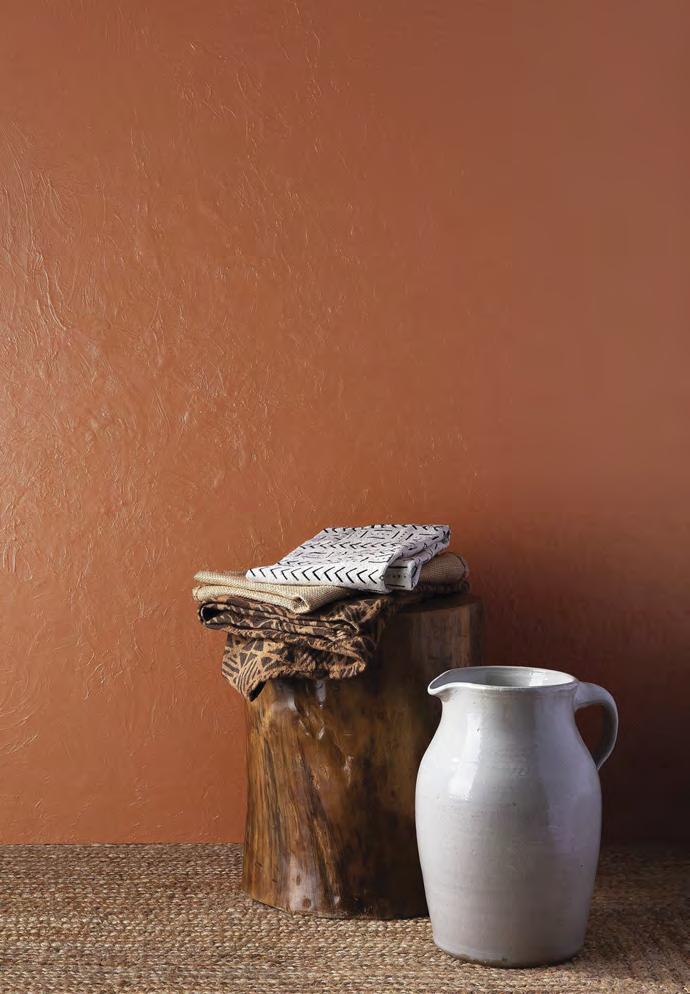

Don’t fear—whites are not off the table entirely. The palette also includes Pristine and White Dove, off-whites with warmer undertones that offer an easy changeup from the cool whites that have long been popular in home design. Lean into the dusty rose undertones of Pristine for a calming whole-room effect that reads as a soft pink or use White Dove on trim to give boldly colored walls a more classic appeal.
“What I love about this year’s palette is that it’s very well-balanced, and offers plenty of opportunities for homeowners to experiment and express their one-of-a-kind style,” Williams says.
A Colorful Journey Awaits
Stepping outside of the comfort zone that neutrals offer can be intimidating to say the least, but there’s no need to dive straight into the deep end.
statement. Saturated colors can also be used to add depth to the rest of a home’s color palette by painting interior doors, cabinets, and trim an unexpected hue.
Before heading to Williams to grab those samples, use Benjamin Moore’s Color Portfolio app to try on any of the colors in any room. “The app is great for comparing colors from the comfort of your home.
After you’ve selected your perfect new color, you can order the paint online and come pick it up at any of our seven locations, including our two design centers in Pleasant Valley and Rhinebeck,” says Williams.
“Benjamin Moore prioritizes working directly with small businesses by selling exclusively through locally owned and operated stores like ours,” she says. “No matter which of their gorgeous colors you’re considering, our knowledgeable and friendly paint staff can help guide you through your project and make sure you have the right materials and know-how for any job.”
If the idea of painting a large room a bold new hue feels like too much, a simple pop of color can also go a long way. Smaller spaces like a half bath, hall, or built-ins offer an easy opportunity to play with color without commiting to a major Produced by the Chronogram Media Branded Content Studio.
upstate HOUSE | SPRING 2024 • 65 WILLIAMSLUMBER.COM
The goes-with-anything possibilities of white may never go out of style, but bold paint colors such as Benjamin Moore’s Topaz (left) and Hazy Violet (right) are making waves with homeowners looking to add depth and character to their interiors.
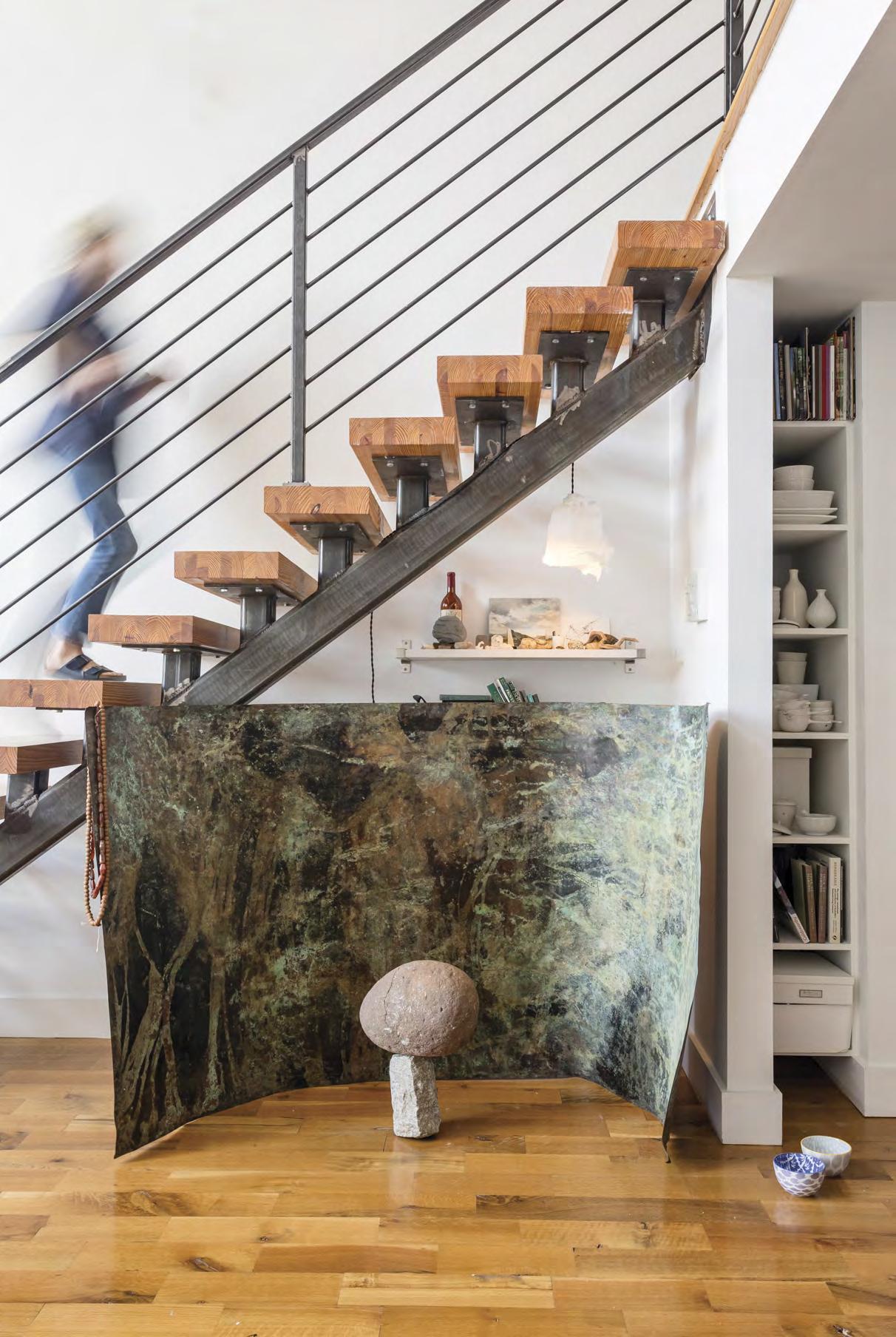

66 • online at upstatehouse.com PROFILE

“And I’m
the lookout for good striped rocks.” She also collects driftwood, shells, and fibers and adds them to her mementos. “My collection are little encyclopedias—a snapshot of the moment and time it was created and how it survived crossing my path,” she says. “It’s a constant riddle or puzzle: What conditions gave rise to this? Is it a tool? Is it a rock? Is it a fossil?”
Opposite: Amy Pilkington’s Beacon loft is filled with both her art and scavenged finds. Here, she’s paired one of her paintings with cantilevered, balanced rocks. She colored the copper sheet by treating it with alternating layers of chemicals and wax. “I love the sculptural quality it’s taken,” she explains. “It used to hang on the wall, now it stands on its own protecting its massive but precarious stone cohort.” She calls the rock sculpture The Tippies. “It’s sort of a love story,” she explains of the evolving display.
FINDERS KEEPERS
By Mary Armstrong
Photos by Winona Barton-Ballentine
upstate HOUSE | SPRING 2024 • 67
Artist Amy Pilkington’s live-work loft in Beacon
Above: A collection of Pilkington’s found objects on display in her studio. She found many of the objects on nature walks where she hunts for inspiration. “Some days I gather all white rocks to see the color variations, other days I’m hunting for heart rocks,” she says.
always on

My sister calls me the magpie,” says Amy Pilkington, of her lifelong tendency to find eye-catching objects and squirrel them away. “I’m just always collecting, and finding things everywhere.” On display throughout the bright interior of her two-story, openconcept loft (itself a great find), her salmagundi of treasures gleams in the sunlight spilling from floor to ceiling windows. Pilkington plucked most of her finds while walking along the waterways of the world, but also diving through dumpsters and mining her family ’s history for bits of faded glamor (and the tales to go with it).
In Plinkington’s orbit, the flotsam she’s gathered comes to life. Striped rocks, placed just so, tenderly nuzzle each other. A mass of entangled roots becomes a quarter horse grazing out to pasture. The graceful torso of a woman is frozen in a trunk of driftwood, as if the gods suddenly transformed her into a tree to preserve her virtue. “I think actually she looks like she has to pee,” says Pilkington of the found sculpture propped up in the corner of her studio. (Across the walkway from her loft, another great find. )
Both her apartment and studio look out over a 12-acre mixeduse complex along the Fishkill Creek. Once a textile mill, the brick, industrial complex is the center of a thriving community with 200 loft apartments and studios, a shared garden, and
meeting spaces. With about half of the residents working in the creative arts, Pilkington fits right in. “It’s a blend of industrial and functional with a dash of elegance and humor,” she says of her evolving constellation of spaces. “I enjoy playing with the surfaces and reflections that make objects come to life at different times. I enjoy the sparkle factor. “
From the Fishkill Creek to the River Murray
A native of Australia, Pilkington’s keen eye for the natural world grew from her early connection to horses. “I started riding when I was very young,” explains Pilkington. “I’d spend weekends riding through the outback with my pony. I loved being out in the wilderness and started picking up rocks and trekking them back home.” When she was 11 Pilkington’s father took a job in New York City and the family moved from their home in Melbourne to Connecticut. Through her school years at the Greenwich Academy and then Northwestern University, she developed her eye for design motifs, collecting antique Tibetan textiles.
At the Savannah College of Art and Design, Pilkington honed her specialty of metalsmithing and jewelry making and then landed a plum gig with Ralph Lauren. “I was commissioned to create a bronze horse that looked like it was found in a Parisian flea market,” she explains. It was a perfect synthesis of her
In Pilkington’s mezzanine bedroom, a metal-framed bed is covered with natural flax and naturally stripped linens handcrafted by her downstairs neighbor Jason Evege at his Peekskill-based linen company Linoto. The paintings on either side of the bed are by her grandfather, the Australian artist Ron Skate.
68 • online at upstatehouse.com
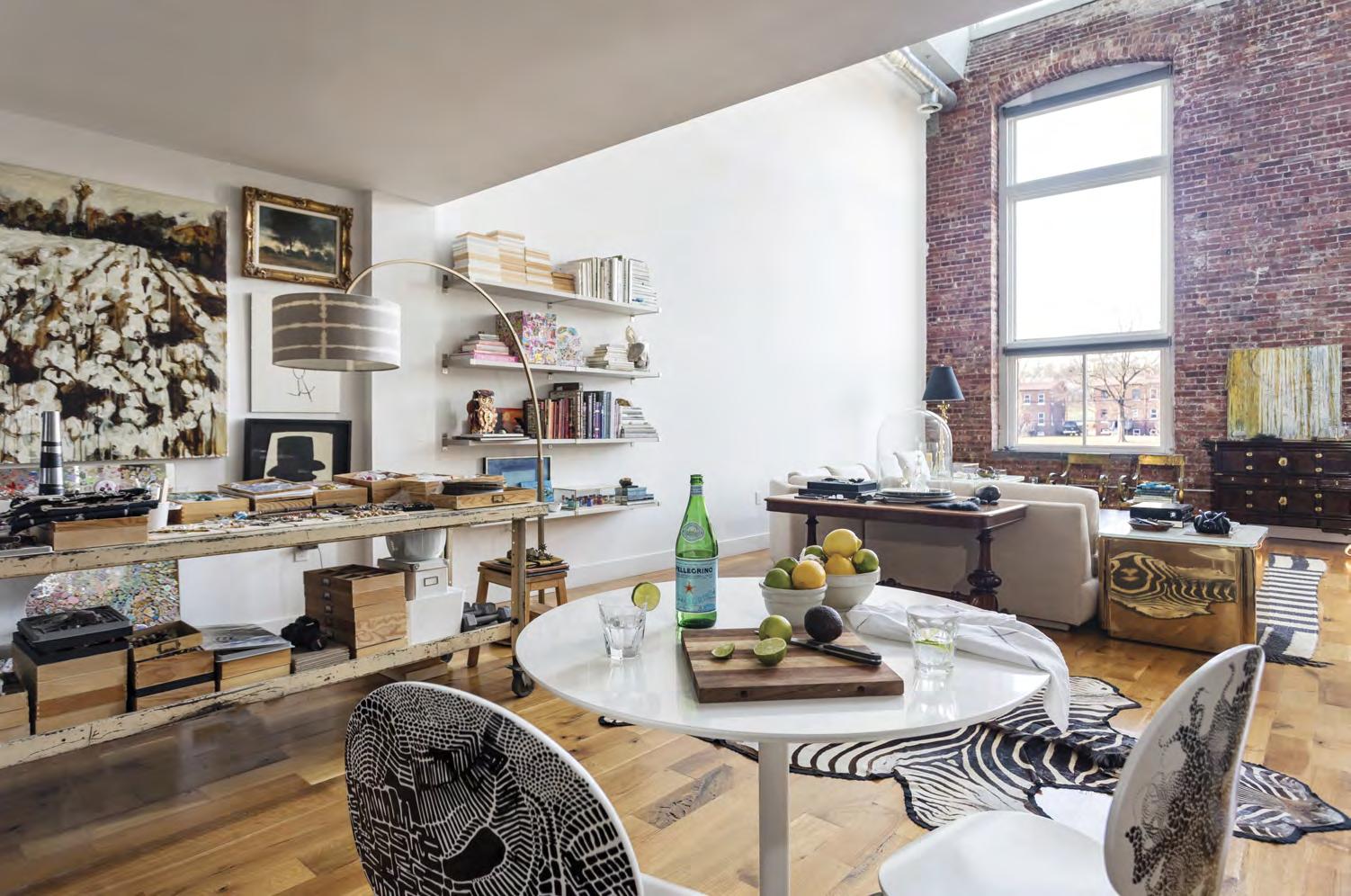
On Pilkington’s open-concept first floor there’s room enough for living, dining, a nook kitchen and a giant work table. Throughout, she’s matched furniture inherited from family with pieces she’s rescued from the garbage. “I love a good Dumpster dive,” she explains. She found the kitchen chairs on Facebook Marketplace. “They weren’t what I expected,” she says. “I brought them home anyway and began doodling on them with oil-based Sharpies. I love the saturated, dimensional line.” On the wall, a moody landscape by her grandfather is paired with a painting of a large cotton field by artist Wendy Martin. Her sister drew the chicken sketch below.
interests—horses, flea market cast-offs, and metal craft—and the project was a success. “It’s still in their stores throughout the world.“
From there Pilkington’s career was off—she was able to become a full-time jewelry artist and develop her other creative pursuits. “I’m a multidisciplinary artist, sculptor, metalsmith, and jeweler but I also fell in love with textiles and found objects along the way,” she explains. “I‘ve always been fascinated by how to put things together and take them apart creating new things.“ Her creative career took her from Savannah to Manhattan and then out to East Hampton where she helped design and run the Elaine De Kooning House artist residency for 15 years.
Shaggy Dog Scavenger Hunt
During Pilkington’s time in the Hamptons she rediscovered her early love of wild foraging when she adopted her Italian greyhound, Pippa. “She was so hyper that I’d have to walk her for hours on the beach to calm her down,” she says. “It thought that I might as well do something while I was walking, so I brought a bag and began to collect things.”
She began collecting foliated granite rocks with fossilized stripes through the center. She also developed an eye for driftwood, as well as an appreciation for the detritus brought
in by the tide, both natural and man-made. ““I’m very curious and get inspired while exploring and collecting things,” she says. “It’s fascinating to me how natural colors and patterns combine with such beauty, genius and humor.”
Pilkington’s collections began t,o amass—and then to synthesize. Her finds started making their way into both her work and her decor. “I’d been making jewelry for so long and collecting gemstones,” she says. “And then it occurred to me, ‘what if I just put them all together? Like, wouldn’t that be so crazy?’”
The High and the Low of it
Pilkington found her way upstate in 2018 to be closer to her sister and nephew. “I was looking to live within an hour of Greenwich so my nephew could visit,” she says. “A friend had just moved to one of the lofts here and suggested I look. I was extremely fortunate to find a wonderful bright loft and a large street level workshop. ” Built in 1876 as the Groveville Carpet Mill, the row factory building, workers’ housing, and gate house successively morphed to manufacture fabric, furniture, and embroidery through the 20th century. Over the Fishkill Creek the hydroelectric spillway dam once powered the factory and is still functioning. In 2012 the property was reinvented as a live-work housing complex with modern lofts, workshop studios and office space.
upstate HOUSE | SPRING 2024 • 69
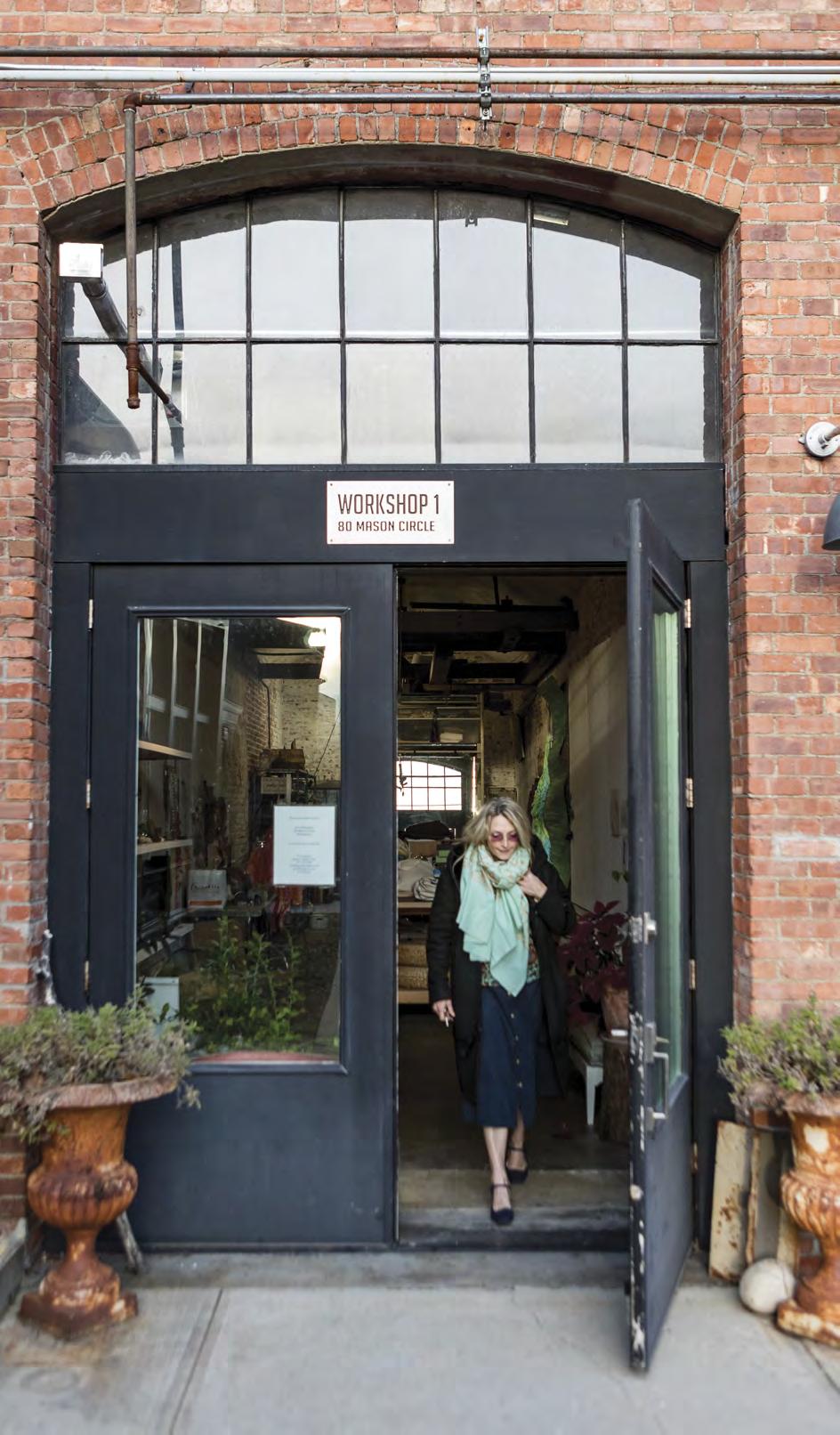

70 • online at upstatehouse.com
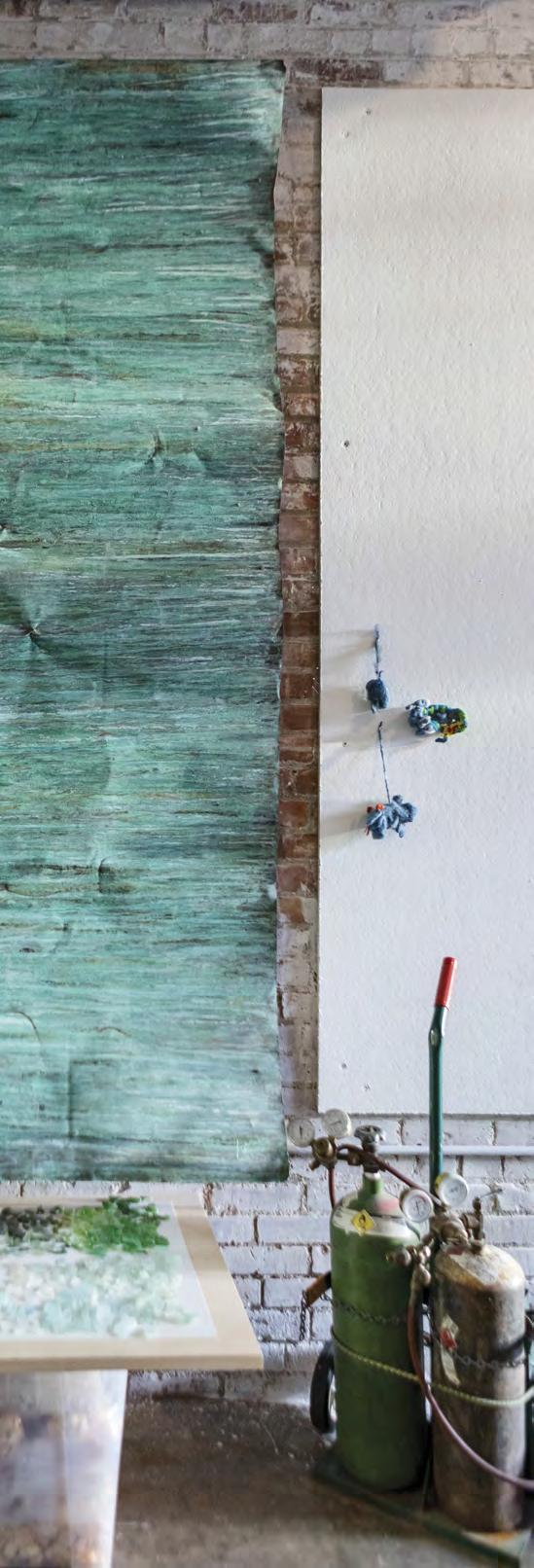

Hanging in Pilkington’s studio, another sheet of copper is a 14-year work-inprogress. “The color is derived from a mix of vapor and chemical patinas,” she says. The green is matched with her collection of river glass gleaned from walks along the Hudson.
One of Pilkington’s rocks engraved with circles sits with a silver shell and a pendant that reminds Pilkington of a map to a galaxy. “There’s no deliberate intention to the patterns,” she says. “But I feel as though it’s a language I have yet to understand or recall. “
upstate HOUSE | SPRING 2024 • 71
From left: Pilkington’s studio sits in an adjacent building that was once part of the hydroelectric power plant for the larger mill. She continues the space’s history with her own type of creative industry. “My art is an interactive experience,” she says. “It grows and evolves at it lives beside me.”

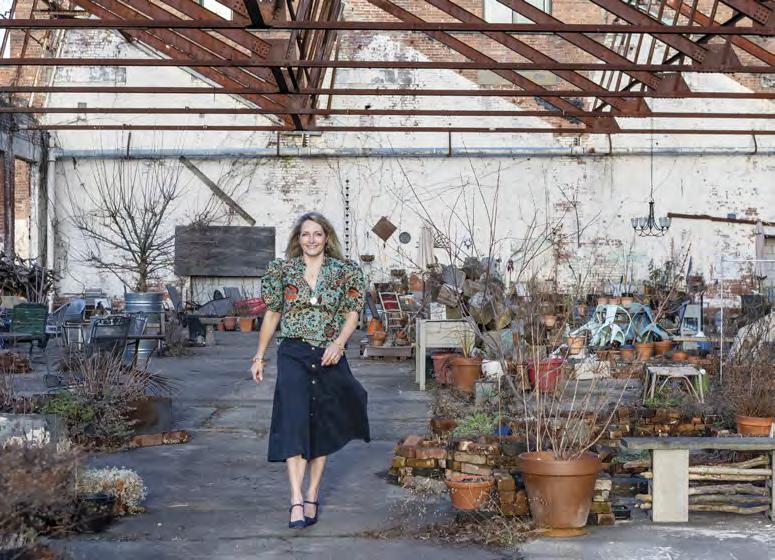
In Pilkington’s apartment exposed brick, sky-high two story ceilings, and exposed metal piping lend an air of industry, but her distinct sense of creative whimsy spills out along the edges “My aesthetic is derived for my passion for found treasures mixed with my collection of vintage steel pieces and furniture I’ve inherited from family,” she explains.
Pilkington grounded the first floor sitting area with an oversized, 1960s down sectional and brass end tables from her stepfather, then searched high and low for a coffee table that had the gravitas to match. “I couldn’t find anything that was the right style or dimensions,” she says. “I wanted it to look like it was floating, so it wasn’t too heavy,” says Pilkington. “But it needed to be the right style and dimensions.” She commissioned her neighbor to create a large coffee table frame out of scrap wood and then finished the wood surface with sanded layers of burnished wax and graphite. The piece’s art-fromtrash elegance is classic Pilkington. “The screws and imperfections are all visible but are elevated by the silky lacquer-like finish,” she says. “It’s the ultimate high-low piece. “
An oversized workbench, a gift from her sister, dwarfs the first floor dining area and is piled high with Pilkington’s workin-progress jewlery. Recently, a trip back to Savannah resulted in a collection of various shark teeth which she’s transforming into rugged, elegant pendants. Collections of beads, shells and metal work are all in the painstaking process of being assembled to tell a color story. On the facing wall,landscape paintings by her grandfather, the painter Ronald Skate, depict the Australian countryside from a century ago.
All at Once
Throughout the second floor mezzanine, Pilkington’s textile collections give the space a softer feel. A commission from a hotel out west led her to experiment with fabric dye motifs. Pilkington paired some of those results with textiles from a neighbors linenware line and fabric saved from her youth, then matched it with an iron canopy bed from her sister. Coffee table books—another growing collection—line the metal balcony rails and paintings from her grandfather ’s travels hang on the walls.
Outside, across the complex driveway, Pilkington’s studio reaches from the sunny street deep into the factory bowels. Curved glass double doors open onto a foyer brimming with plants. Another stretch of workbench extends under the high domed roof. Shelves run along the brick walls back to a wet room covered with art, artifacts, and natural treasure.
As Pilkington handles each piece, she tells its story. Each rock has a name, a feeling and an expression of delight or disgust. A piece of driftwood is a man weeping into a tree. As soon as Pilkington tells it, each piece immediately springs to life with the story she’s given it, and you believe her. The stories becomes hard to un-see. “I’ve always made things,” she explains. “Everything and nothing all at once. ”
Top: The complex housing Pilkington’s loft was originally the Groveville Carpet Mill, manufacturing carpets, textiles, and furniture throughout the 20th century. It was renovated into a mixed-use campus in 2012.
Bottom: Residents took the shell of an onsite warehouse and transformed it into a community garden. “It’s been my sanity, my outlet, my gym membership, and occasionally my dog sitter,” she explains. “I have a difficult time sitting when I’m in it. I’m usually fussing about all the plants—what’s going and what’s not.
72 • online at upstatehouse.com


The Quarterly Magazine of Inspired Homes Only $5 per single-issue or $18 for a one year! Subscribe today CHRONOGRAMMEDIA.COM/SUBSCRIBE
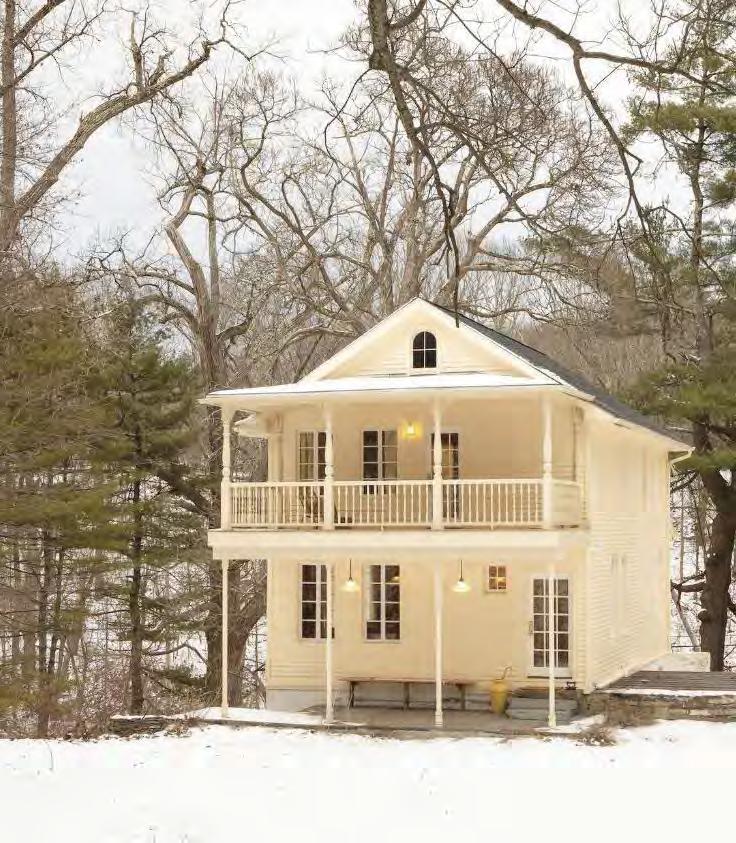



WWW.FOURSEASONSSIR.COM/HUDSONVALLEY Discover the Art of Home Each office is independently owned and operated. The Catalpa House | Kingston, New York O: 845.876.5100





Work with the #1 independent real estate brokerage in the Hudson Valley and Catskills! You’re closer than you think to finding your dream home, and we can make that dream a reality. Thinking of selling? With high buyer interest in the area and historically low inventory, there’s never been a better time to sell. Our team of leading real estate professionals will give you the individual attention you deserve. Call or click to get started!>




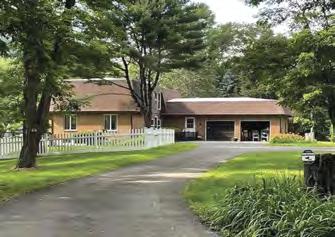
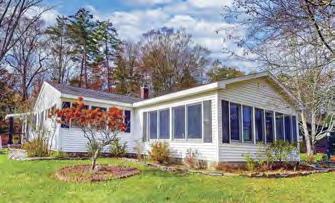
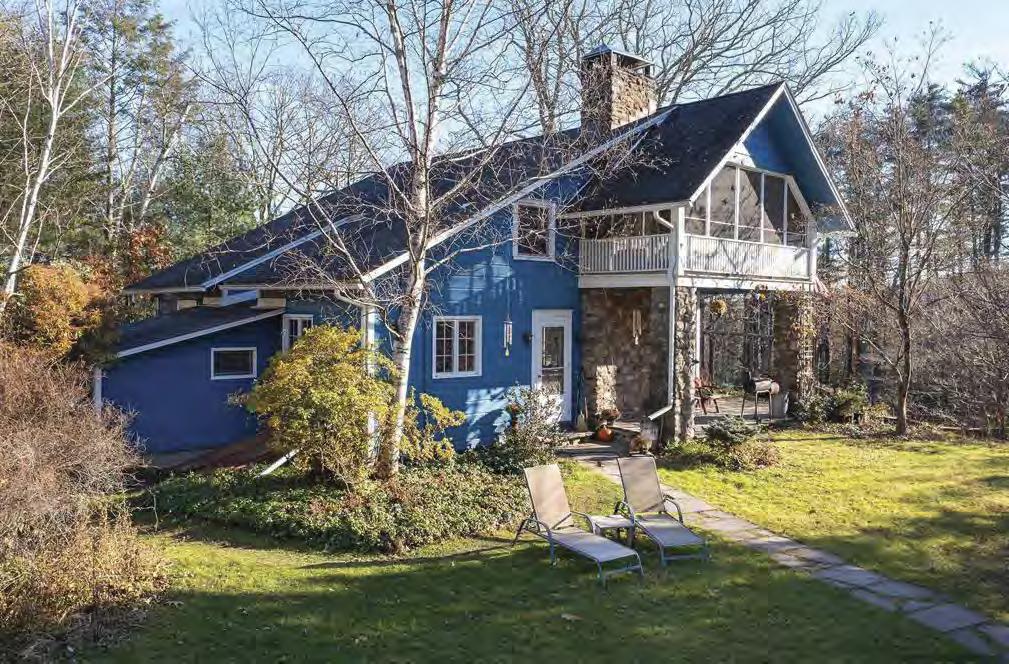


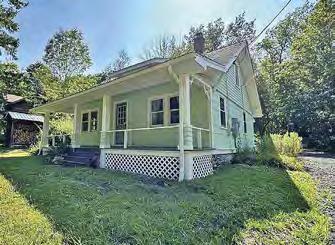
upstate HOUSE | SPRING 2024 • 75
HIGH FALLS $749,000
WOODSTOCK $549,000
SAUGERTIES $750,000 6.86 ACRES
SAUGERTIES $575,000
KINGSTON $1,150,000 COMMERCIAL
WOODSTOCK $575,000
WAWARSING $599,000 COMMERCIAL
CHICHESTER $435,000
WOODSTOCK 845 679-2010 I KINGSTON 845 331-3110 I HALTERASSOCIATESREALTY.COM
WOODSTOCK $879,000
WOODSTOCK $999,000




MOVE IN CONTEMPORARY RESIDENCE IN HUDSON
Redesigned and rebuilt in 2021, this sleek renovated house has open and bright living spaces, all new siding, roof, windows and doors, utilities, HVAC, and hardwood floors throughout. Stunning living room with custom paneled wall opens to dining area and wellappointed kitchen. Handcrafted staircase leads to vaulted second floor. With a private fenced back yard and patio, as well as a private driveway, this is an ideal home in town… $699,000




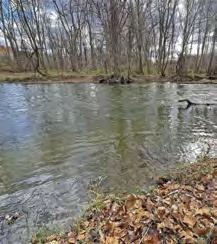
MAGICAL PRIVATE ECO-FRIENDLY HOMESTEAD, SOUTHERN COLUMBIA
Centered on 17 acres, the distinctive 3,000 sf passive solar home overlooks the wide Roe Jan trout stream to the east and organic vegetable and berry gardens, orchards, gazebo, and fertile meadows to the west. Home connects upper dramatic open living areas and lower bedroom areas using a spectacular atrium consisting of south facing windows backed by a massive brick thermal storage chimney and fireplace. Includes attached apartment, greenhouse, garage, and barn. In a highly desirable location, surrounded by hundreds of acres of conserved farmland, it’s 15 minutes to Rhinebeck or Hudson, two hours NYC… $1,350,000



76 • online at upstatehouse.com
Artfully uniting extraordinary homes with extraordinary lives. DEWAYNE A. POWELL REAL ESTATE SALESPERSON LICENSED IN NY, MA & CT 2 Park Row, Suite 1 Chatham, NY 12037 M 917.748.5100 dpowell@wpsir.com Each o ce is independently owned and operated. Hudson Valley real estate, events, and dining highlights delivered directly to your inbox. Sign up today: chronogram.com/eatplaystay LIVE YOUR BEST UPSTATE LIFE EAT PLAY STAY NEWSLETTER


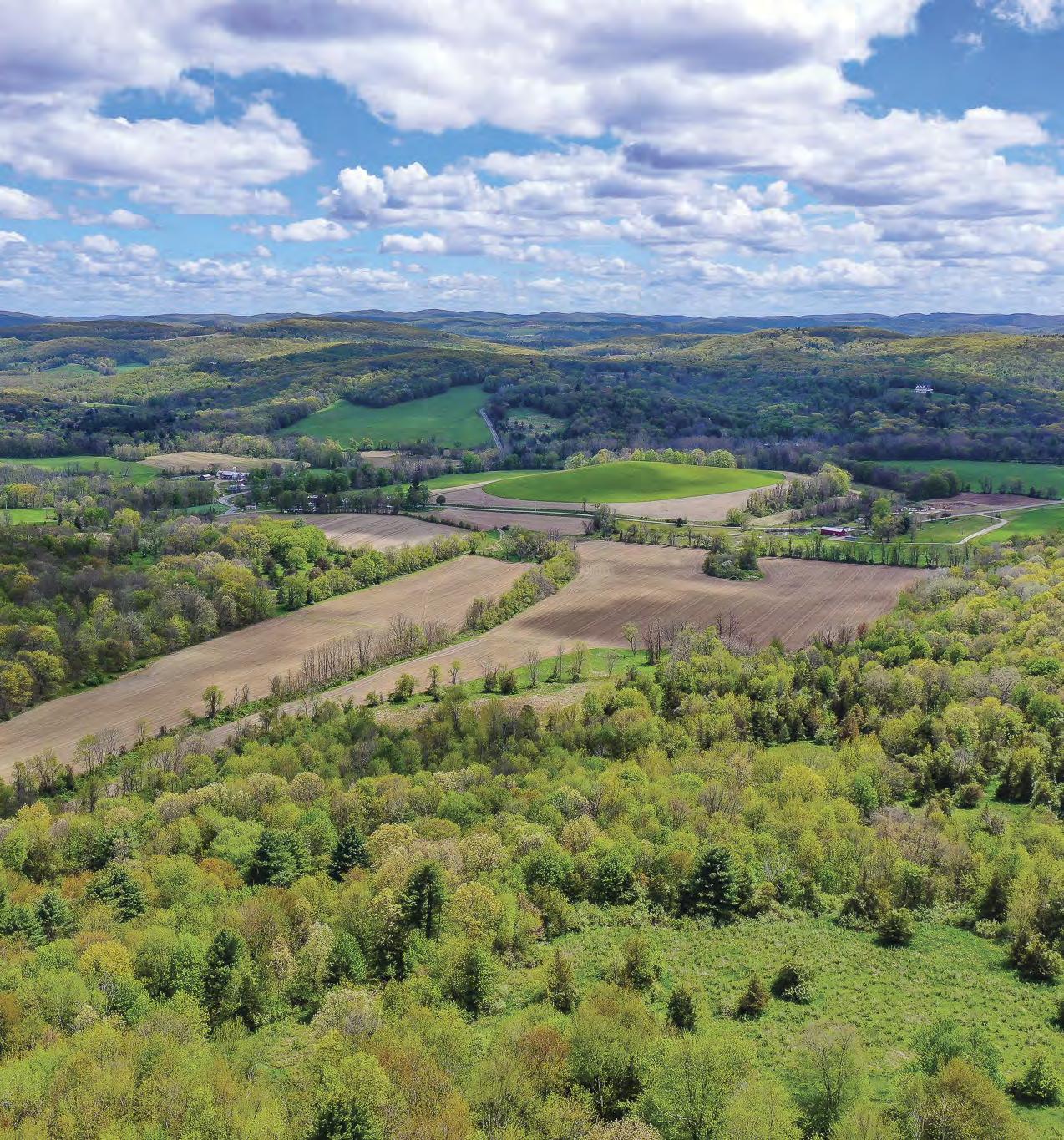
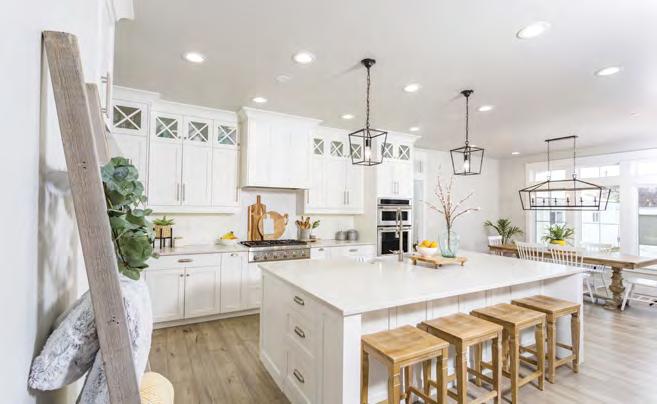
upstate HOUSE | SPRING 2024 • 77 Each Office is Independently Owned and Operated CHATHAM BROKERAGE 2 Park Row, Suite 1 • Chatham, NY 12037 +1 518.392.0244 williampitt.com WORK WITH US AND DISCOVER WHAT’S NEXT. Let us help you navigate your real estate journey with confidence.



CT MA Liberty Warwick Harriman Cornwall-on-Hudson Tarrytown New City Nyack Stony Point ULSTER DUTCHESS SULLIVAN DELAWARE GREENE COLUMBIA ORANGE PUTNAM WESTCHESTER ROCKLAND Saugerties Hyde Park Rhinebeck Red Hook Kingston Woodstock Ellenville Poughkeepsie Beacon Peekskill LaGrange Millbrook Newburgh Middletown Millerton Pawling Wappingers Falls Stone Ridge New Paltz Phoenicia Ashokan Fallsburg Shandaken Margaretville Fleishmanns Hunter Catskill Coxsackie Kinderhook Hudson Chatham Ghent Livingston Cairo Windham Highland Monticello Thompson Croton-on-Hudson Ossining Yorktown Heights Sharon Kent Salisbury Danbury Pittsfield Lenox Stockbridge She eld Adirondack Design 50 Arnoff Moving and Storage 23 Associated Lightning Rod Co. 62 Atrium Interiors 23 Augustine Landscaping & Nursery 36 Blejer Architecture 49 Brown Harris Stevens 79 Cabinet Designers, Inc 28 CB Design / Build 15 Christopher Blair Design+Planning 62 Claverack Pump Service, LLC 23 Crimson-Catskills 59 Custom Window Treatments 59 Dandelion Energy inside back cover Davis Frame and Panel Co 7 DBO Home 62 DeWayne Powell 76 Energy Catalyst Technologies 16 EvolveD Interiors & Design Showroom LLC 46 Finch 15 Four Seasons Sotheby’s International Realty 74 Glenn’s Wood Sheds 36 Halter Associates Realty 75 Hammertown Barn 19 Handcrafted Builders Inc 20 Clement, Brooks, Safir Team at Berkshire Hathaway Home Services Hudson Valley front cover Herrington’s 5 Hippo’s Home Entertainment 26 Hot Water Solutions, Inc. 1, 25 Hudson Home 45 Hudson River Valley Gardens 62 Hudson Valley Building and Restoration 59 Hudson Valley Kitchen Design Center 49 Hudson Valley Native Landscaping 36 Hudson Valley Trailworks 26 Janson Scuro 50 Lauren Wegel Architect 50 LDR Group 45 Lighthouse Solar 49 Liz Lipkin Interiors 49 Mihai Radu Architects PLLC 50 Milan Case Study 46 Modern Shacks 2 Montana Home Builders 24 Murray Engineering 3 New Energy Works 11 Peggy Lampman Real Estate 76 Phinney Design Group 45 Pioneer Millworks 16, 25 Quatrefoil 19 Rennie Cantine Overlook Benches 36 River Architects 24 Roman Power LLC 46 S3 Architecture LLC (Upstate Modernist) 11 Scott Swimming Pools Inc back cover Sheeley Roofing 20 Stephen Gerard Dietemann Architecture 62 Stinemire Engineering 62 Stone Ridge Electric Co., Inc. 20 Stone Wave Yoga 59 Studio Cicetti Architecture 62 Tip Top Furniture Flooring and Bedding 46 Whalen Architecture 62 William Pitt Sotheby’s International Realty - Chatham 77 Williams Lumber & Home Center inside front cover, 65 William Wallace Construction 28 Worth Preserving 25 INDEX OF ADVERTISERS MAP OF THE REGION INDEX OF ADVERTISERS


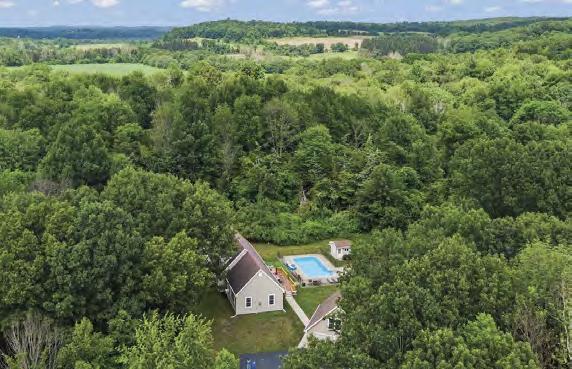



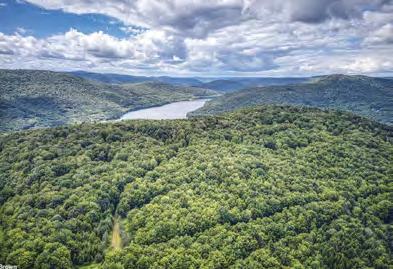
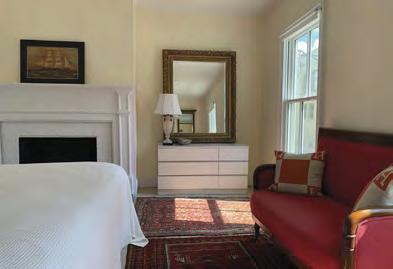
Richard
Nancy
upstate HOUSE | SPRING 2024 • 79 1 2 3 4 5 7 6 8 Mastery of the Craft. It’s Timeless.
HISTORIC KINDERHOOK 26 Chatham Street Kinderhook, NY. 3BR. 2.5 Bath. $649K. Web ID 22644528.
Olsen 718-613-2059
OWN THE ENTIRE MOUNTAIN! State Route 97. Narrowsburg, NY. 370 Acres Land Opportunity. $2.95M. Web ID 22727685.
1.
Scott
2.
Orenstein 212-381-4248
De Chabris 212-381-6513 3. TRANQUIL HAVEN Catskill Road View Claverack, NY. 4BR. 2.0 Baths. $799K. Web ID 22430784.
Felcetto 917-626-6755 4. SERENE, QUIET, & CUSTOM 165 Vaughn Hill Road Middleburgh, NY. 5BR. 3.0 Baths $1.895M. Web ID 22507389.
Orenstein 212-381-4248
Felicia
Nancy
Richard
Felcetto 917-626-6755 5. CONTEMPORARY STYLE 439 Lake Drive Rhinebeck, NY. 6BR. 7.5 Baths. $838K. Web ID 22476081. Marc Wisotsky 718-613-2047 Jackie Lew 718-613-2046 6. HEART OF THE CATSKILLS Brower Hill Road Accord, NY. 150 Acres. $625K. Web ID 22692757. Kathleen M. Sloane 212-906-9258 7. WORLD CLASS FLY FISHING 2215 Beaverkill Road Livingston Manor, NY. 4BR. 3.5 Baths. $525K. Web ID 22712924. Kathleen M. Sloane 212-906-9258 8. PEAK SEASON IN HUDSON 17 South 6th Street Hudson, NY. 3BR. 1.5 Baths. $7k/month. Web ID 22644458. Owen Davidson 917-783-2009 All information is from sources deemed reliable but is subject to errors, omissions, changes in price, prior sale or withdrawal without notice. All rights to content, photographs and graphics reserved to Broker.



PLANE AND SIMPLE CARVING COMMUNITY WITH KEZUROU-KAI
By Lindsay Peyton
The Japanese word kezurou-kai roughly translates as “planing group.” It refers to a community of Japanese woodworkers who gather for tournaments using traditional hand planes to shave sheets of wood so thin that a piece of rice paper would be envious.
The model came stateside, with the formation of nonprofit Kezurou-kai USA in the early 2000s. After attending the group’s first event, Andrew Hunter, a furniture maker in Accord, fell in love with the concept. He sold his Western tools and pledged instead to work with the handcrafted steel blades and centuries-old techniques found in Japan.
For years, most of the Kezurou-kai, or “Kez,” activity has centered in California’s Bay Area, with classes, events, and a once-a-year contest. More recently, a couple of happenings sprouted up on the East Coast, primarily in Brooklyn.
Now, Hunter is bringing Kez to Kingston, partnering with the custom cabinetry studio, Rowan Woodwork. Owner Suzanne Walton has long focused on connecting craft and community. “For me, it’s always been, ‘Let’s open the doors. Let’s invite everyone in,’” she says.
After a brainstorming session, Walton and Hunter decided to offer a monthly Kez night,
part social club, part woodworking, a bit of tool sharpening and a little competitive showcasing of craftsmanship. “We’ve had one a month for the past 15 months,” Walton says. “And it’s just growing and growing and growing.”
What started with a handful of people now averages around 50 participants. The studio is filled with all ages and all levels of experience. The goal is to build an accessible and inclusive creative space.
The Kez nights start at 5:30pm the first Friday of the month at Rowan Woodwork, 40 Clarendon Avenue in Kingston. Pizza and beer are provided, as well as tools and wood, though you are encouraged to bring your own hand plane. Small donations are appreciated for the snacks.
No prior woodworking knowledge is required to attend. All you need is an interest in wood and a desire to learn. “We’re building up from scratch,” Hunter said. “That includes starting with the very basics of sharpening.”
Betsy Gude, managing director of development at the Council on Foreign Relations, has attended two events, driving down from Tannersville. Having taken woodworking classes before, she was eager to check out the offering in Kingston. She most enjoyed the camaraderie around a common interest. “Everyone
wanders around and talks to each other,” she says. “And there were interesting stories on all fronts.”
Kate Hawes, a woodworker in Bearsville and instructor at Kingston’s Wooden Boat School at the Hudson River Maritime Museum, has headed to the Kez night a few times. “At the first one, I was really amazed at the combination of socializing and people really into tools,” Hawes says. “It’s a very rare thing. It’s usually one or the other. This is kind of meet and mingle, and yet you can sit there and sharpen your blade at the same time.”
Walton and Hunter hope that hosting their Kez will spark more interest in the traditional Japanese woodworking skills that are fading away in the face of industrialization and mass production. “How do we keep this alive?” Walton asks. “We’re both super concerned about who’s going to do this next.”
It’s already catching on in Kingston. In fact, Kez attendance is currently capped at 50 people and fills up quickly each month. Reserve your spot online at Rowanwoodwork.com/events. And mark your calendars—Rowan Woodwork will host the Kezuroukai USA 2024 national event in Kingston in October.
80 • online at upstatehouse.com
ROWANWOODWORK.COM/EVENTS BACK PORCH
Participants at a recent Kezurou-kai group planing gathering at Rowan Woodwork in Kingston.





Upgrade your peace of mind with Dandelion heating and cooling
New Yorkers are eligible for some of the nation’s best rebates. Take advantage of unprecedented incentives before they run out.
Cost Savings






Save up to 50% on your heating and cooling bills
High Efficiency
Dandelion’s ground source heat pumps are 4x as efficient as heating with oil, propane, or natural gas
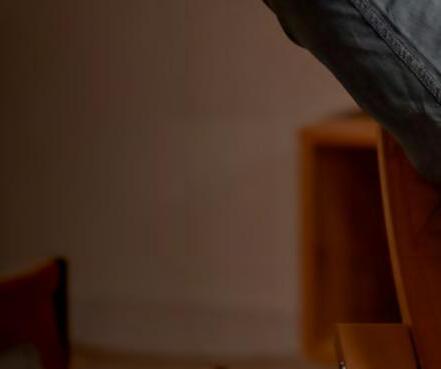
Low-Maintenance
With expected lifetimes exceeding 50 years, Dandelion systems heat consistently without breaking down


Visit geothermal.house/UH2024 or call 833-GEO-4ALL to start saving.







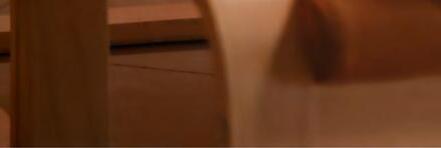




Scot t ® Scott Swimming Pools, Inc. • Woodbury, CT • (203) 263-2108 • www.scottpools.com Scott Swimming Pools, Inc. has set THE STANDARD for pool design, workmanship, and state-of-the-art technology since 1937. Selected by Discerning Builders, Architects, and Landscape Designers throughout the four-state region. May we build one for you?
Photo by Murray Engineering












































































































































































































































































































































































